-
Posts
1,527 -
Joined
-
Last visited
Content Type
Profiles
Forums
Gallery
Events
Posts posted by vaddoc
-
-
2 hours ago, michael mott said:
Just caught up Michael, the things I read are out of this world! Such a great pleasure to follow your work!
Now, I do get that copper annealed is soft and can bend, stretch and be worked easily until it work-hardens. However, from the stage above left how did you avoid dog ears and the edges folding? Is it possible to re-distribute and shrink the metal with the hammer?
- FriedClams, druxey, Keith Black and 2 others
-
 5
5
-
This is indeed interesting. I actually have been casually looking from time to time for some plans for a Uboat on the net, mainly to design the boat on CAD and take it from there but could not find any. This kit looks ideal for this purpose, photo copy the parts and use it as background template for the CAD drawings. Just saying...
- mtaylor, thibaultron, Canute and 1 other
-
 4
4
-
Welcome Reynard! Enjoy your projects and do start a log.
- Vladimir_Wairoa, Canute, mtaylor and 1 other
-
 4
4
-
9 hours ago, Captain Slog said:
I am surprised the chuck doesn't fit though. I bought the Proxxon that came with a chuck and bought the collet set separately. There may be 2 different chucks and you got the wrong one?
Apparently, the chuck can be replaced with collets but not the other way around. There are three versions of the tool, I got the one without speed control (as I have it on the power source) and the tip of the tool is different, there is no space to fit the chuck.
- Canute, mtaylor and Captain Slog
-
 3
3
-
Dear all
There do not seem to be too many information on the performance of the Proxon rotary tools and especially how they compare to the very common Dremel. I thought I d post my experience and opinion on this issue.
I got a Dremel 3000 with the flexible attachment about 4 years ago. It recently failed and I bought a Proxxon Micromot 60.
Now, in my opinion the reason the Dremel failed is actually a design and material fault. It has a locking pin so that the shaft will not rotate and the jaws can be unlocked. This is however very shallow, engages the shaft maybe less than 1 mm and the pin is not hardened-nor is the shaft. So it is a matter of time to get worn and then simply the jaws cannot open. Replacement is £15 in the UK. I was actually given a replacement locking pin but after installing it the whole assembly is a bit worn so it does not work very well and cannot take much pressure and even the new pin slips. Better to buy a whole new unit at £45. In regards to the flexible shaft, personally I did not find it useful at all.
Some pictures now.
The most common complaint is that you absolutely have to buy the Proxxon power source. I already had it so buying the Proxxon made sense. Now, the Proxxon is smaller and lighter. It only needs finger tightening whereas the Dremel needs a small wrench-this is actually important. The Dremel goes up to crazy speeds but due to lack of torque it slows down. The Proxxon seems to have a lot of torque and does not slow down-less vibration as well but only goes to 20,000 rpm or so and it is more pleasant to use.
This is the locking pin that commonly fails. It is tiny. I have not seen the pin on the Proxxon but it seems to have much longer travel and be more robust.
Actually, I installed the new pin and tried to unlock the chuck. I did not operate the tool but just by trying, the pin already got worn!
Another piece that got worn is the part that compresses the collets as well as the wrench.
The collets are also different. The Proxxon ones are larger, harder and have three jaws. They look and probably are better but I have had no issue with the Dremel ones.
Overall, the Proxxon seems to be the nicer tool but is more expensive. Proxxon also makes a 220 V version that seems pretty good and more powerful.
The Dremel may be better for DIY but for modelling, this Proxxon tool is very nice.
Ona final note, I bought the Proxxon chuck to replace the collets but apparently it cannot be fitted on this tool-shame
Vaddoc
-
-
-
A bit more progress so another short post.
All the planks so far have been difficult to make, mainly to the significant twist the wood had to take. This twist makes the plank to deviate so getting an accurate template is difficult-the slightest degree of edge bend will cause problems.
The next plank I hope will be the last of the tricky ones. Indeed, it took many attempts to get card patterns that looked ok but there was no waisted wood-I got both sides with the first try. I think I am getting better at it!
This is the paper pattern that defines only the shape of the one (bottom) edge. Many more followed to fine tune the shape
The plank cut and dry fitted. I was concerned how it would fit with the previous vertical plank but actually this was not a problem.
This plank again is very straight, so far the initial planning of the run of the planks seems to be ok. Now, this plank is 60 cm long, in the actual boat it would be a 6 m plank. I am sure though that stock 6 m long and 20 cm wide should be available. Otherwise the planks would have to be scarfed.
Then I made the other side. The two planks are not identical!
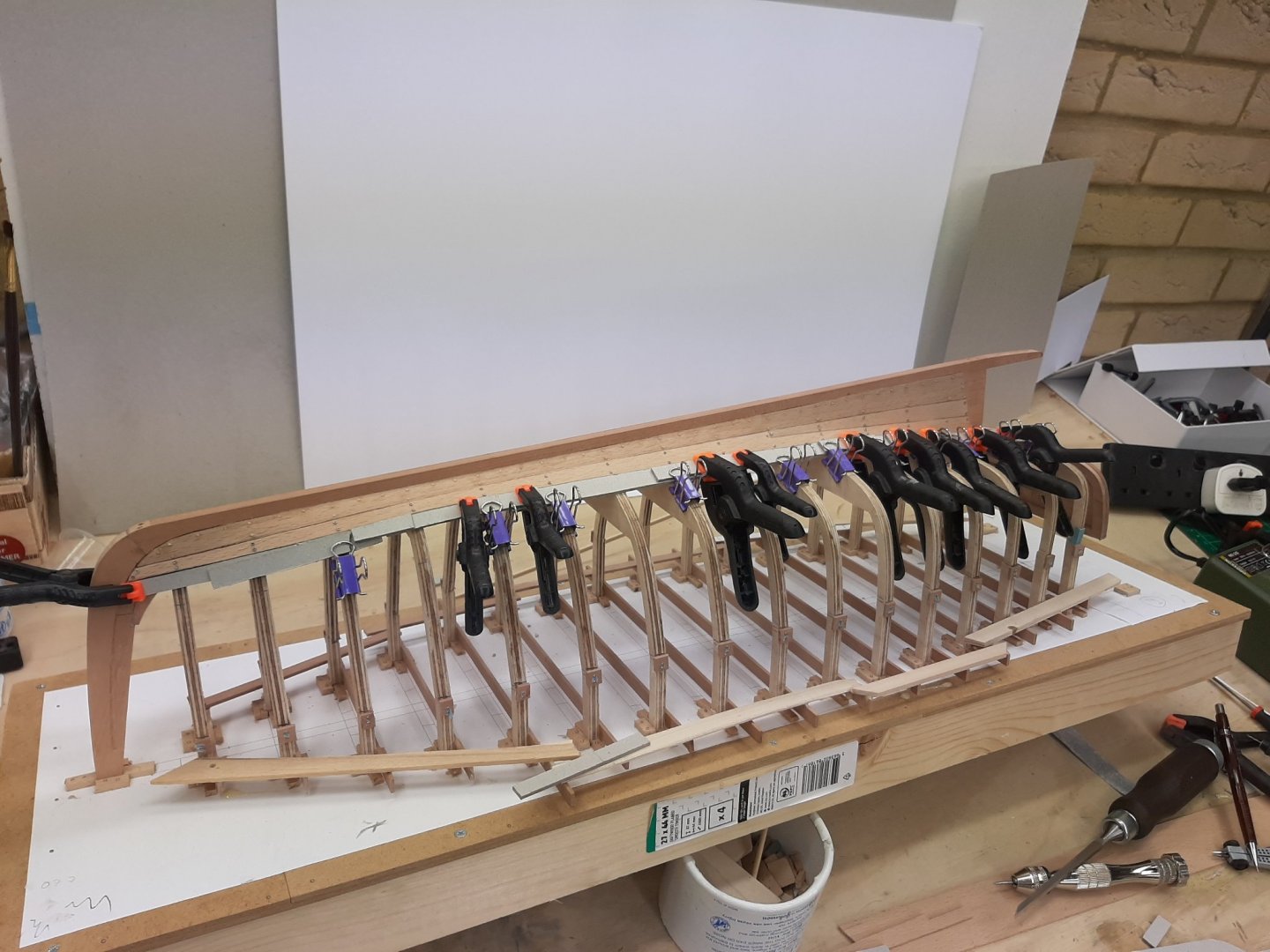
Then both planks were steamed and clamped in place. There are a couple of planks that seem a bit low and do not touch the planks well. The 2 mm planks are so stiff that easily show the problematic areas. Maybe they will need shiming-maybe not
The fit at the stern looks pretty good. I really expected this area to cause massive problems, I guess Chapelle knew what he was doing!
Now, I decided not to screw the planks immediately because I noticed that the gaps between the previous two planks have widened. I guess Noel and Wefalck were right to raise concerns. This will be sorted with some filler.
This time, I got the bow heights right
This photo however raises another issue. At some point, I will need to taper the stem. From the keel up, it will progressively start to get more narrow , following the angle of the planking. I should have probably done it earlier, at least to take the bulk of he wood off.
I am not sure whether to do it now or later. To remove so much wood, sharp chisels but also rough handling will be needed. Maybe do it after planking, when the boat will be very stiff but then I will need to be vey careful not to mark the planks. Maybe a middle way would be to keep using screws so that any damaged plank could be replaced.
I d really be interested to hear your thoughts on this!
Vaddoc
-
32 minutes ago, KeithAug said:
is very engaging if not a little daunting.
Thanks Keith! It might seem complex but in reality Carvel planking just needs patience and batens. Clinker will need a bit extra head scratching but more later on, when the planking of the Yawl starts.
29 minutes ago, wefalck said:Just realised, that I had made the same comment already earlier on. Apologies for the repetition ...
Not to worry Wefalck, it is great that you all are on board on this journey!
-
This is wonderful model GL, congratulations! I think the worse is behind us, we ll find a balance soon.
An Ancre monograph, this sounds very exciting. After you ve tied the loose end of course...
-
2 minutes ago, wefalck said:
leaving them a tad longer and wider for the purpose
Indeed Wefalck, this is what I intended to do, leave the planks wider to allow me to do fine adjustments and create bevels, so that the planks would touch edge to edge despite the angle. In practice, this is very difficult to do even at 1:10 scale-at least for me.
However, what I do do is sand the high spots on the edge that meets the previous plank so that they meet better, but also sand the other edge to create a fair curve with as few high and low spots as possible-this makes fitting the next plank easier. I forgot to do this on the garboard though.
- FriedClams and michael mott
-
 2
2
-
54 minutes ago, noel_colledge said:
just a thought, has your steaming process caused your timber to expand, and therefore give you your new fitting issues
Hi Noel
I do not think so. Indeed, there can be a large difference in width (negligible on length) between wet and dry wood, I ve seen 20% quoted for some woods and the Wood database site mentions that beech has high movement in service. However, one thing that impressed me is that the wood comes out of the steamer hot and pliable but very quickly cools down and actually feels very dry to touch-this takes seconds. Very different to soaking beech in water, the wood still becomes pretty pliable but is soaking wet-dries quickly but takes a few minutes. In any case, the wood is cut to template when dry and is tested on the boat when it dries after steaming-its me template that is wrong.
The fitting issues are caused by the card paper that slightly edge bends, even 1 degree will create huge gaps in a 60 cm plank. Also the width of the paper template is important-too wide and the paper will sit at a different angle on the frame, causing the plank to deviate.
Ideally, I would like to use 0.8 mm plywood but it will be too expensive.
Thanks for visiting!
Vaddoc
- KeithAug, michael mott and FriedClams
-
 3
3
-
The led paint is a great detail Hakan!
-
-
Ok, so both planks got steamed positioned into place.
Definitely worth doing, they now follow the hull much closer. The next photo does not capture it well but the plank really has taken the shape of the hull.
However, this means that their dimensions changed slightly. Because they sit closer to the hull, they appear slightly longer so a tiny bit of sanding at the bow end was needed. However, after I had pretty much finished screwing the planks in place, I realised that the bow end in both sides did not fit well.
I cannot explain this, before steaming they were both pretty spot on. I guess this is something I ll have to live with, maybe the filler will make it look better.
Now, another issue was the bow end of the planks. Clearly they do not end up at the same height.
So the plank came off, sanded and re installed-this is prior to final screwing. It is better now
Another area that needed attention was the joint with the stealer. In both sides the plank was sitting too low
So I used a very thin shim of wood and things improved
A few photos of the hull as it is now
So far so good but now there is a new problem. This is actually something I had been concerned about even when I was lofting the boat on CAD. The next plank at the stern will lie horizontally but somehow will need to mate with the previous plank that lies vertical. This is the reason that I have not glued the planks so far, so I can remove if needed.
So, I just put a piece of card to check things...interesting.
This will need wood for the template, not card.
Regards
Vaddoc
- G.L., FriedClams, KeithAug and 5 others
-
 8
8
-
Brian, indeed a treat to follow your build. Wonderful work! Looking forward for the rest of the journey.
- mbp521, mtaylor, Keith Black and 3 others
-
 6
6
-
Many thanks to all for your comments and likes!
53 minutes ago, G.L. said:Why will you steam the planks before installing them? It seems to me that they follow nicely the flow of the frames like this.
GL, the planks will accept to be bent up to a point but will not accept to be twisted. This is 2.2 mm beech, a hard and sturdy wood. This plank as well as the garboard has a lot of twist, this is why all these clamps are needed-still the plank does not sit well, it lifts in the middle. Also, I do not trust the frames too much, the plywood proved a poor choice and actually I should have used more frames but I cut corners a bit. I d like to have as little pressure as possible.
Even wetting the beech will drastically improve its response to bending/twisting but since I have my steam box ready to go, I ll steam the wood thoroughly-it will bend like made of dough!
- bruce d, michael mott, G.L. and 1 other
-
 4
4
-
Bruce thank you for your kind words, it is certainly worth it.
After countless attempts, the starboard plank is done but I am a broken man!
I ve never had such difficulty producing a plank. It is however a very complex shape and due to the twist along its axis both at the bow and stern, even tiny changes in the shape or even the width of the plank, bring on massive changes to the fit.
Some photos to show the end result-both planks were difficult but the starboard one almost defeated me. The planks can be edge bent a little so the gaps will close further.
That was more than enough for today. Tomorrow I ll steam the planks and install them again with screws. The reason is that while this plank finishes vertical at the sternpost, the next one will finish horizontal an the transom so at the stern, the two planks will meet at 90 degree angle. Maybe some adjustments will be needed but I will not know until I start work on the next plank.
Regards
Vaddoc
- Moab, Wintergreen, GrandpaPhil and 7 others
-
 10
10
-
Time for another post, unfortunately not a lot of progress as I run into difficulties.
Moab and GL thank you for your kind words, a pleasure to have you on this journey!
After infinite trouble, I managed to produce a half decent port plank. I think I made 3 templates and 4 planks, thankfully the last one was acceptable.
This is by far the most difficult plank. It has a significant twist, it needs to fit with the stealer, it is long and narrow towards the bow and it is very easy for the paper pattern to distort. But I also now need to make the starboard one.
Again, I immediately run into the same problems. After a few failed attempts, I decided to use 2 mm thick cardboard and then to use shorter segments. Finally, I ended up with a promising template.
I marked the other edge of the plank measuring from the sheer, to make sure one side mirrors the other. This is the outline of the plank on the sheet. Incredibly, it is almost identical to the port plank
Ya...right. It did not fit!
This is properly difficult. Another issue is that despite using a very sharp knife, the blade still follows a bit the grain so the cut edge is a bit wavy. Honestly, I believe that cutting a full scale plank should be easier.
So, I ll use this failed plank to make a new pattern and try again. I am a bit concerned I do not have enough wood, provided my next attempt will be successful I will have used a whole 100 x 1000mm sheet to make just two planks. However, the rest of the planks should be easier to make.
Vaddoc
- G.L., BobG, GrandpaPhil and 4 others
-
 7
7
-
I must confess I am having too much fun! Risking the Admiral's wrath I did some work today.
First I installed the two stealers. The port plank I steamed and fitted was a rejected version, somehow it sneaked in and replaced the correct one. I realised this and found the correct plank on the work bench. I just soaked it in water for a few minutes and then the plank easily bent into position. I just temporarily screwed the planks in place in case they need to be removed to deepen the rabet.
Next, I started making the template for the first broad strake.
I was very careful not to edge bend the paper. Again, I am only interested in the upper (bottom) edge that meets the garboard and stealer, the other edge will be defined later. This was the result. The plank is 55 cm long - they will get much longer.
Note that the plank is almost straight, as were the garboard and the stealer. So far the initial planning of the planks seems to be working.
Then, I measured and transferred the distances at all stations and connected the dots with a fair curve. I also cut the paper template to roughly the shape of the plank, I think it looks ok.
It is 23:00 in England so I called it a day, cutting planks is a delicate job. I should have ordered twice as many beech sheets, I was very conservative in my initial estimate of the wood needed, there is the potential for a lot of wasted wood.
Vaddoc
- BobG, KeithAug, FriedClams and 4 others
-
 7
7
-
- Rob S, thibaultron and mtaylor
-
 3
3
-
Looks fantastic Hakan. This dark shade really lifts the model, I like it a lot. You could consider using treenails for those stringers, would be more secure and easier than glue.
Now, if I could take a guess, is your next boat a pilot cutter?
-
Some more work done, time for another post.
I installed both garboards, even after steaming some pressure was needed to get them fully into position. Initially I used 1 mm screws to keep the planks in the correct position and then gradually replaced with treenails. I had to deepen the rabet, at places quite a lot. I am not too happy with the bow end of the port plank, it should be spot on but now there is a bit of a gap. Oh well, a bit of filler never did any harm!
Then I moved on to the next plank which I think should be the stealer.
So, first a defined the shape that the first broad strake should have. This plank, up to a point, it follows the edge of the garboard but at some point it deviates and this is where the stealer starts. The stealer will not have a pointy end but a square one which will sit within the first broad plank. So things should look something like this:
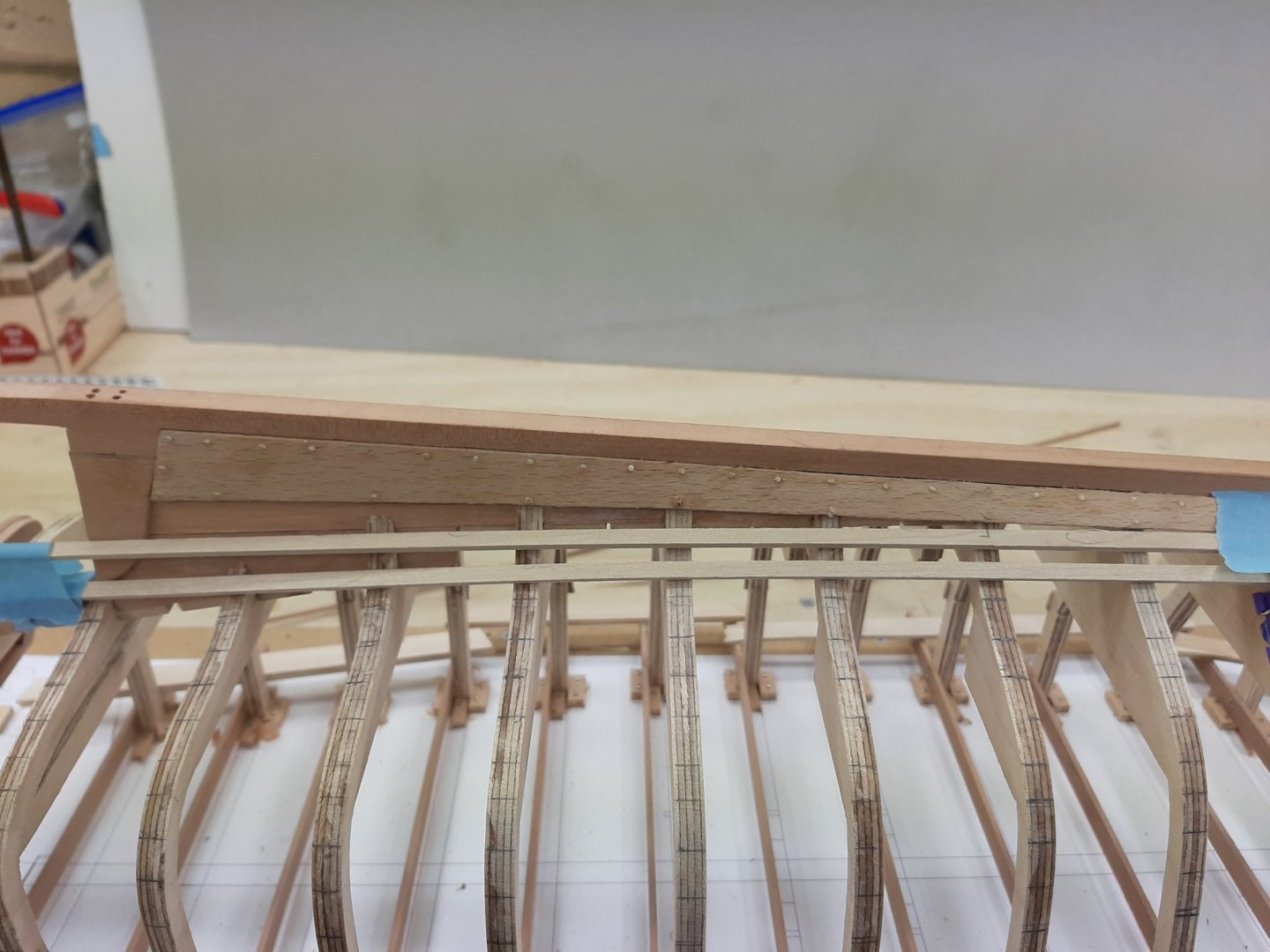
The position where the two plank ends meet should be here
Then I laid a baten to define a fair upper edge for the stealer
However, when I cut the plank template it does not look right. It seems it needs shortening by one frame.
So that is what I did. It looks much better now. I had to make sure that the first broad plank, which now will be longer, will not be too wide for the curve it must negotiate but it looks fine.
Ten I cut the stealer. With a bit of adjustment, it fitted fine.
Now, at this point I was curious whether this plank would fit on the other side. It should, as the upper edge of the garboard should be finishing at the same point at all frames in both sides. Well, it does!
Then I made the other stealer which also came out fine
So all looks good so far. However, today I remembered some more planking tricks and tips. It is coming back to me as I progress.
After the plank is cut, minor adjustments can be done by scraping the edge of the plank with the knife. It works like a plane. But also, again using the knife as scraper, the other edge of the plank needs to be "planed" into a fair curve to make it easier to mate with next plank without gaps. Further more, the plank can be cut with the scroll saw to just out of the line and then with the knife plane down to the line. For this to work, very sharp blades are needed so I change mine very often.
Regards to all
Vaddoc
- GrandpaPhil, oneslim, Wintergreen and 3 others
-
 6
6
-
Jim and to everyone that hit the like button, many thanks! I think time for another small post.
I ve been thinking how to attach the planks to the frames, for the Yawl I ll use threaded brass wire but I do not think this will be possible for this boat, I do not trust the plywood frames to hold the threads securely. So I am thinking of using treenails, like I did with the Deben. I think I ll need 1500-2000 (including wastage) for the outer planking alone so I sat down to make them.
I used the needle method, in the past I ve made many thousand of treenails. I used a small log a friend gave me a couple of years ago, I am not sure what tree it came from, either hawthorn or hornbeam. It is a hard and strong wood though. It took a while to make things work, I kept burning the wood but with a bit of trial and error I managed to get things working.
I cut thin discs and drilled the tree nails. Then I sanded the back and released the nails. The heartwood was very hard and the sapwood at areas seemed to have deposits that clogged the needle.
I was not too happy with the first bunch, they were quite short. I sorted the nails according to colour, I ll use the lighter ones that are more plentiful. The darker ones are from the heartwood, denser and stronger but even the lighter ones are very strong. In the next photo they don't seem a lot but actually they are more than 800.
Then I sat down and made a few more, this time longer and better. This time I made close to 2000, so I should have enough to start planking.
So time to steam the planks! The garboards are the more difficult to fit, the twist of the plank is significant and really the clamps are difficult to be positioned securely.
My steamer worked brilliantly and despite taking a long time to fit the plank so that it cooled down halfway through positioning, it accepted the twist just fine. I need to deepen the bevel in a few areas but otherwise I am happy with the outcome.
Tomorrow if possible I ll nail the planks to position but I need to think of a way to make sure all the nails align across all planks and that are spaced equally.
Vaddoc
- michael mott, G.L., mtaylor and 6 others
-
 9
9


.thumb.jpg.6fd4c1b78768bb3efd745ab810936005.jpg)
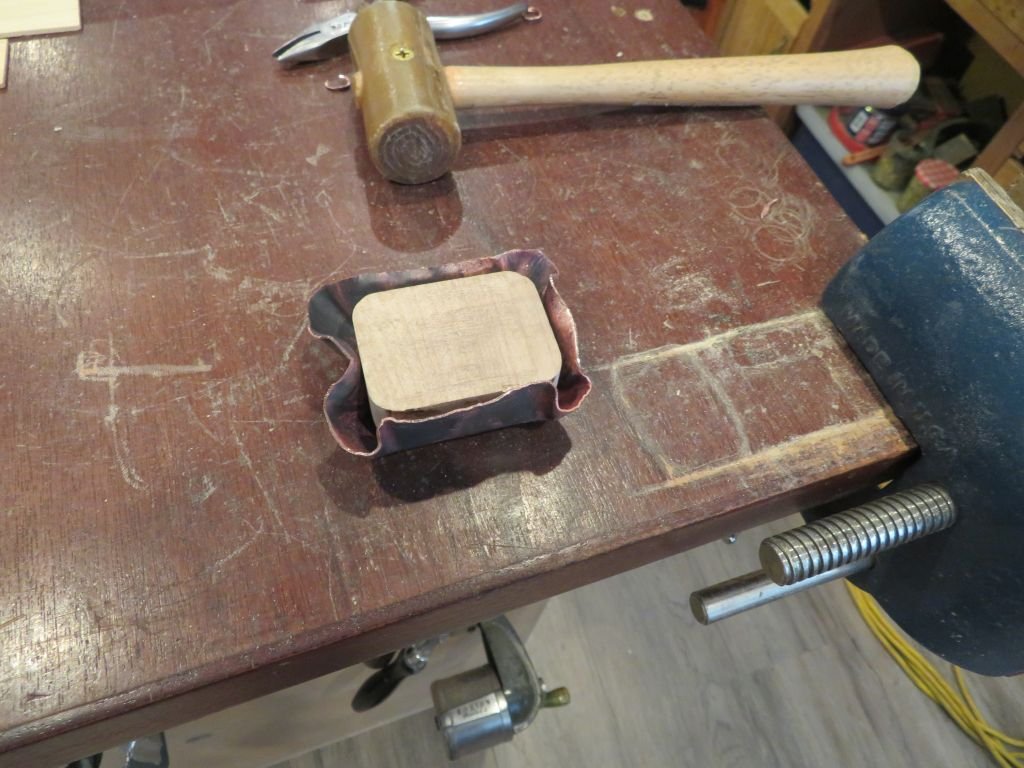
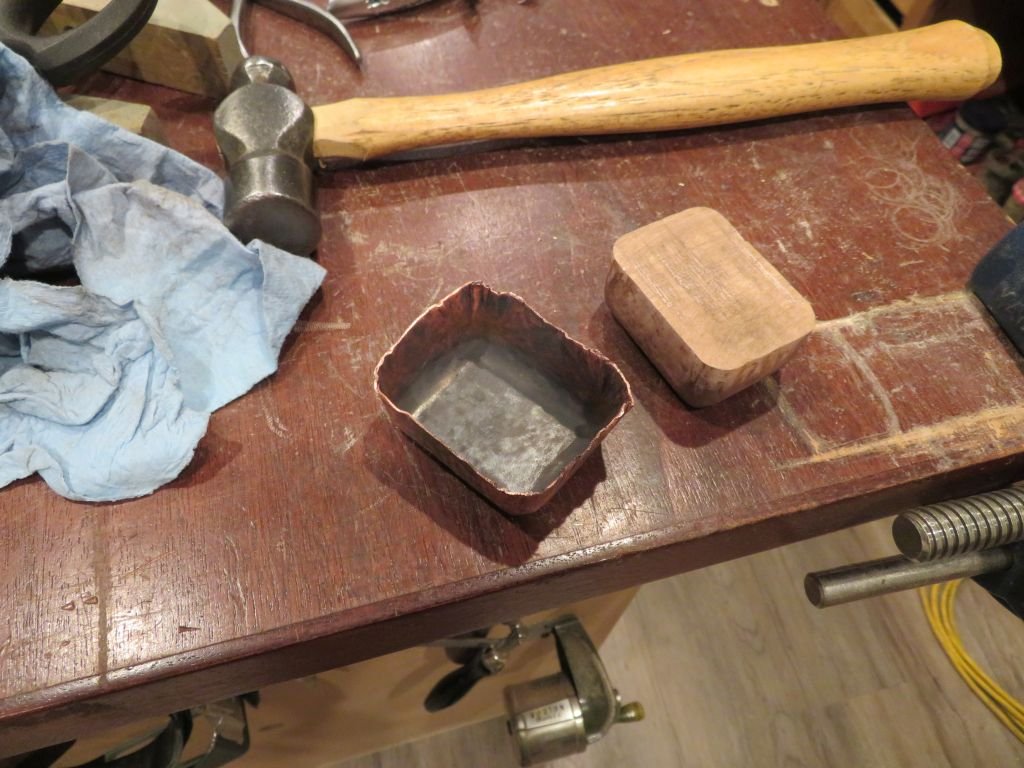
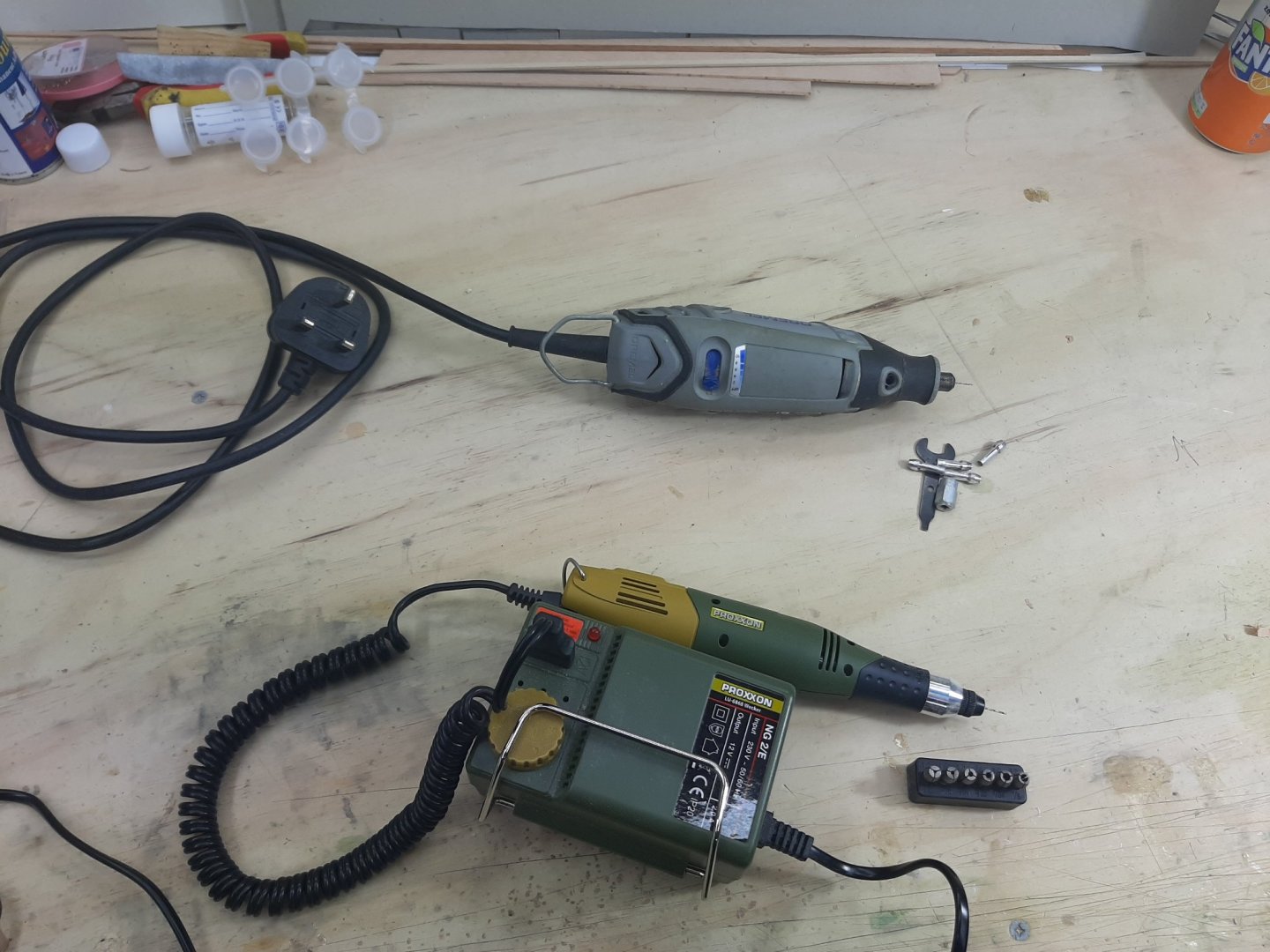
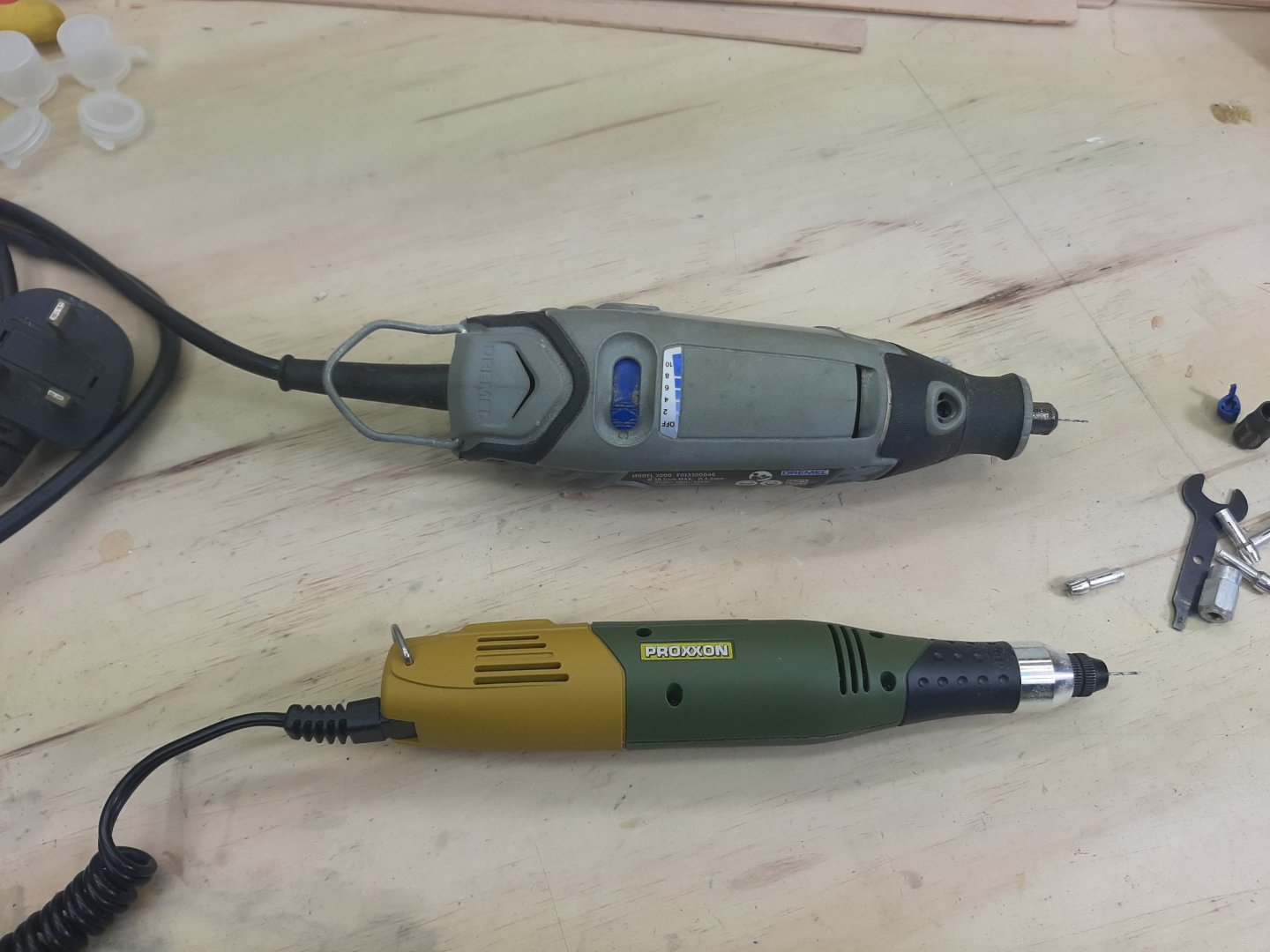
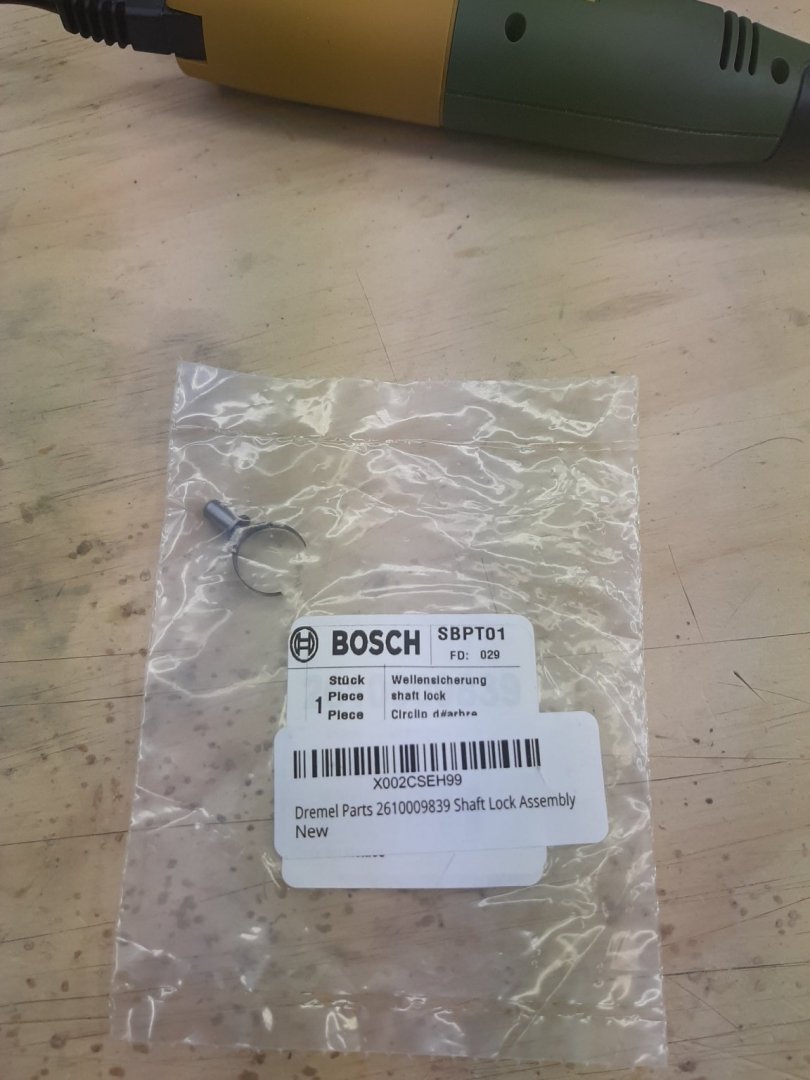
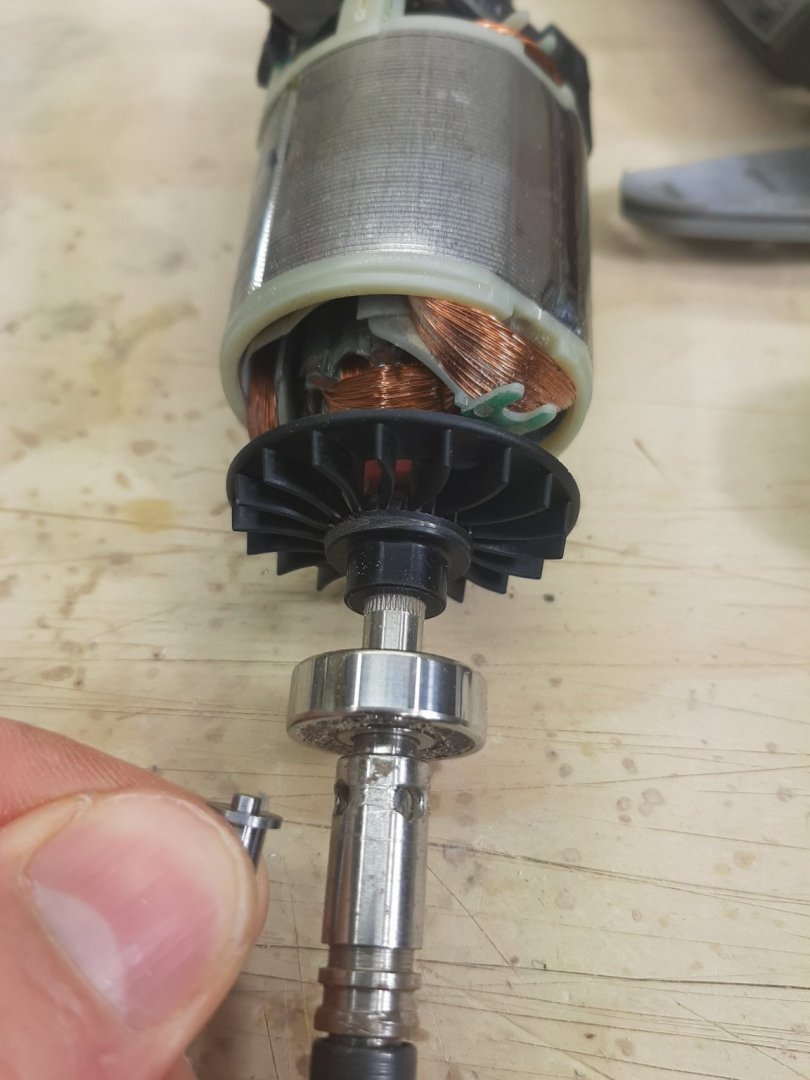
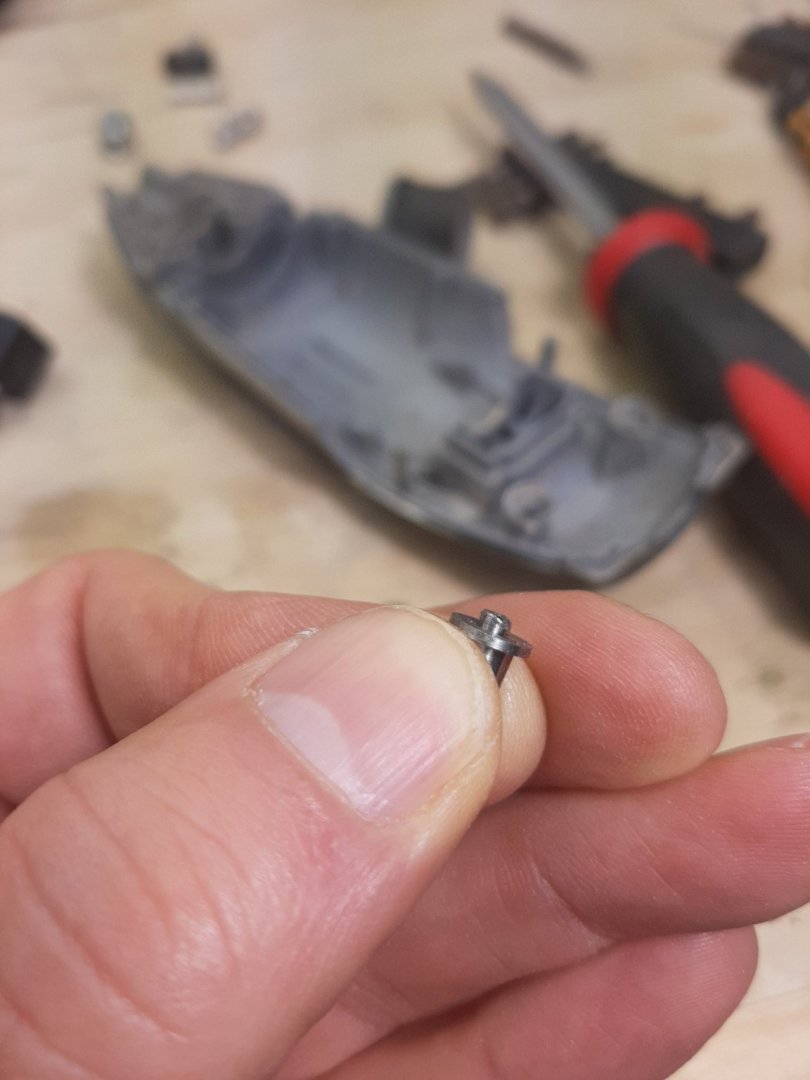
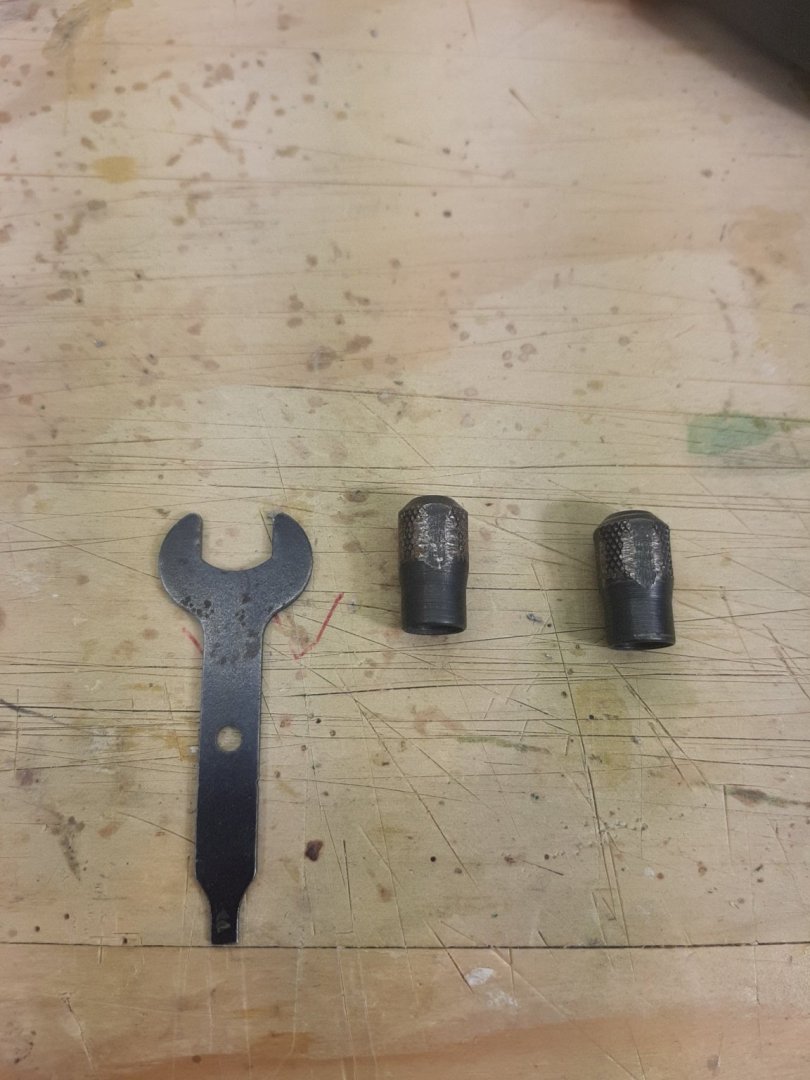
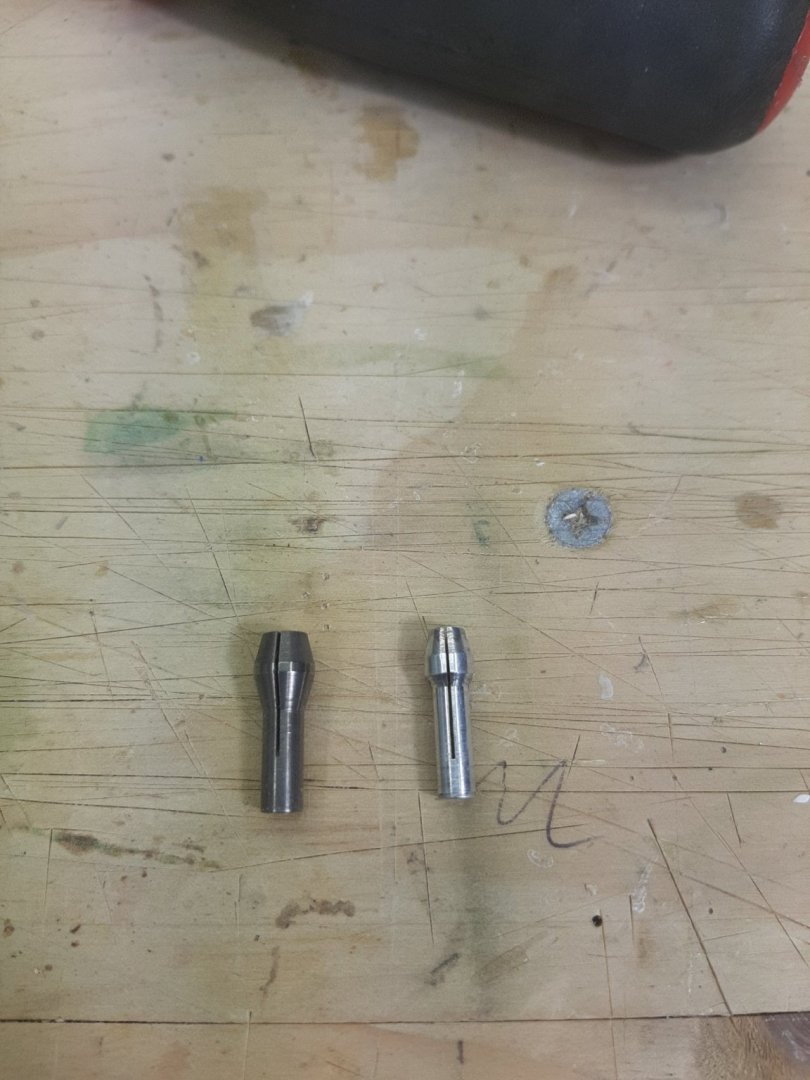
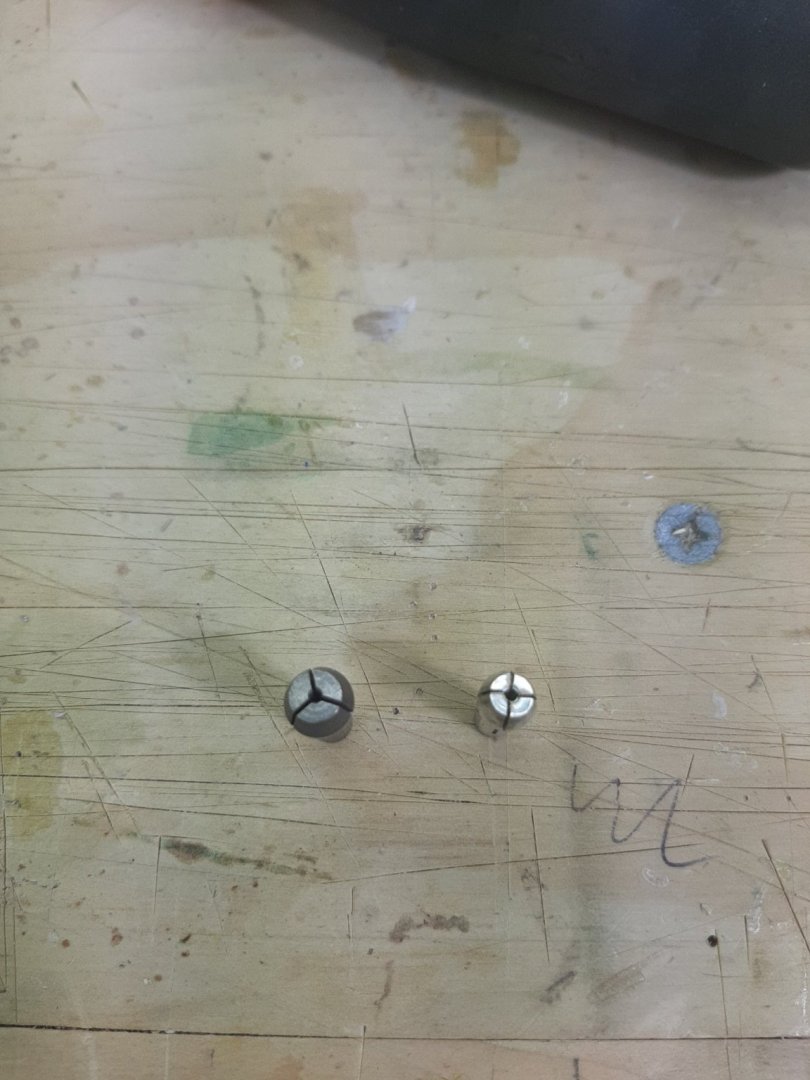
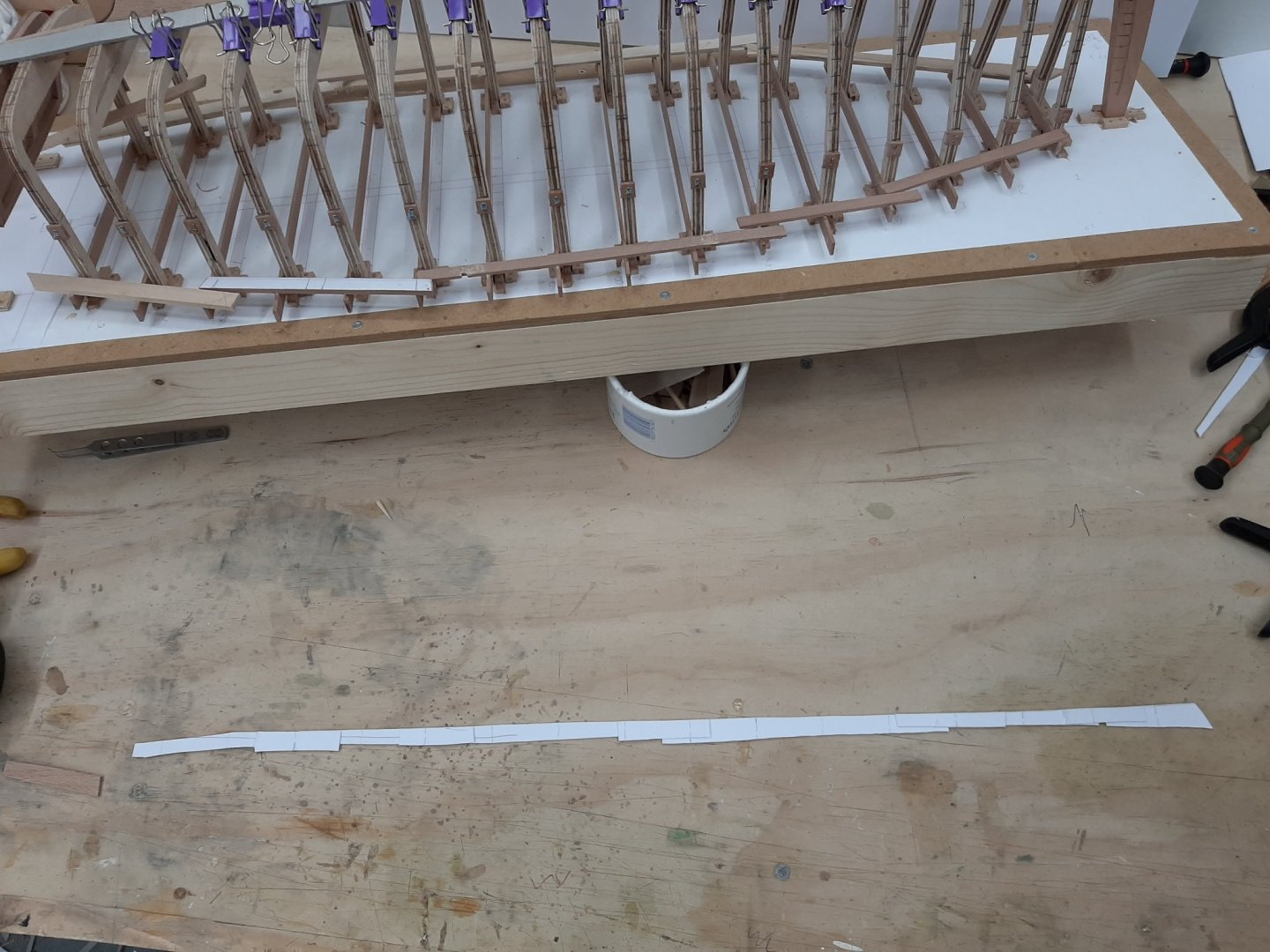
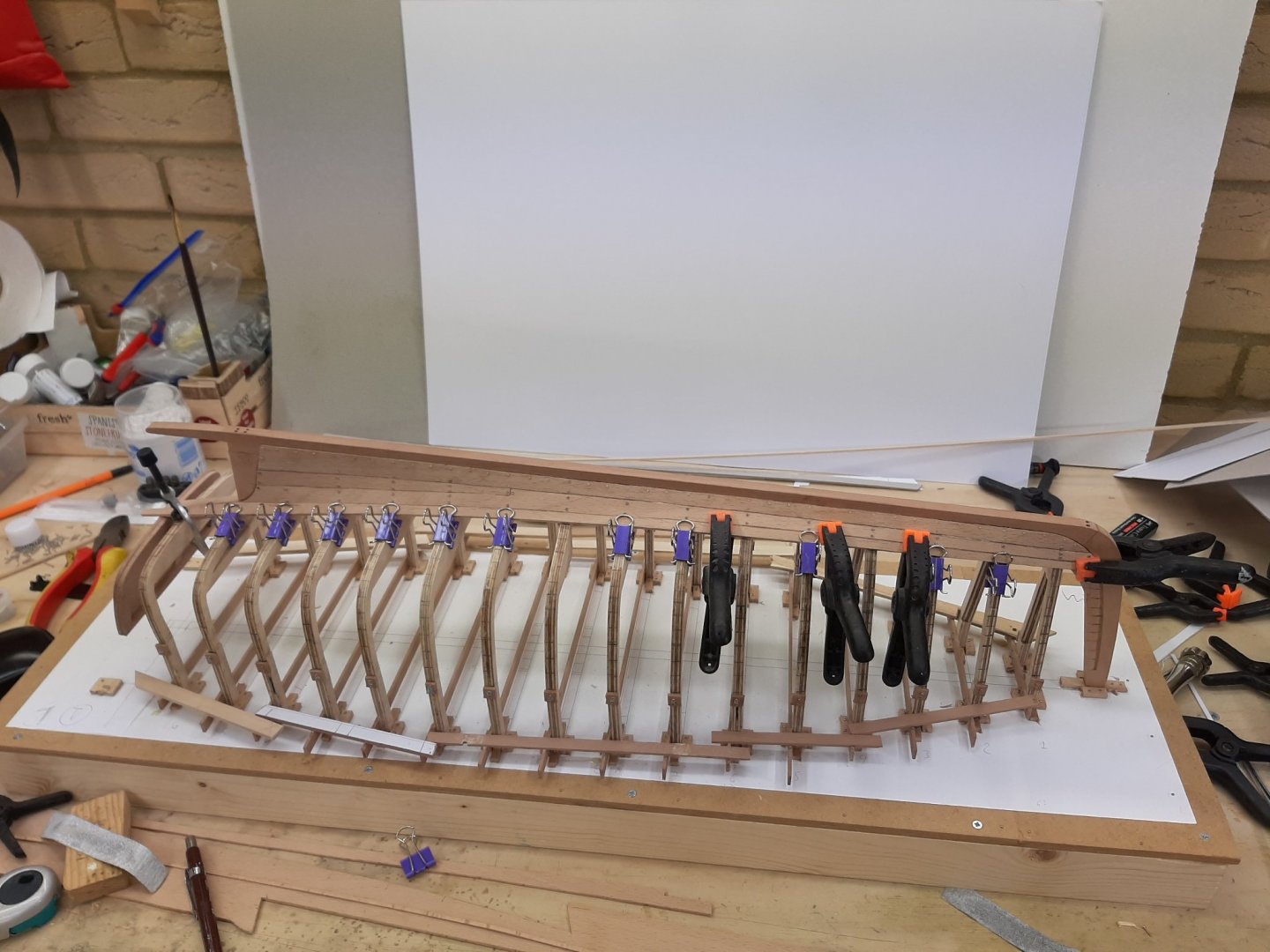
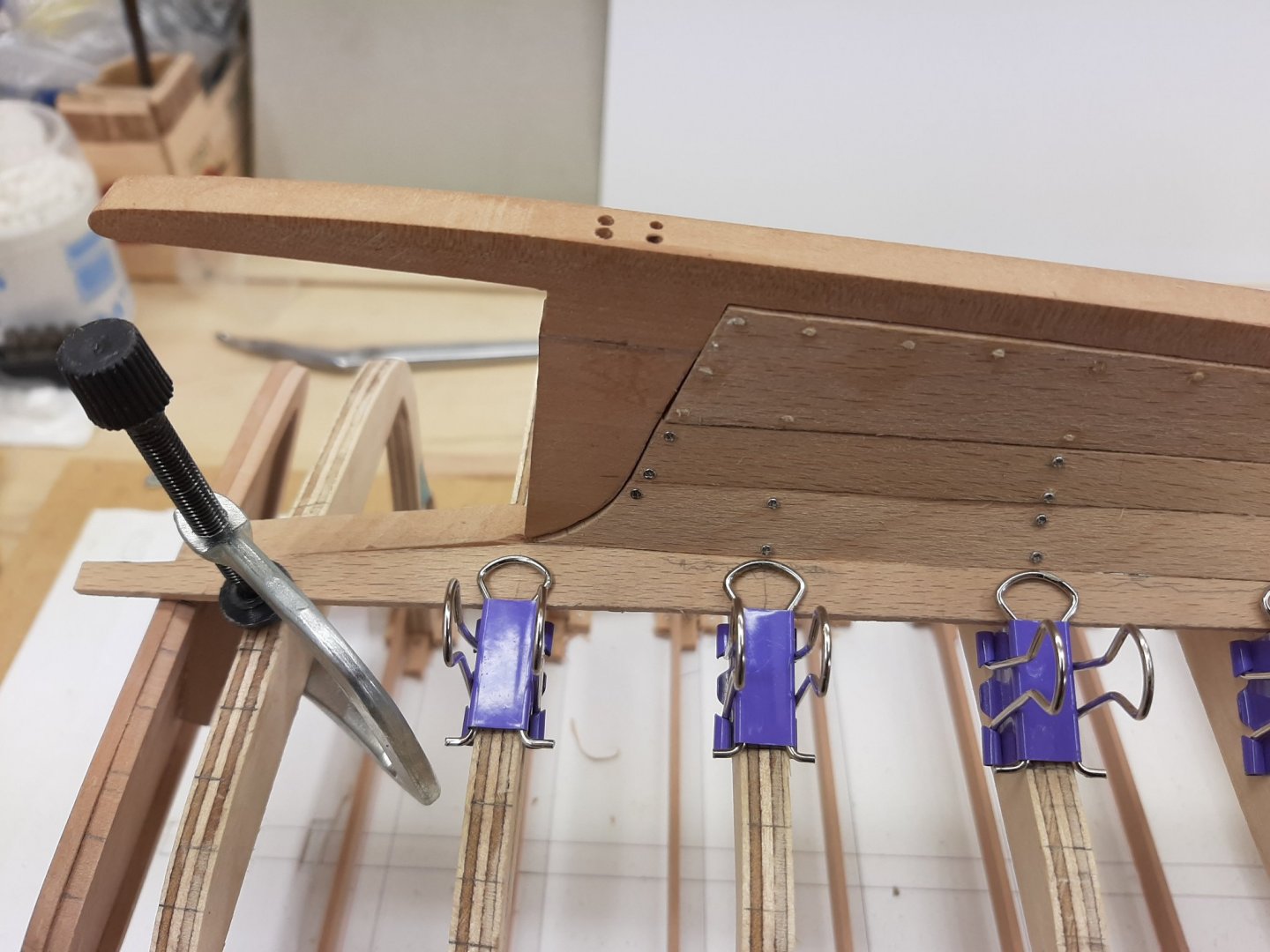
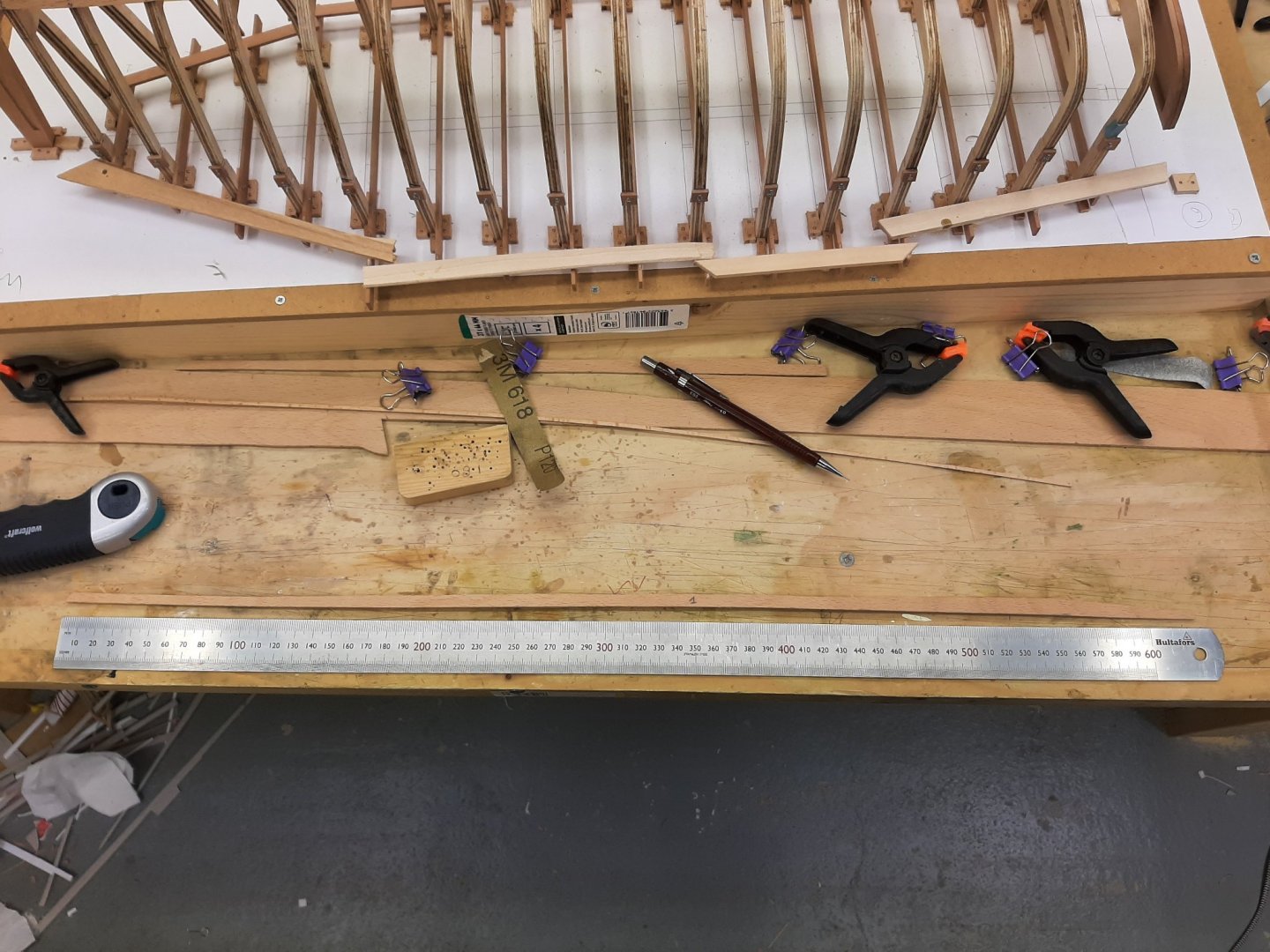
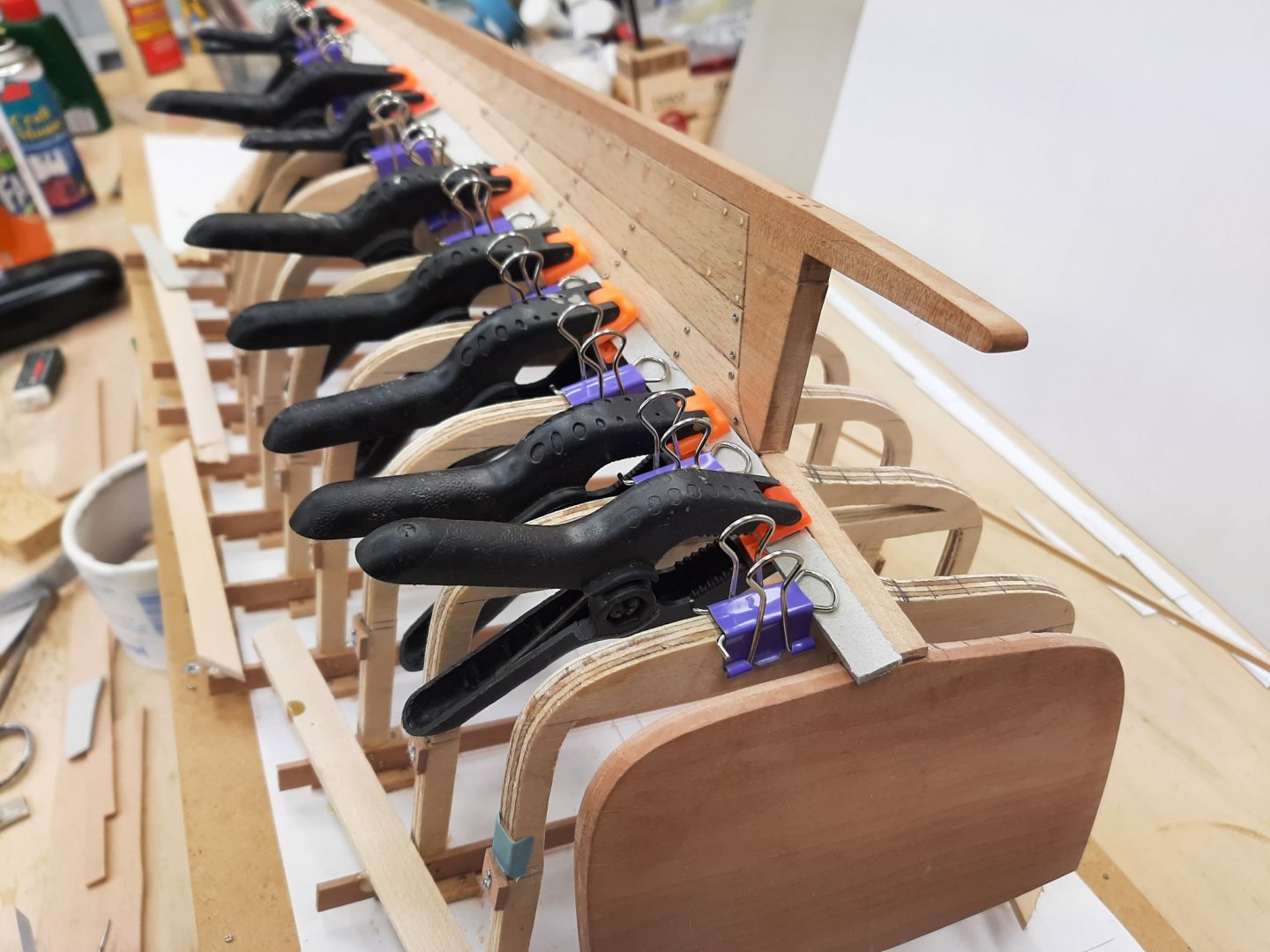
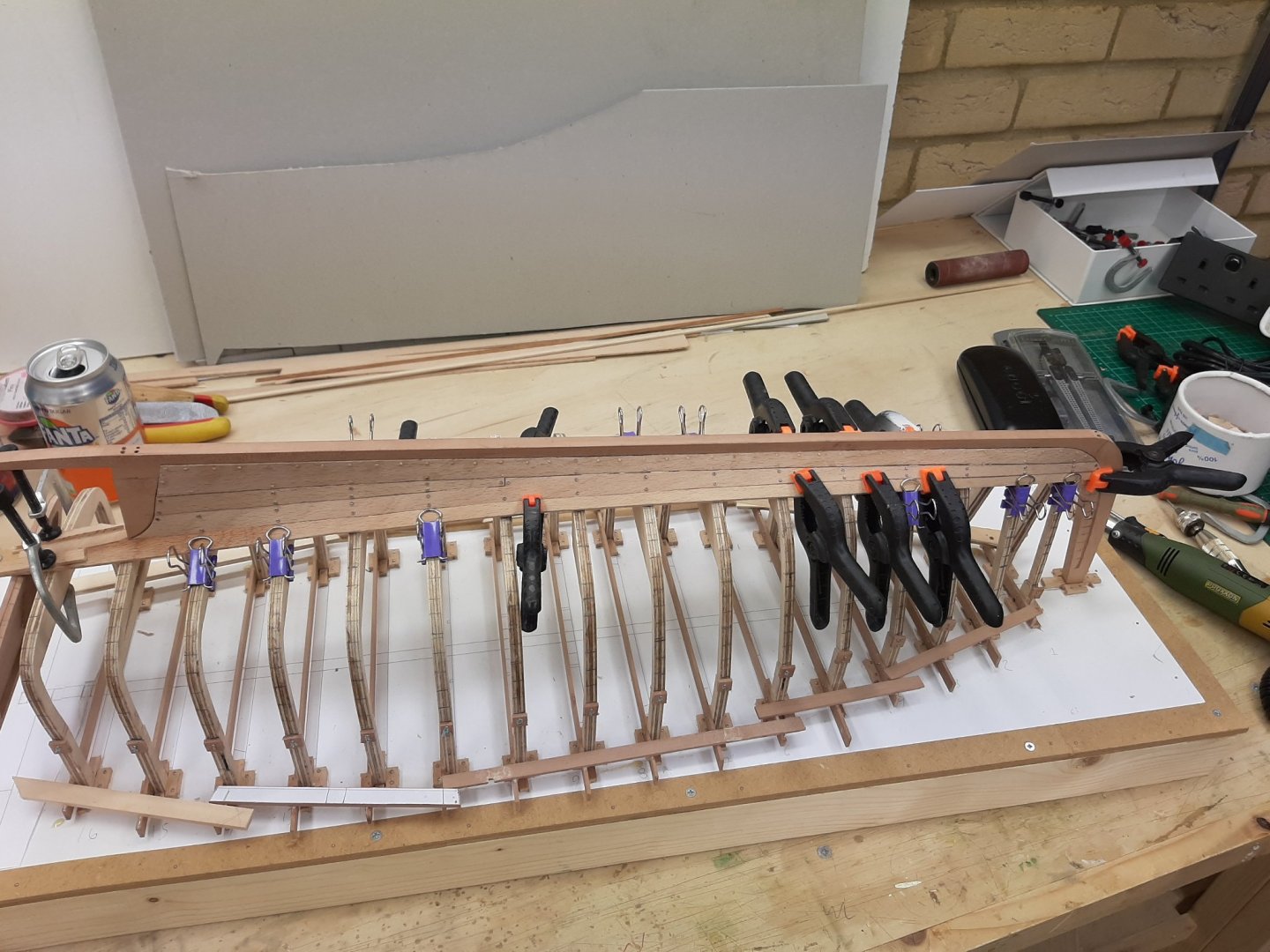
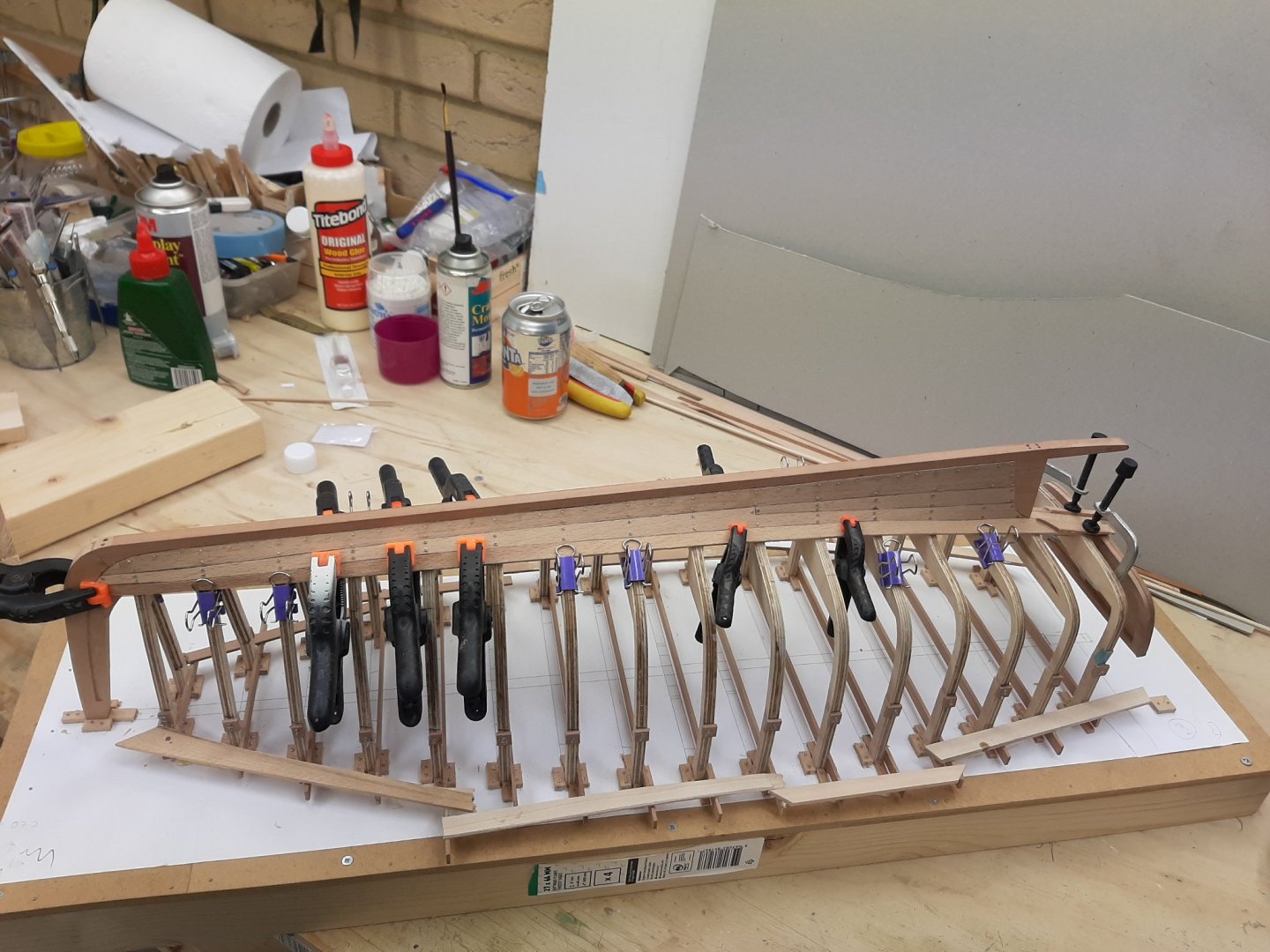
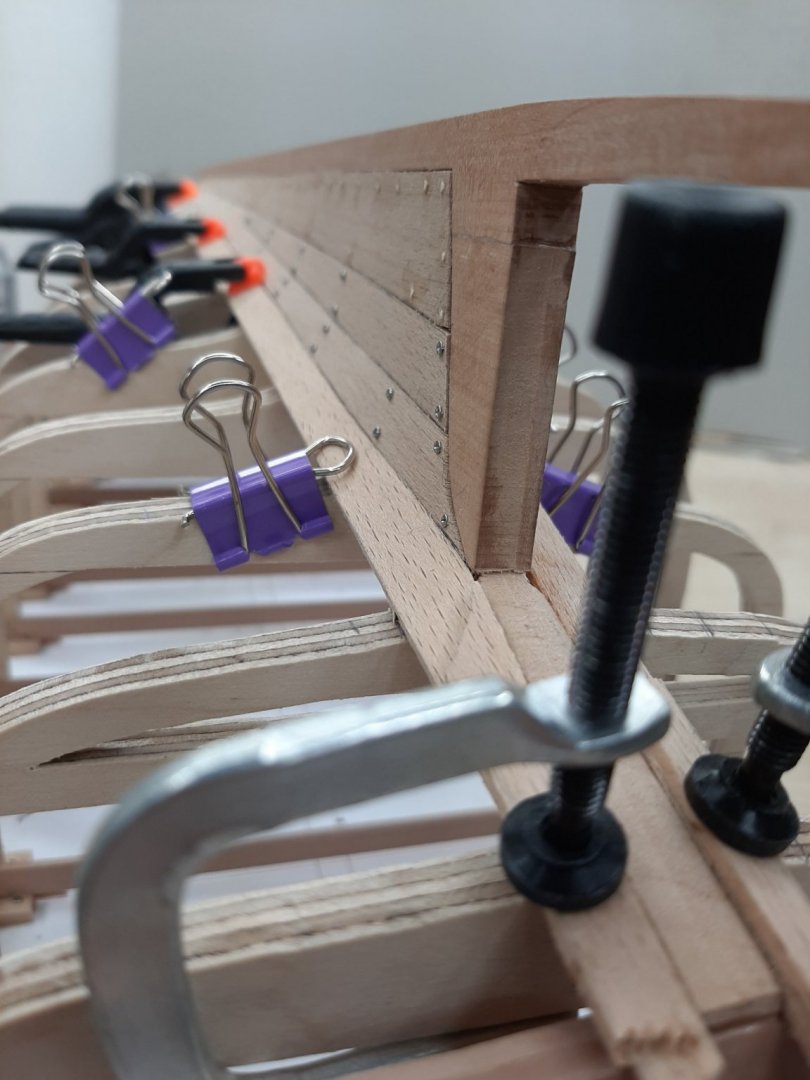

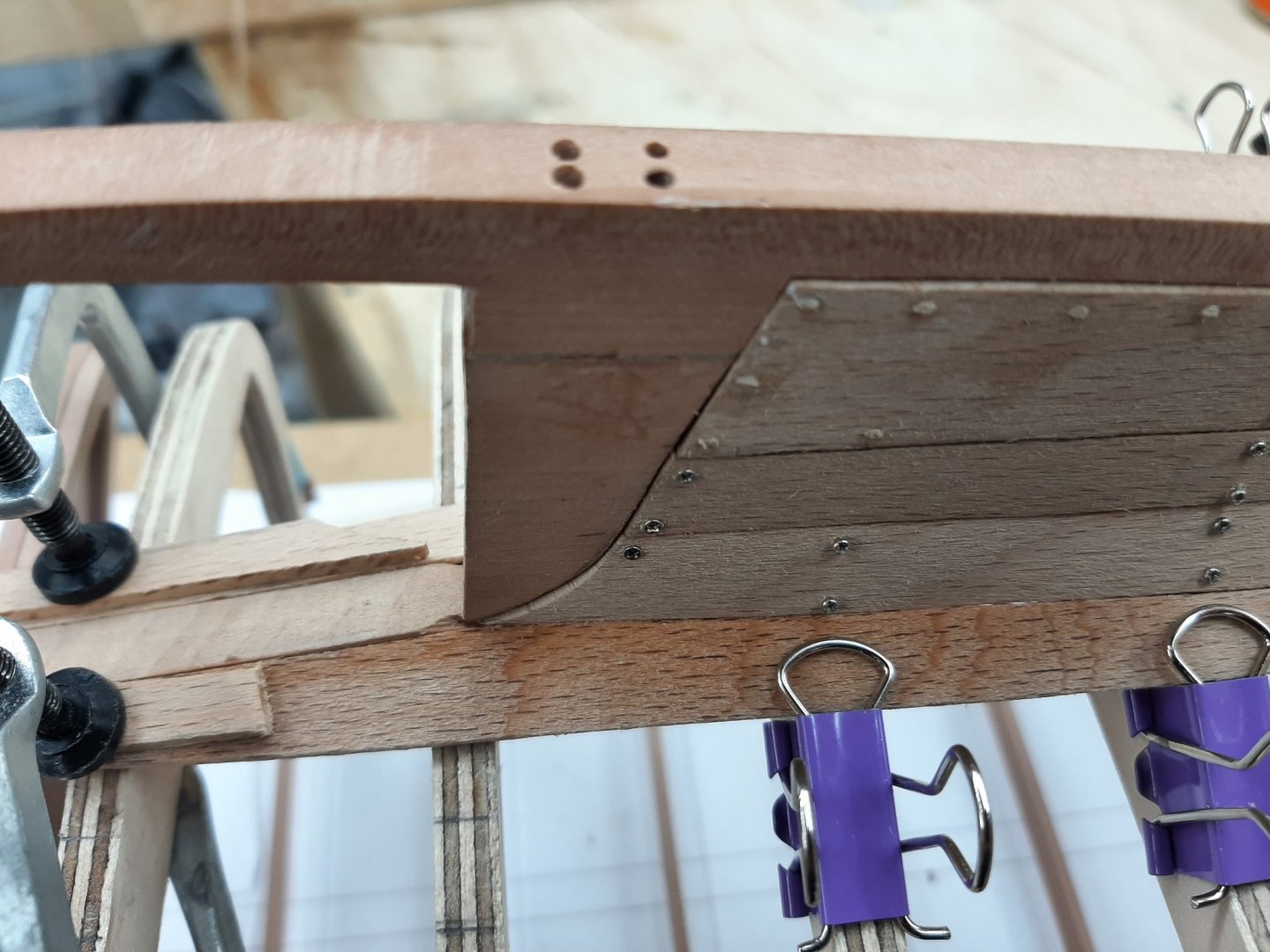
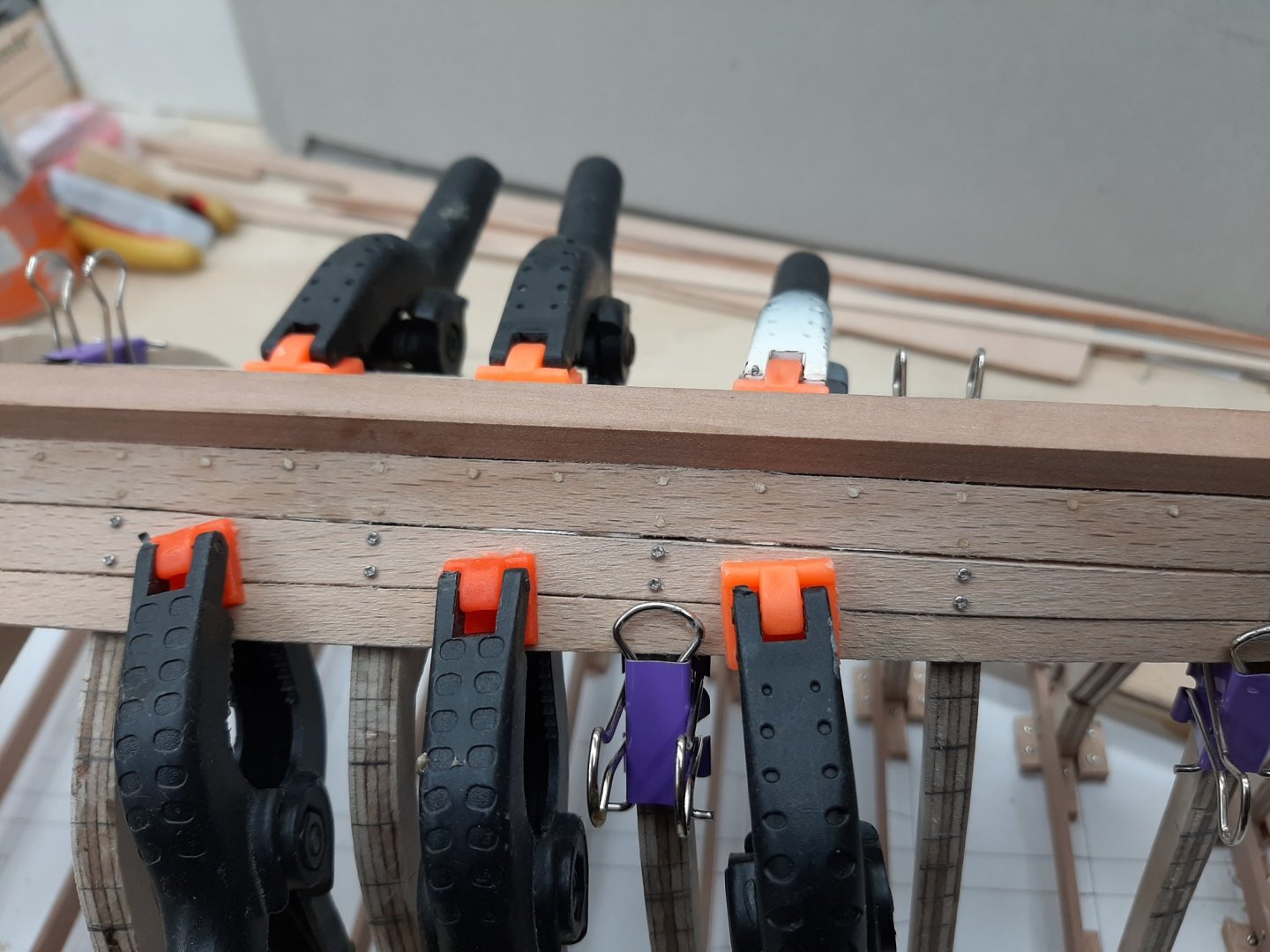
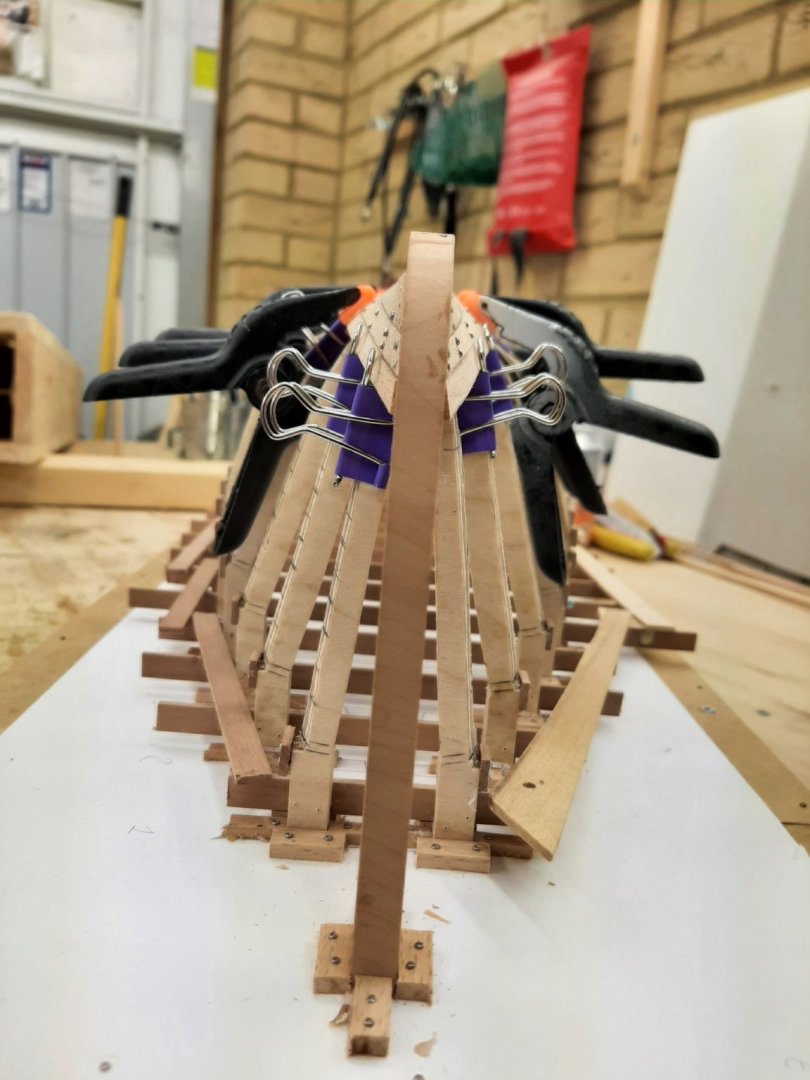
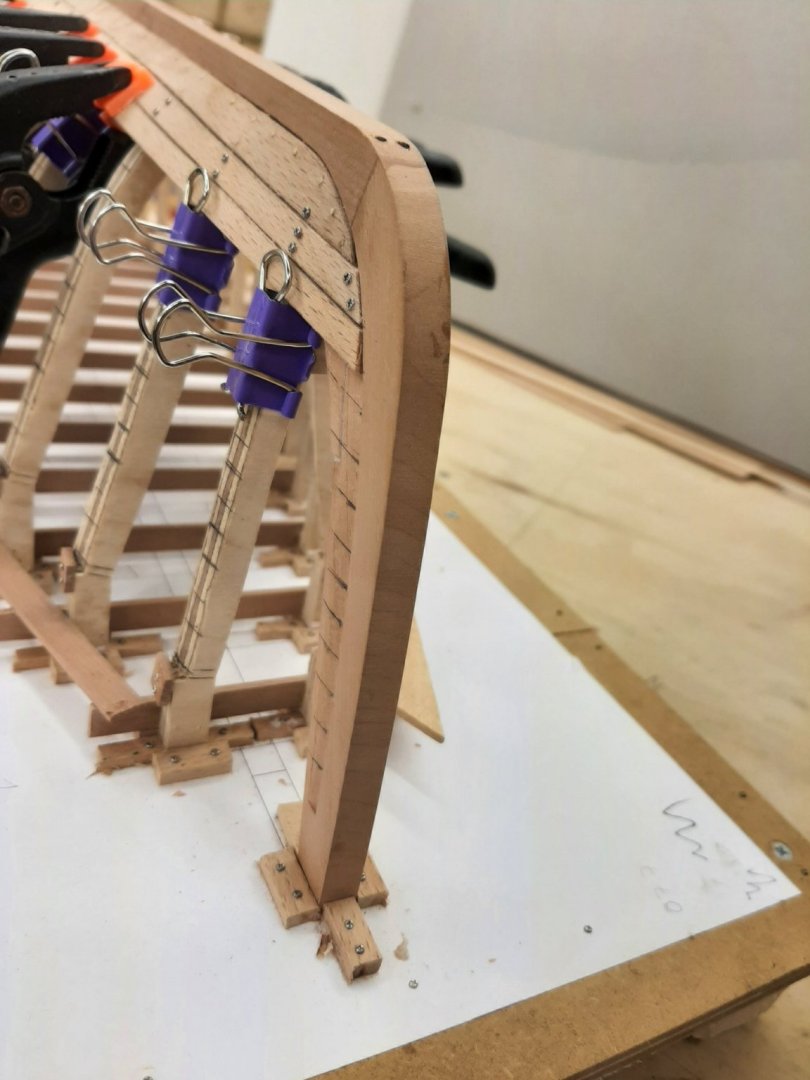
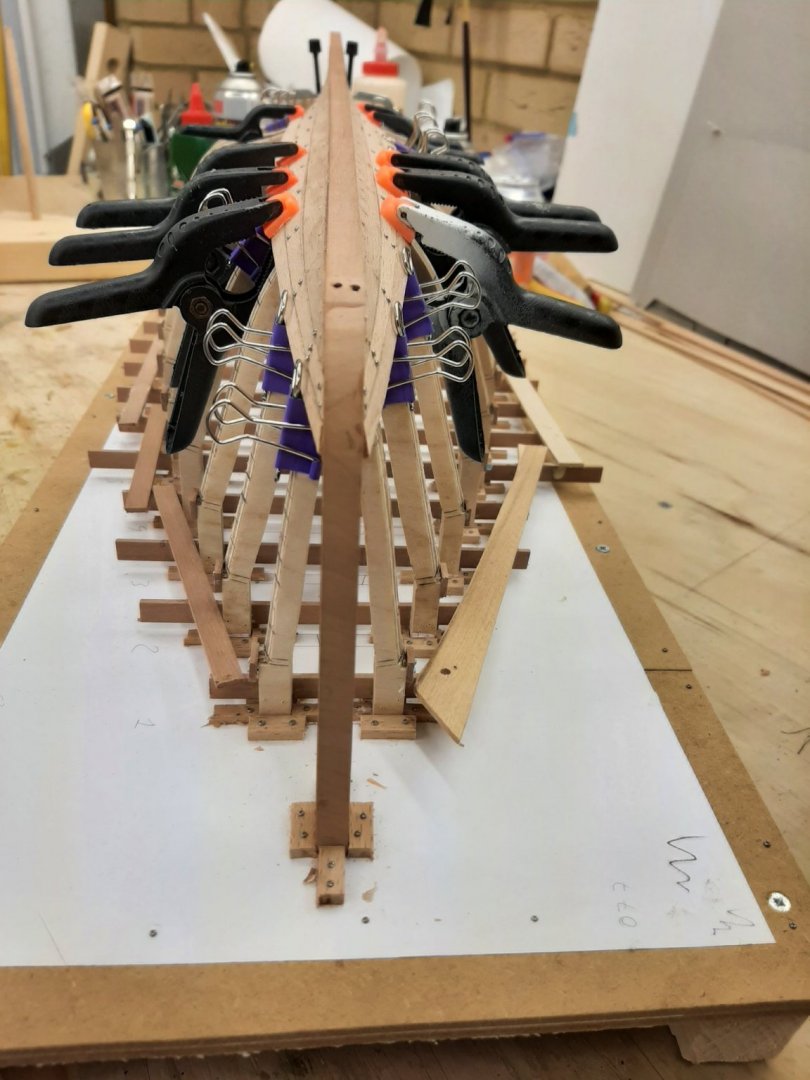
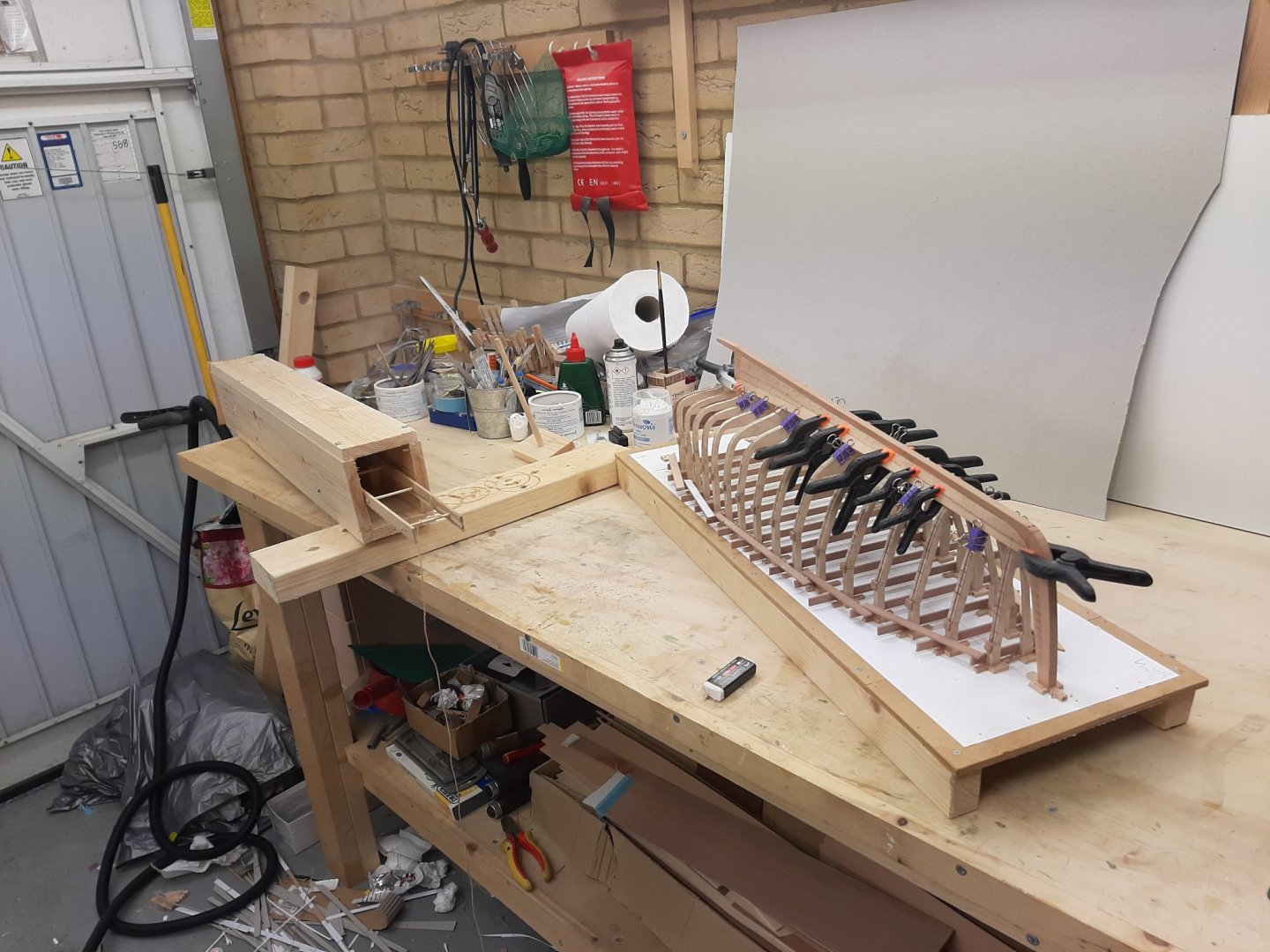
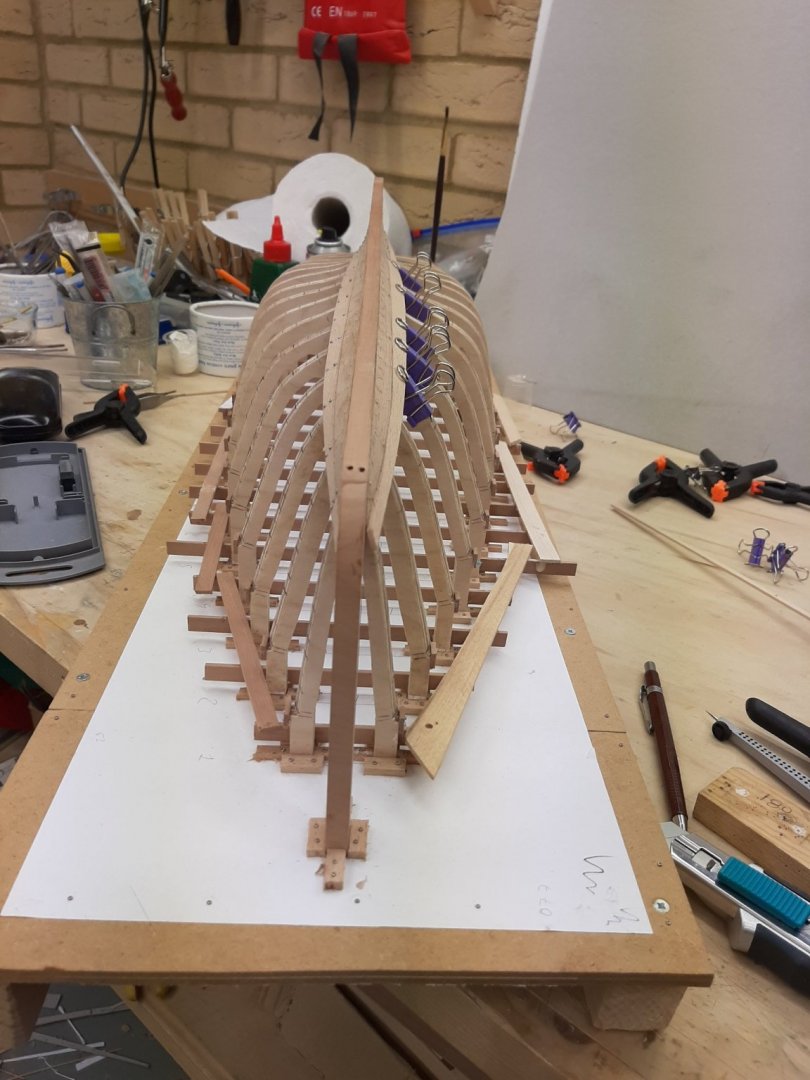

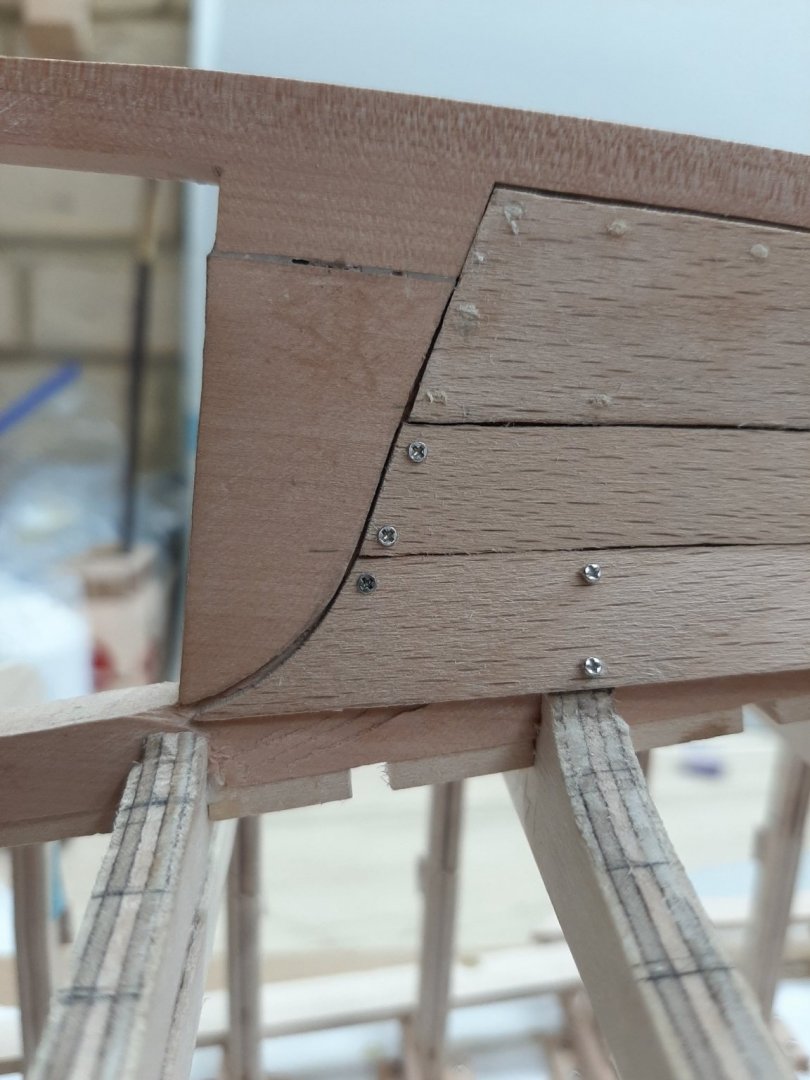
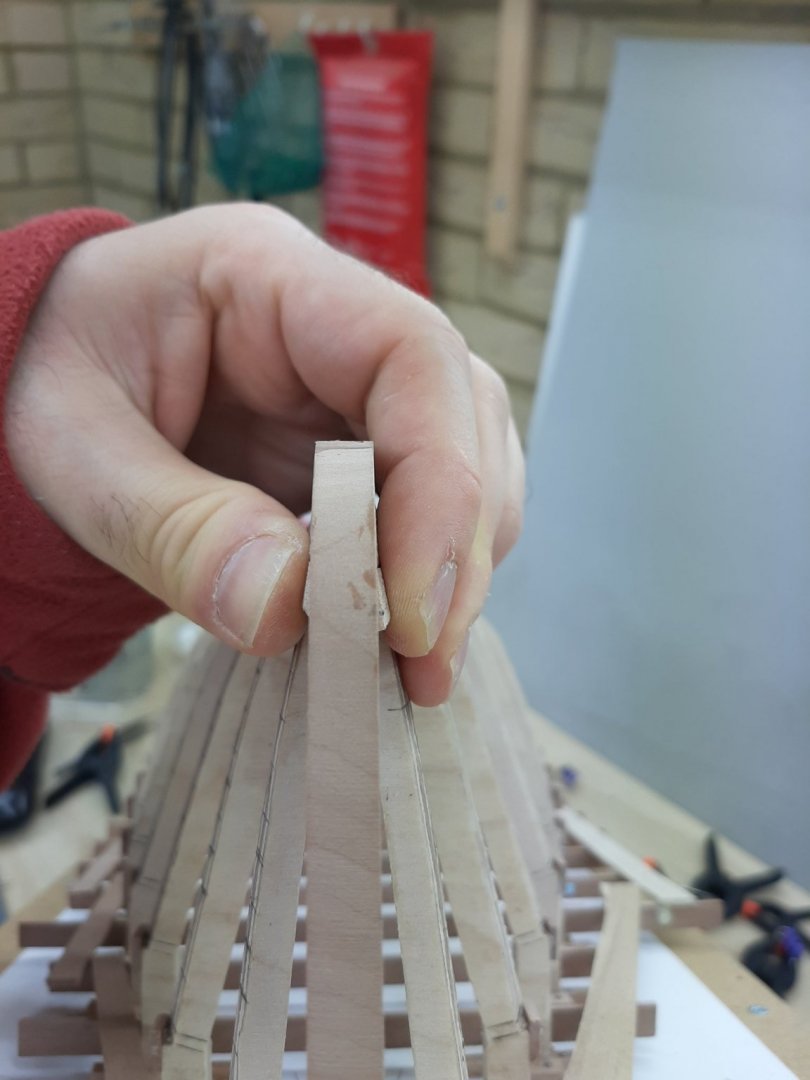
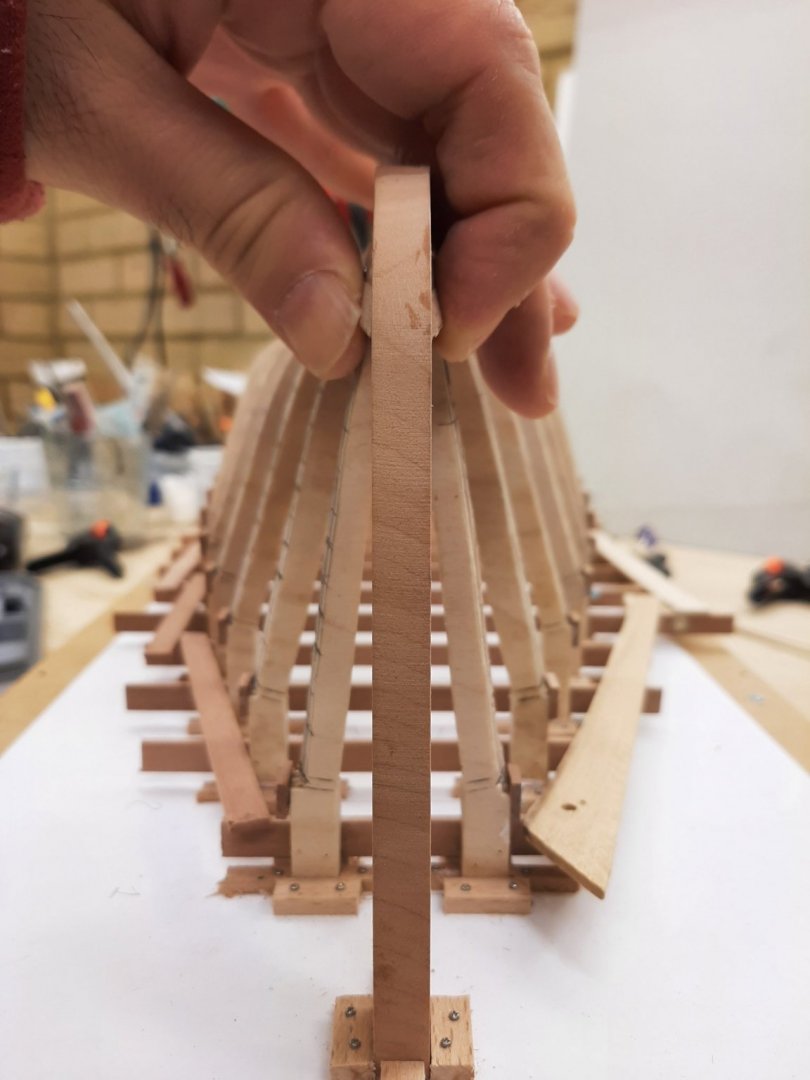
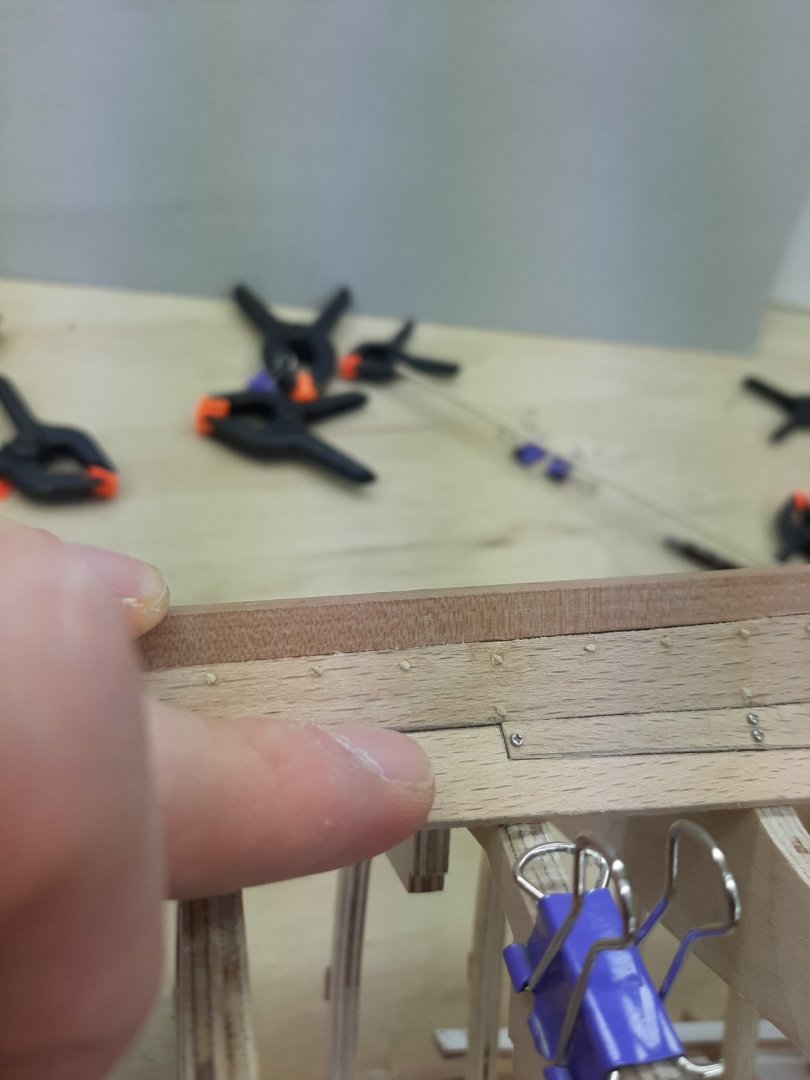
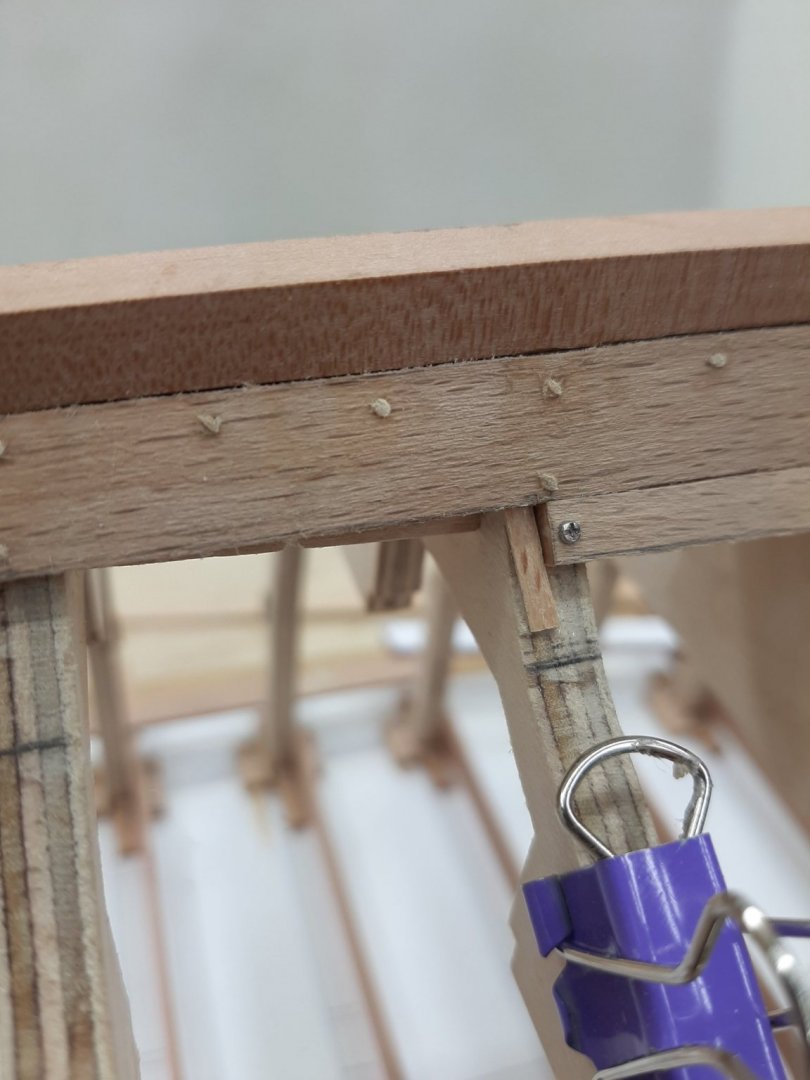
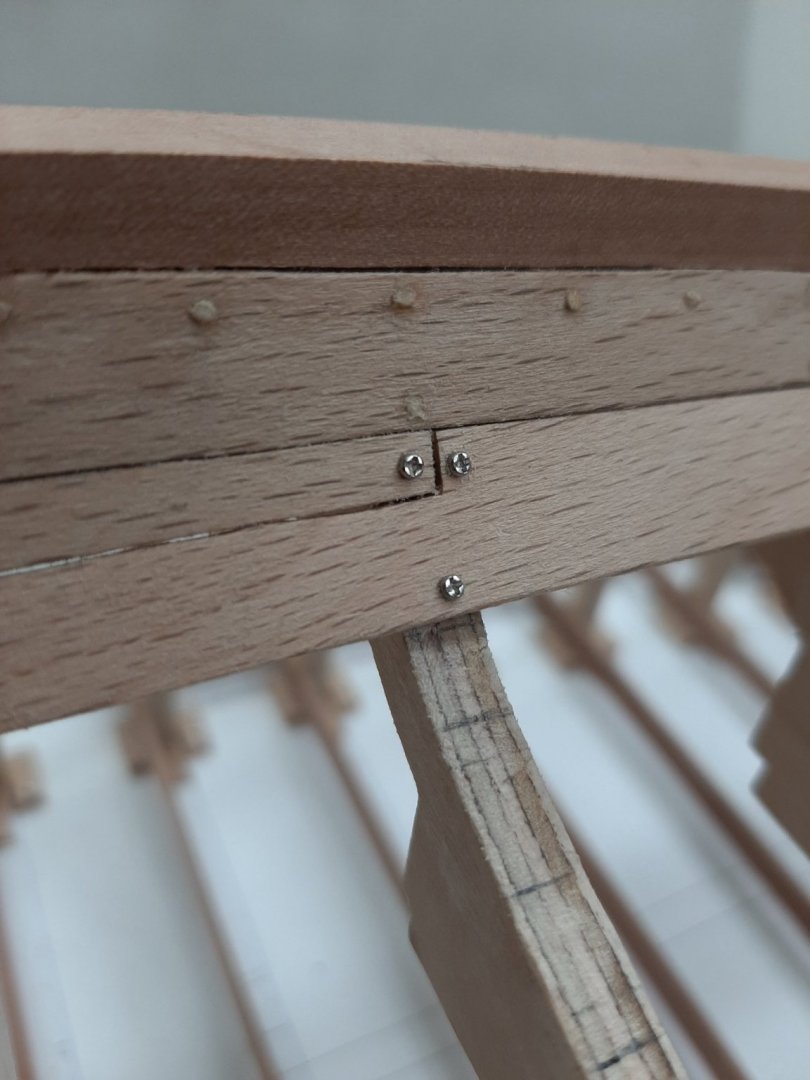
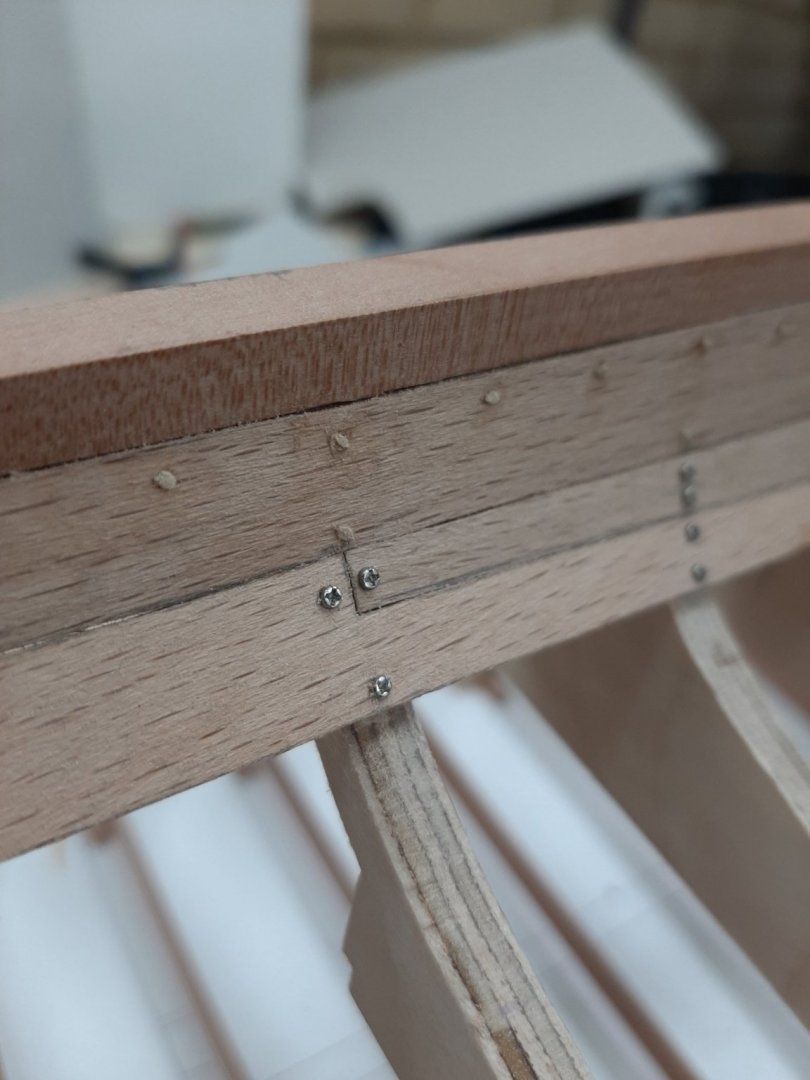
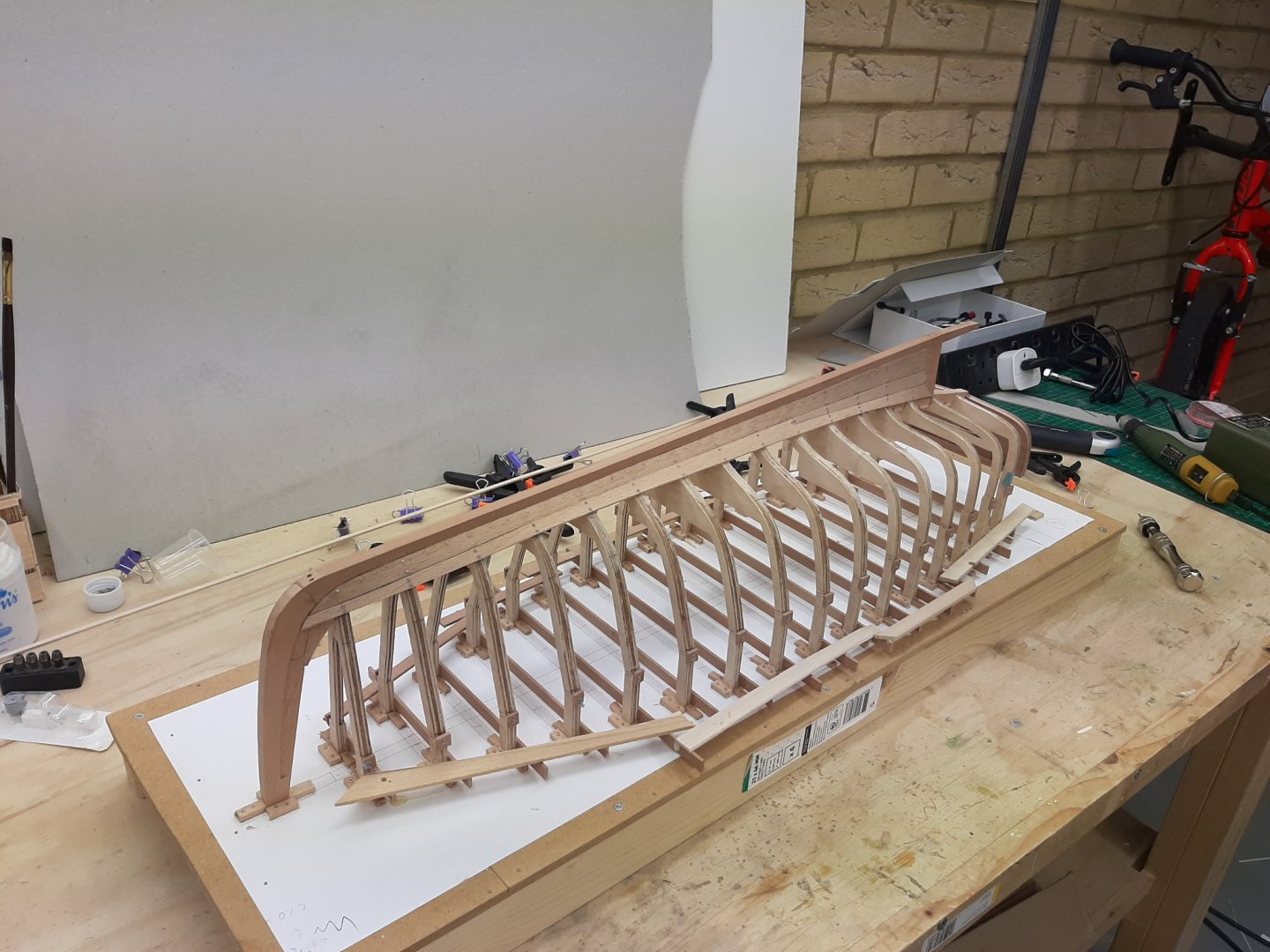
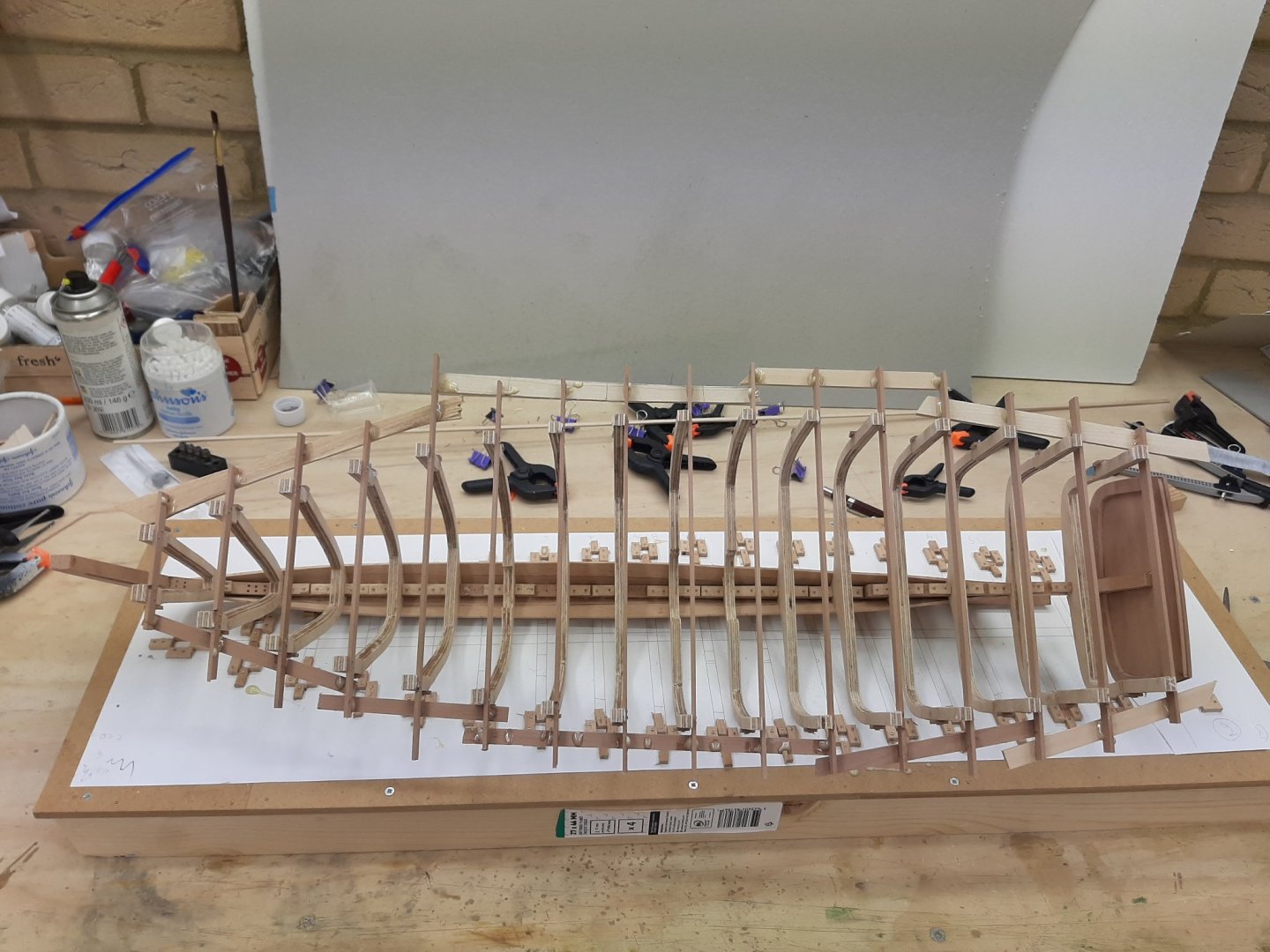
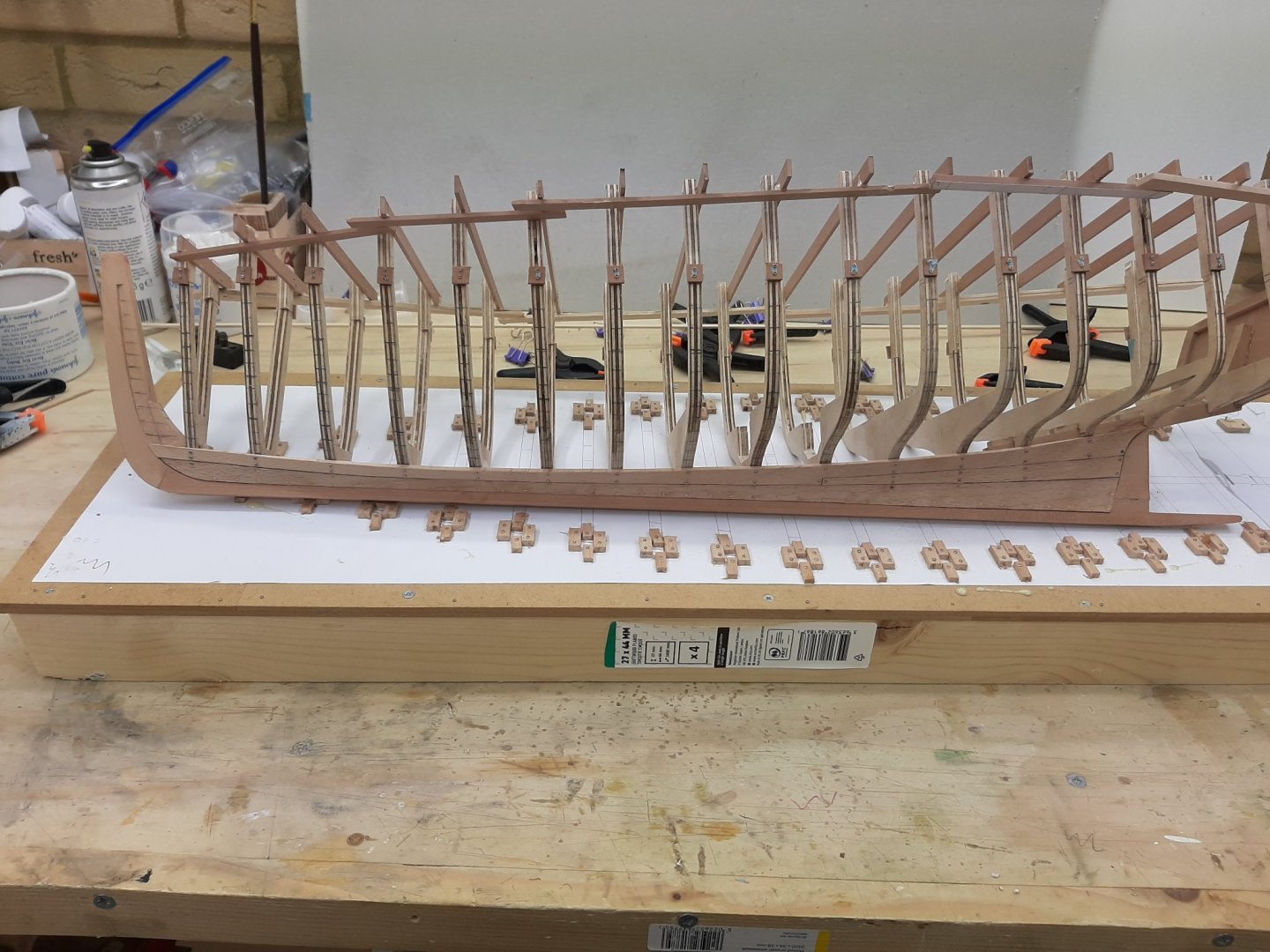
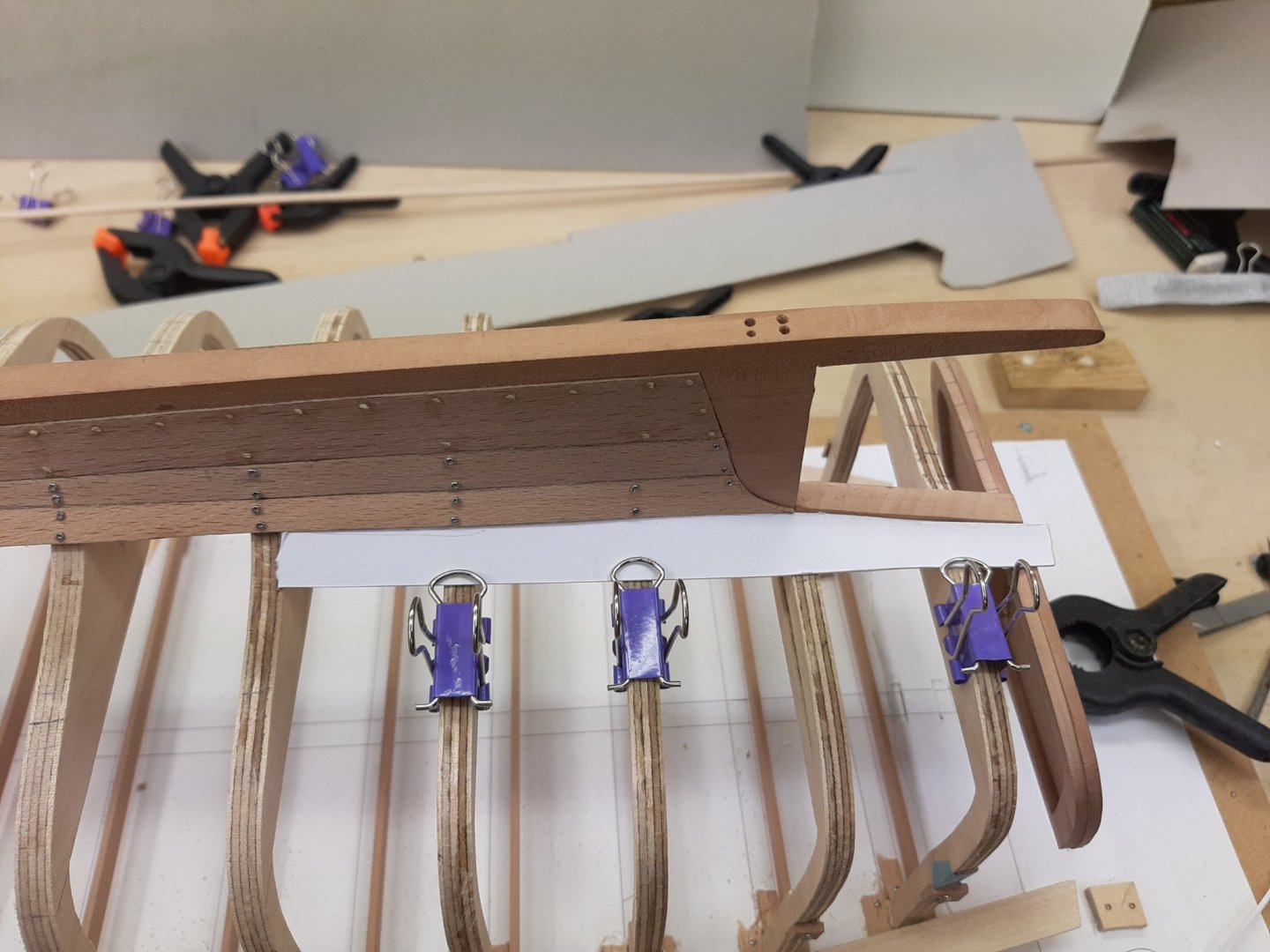
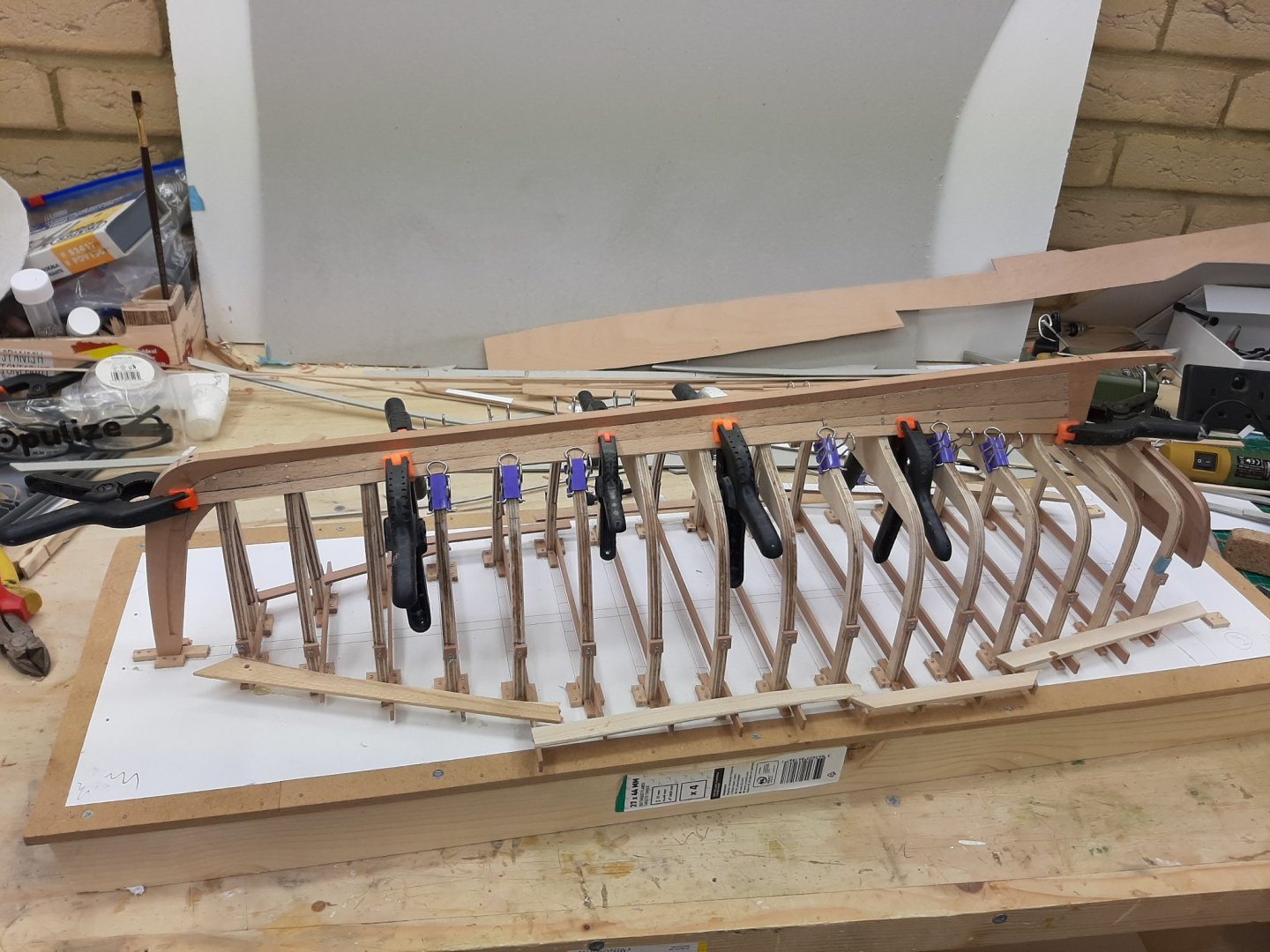
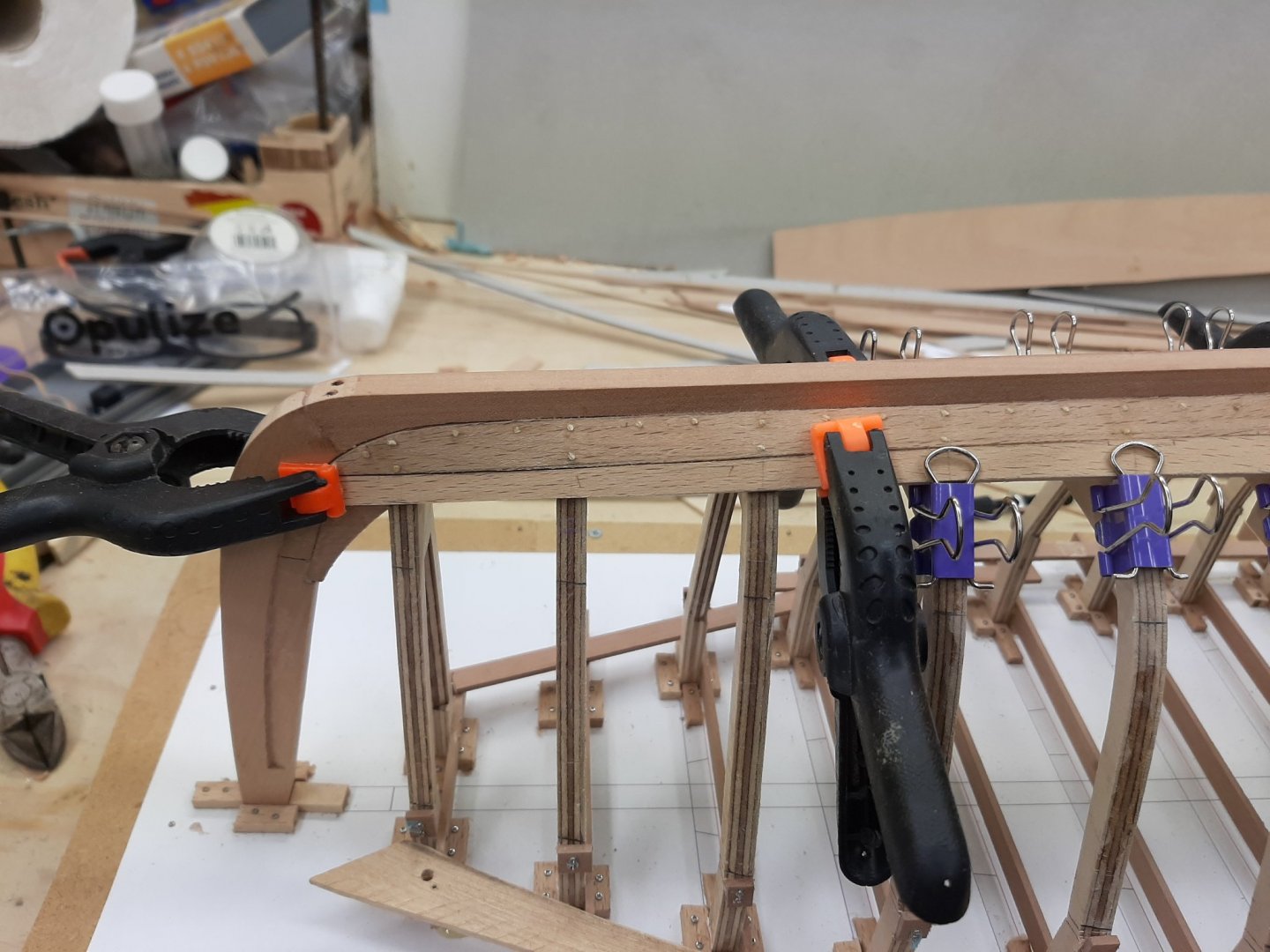
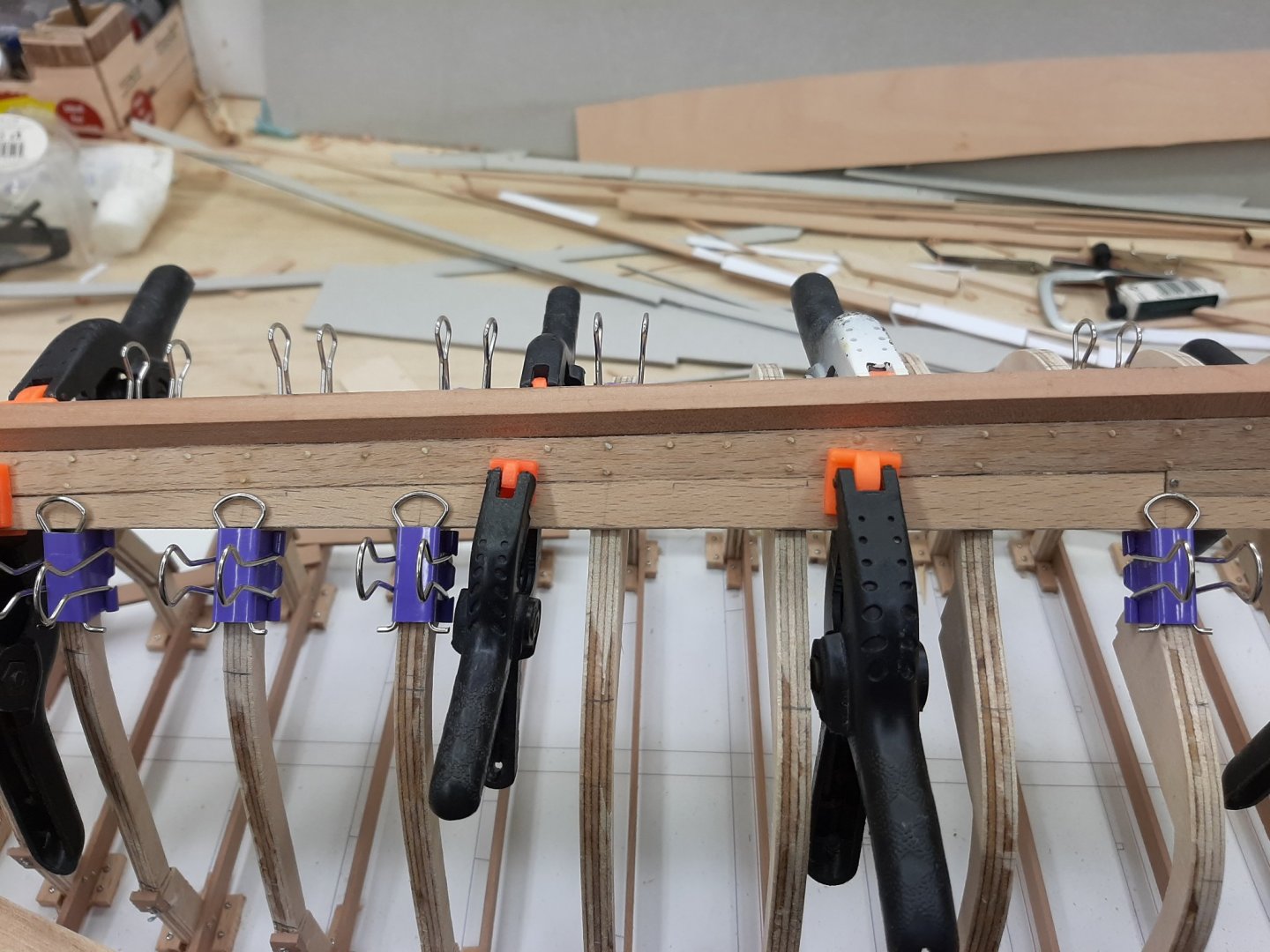
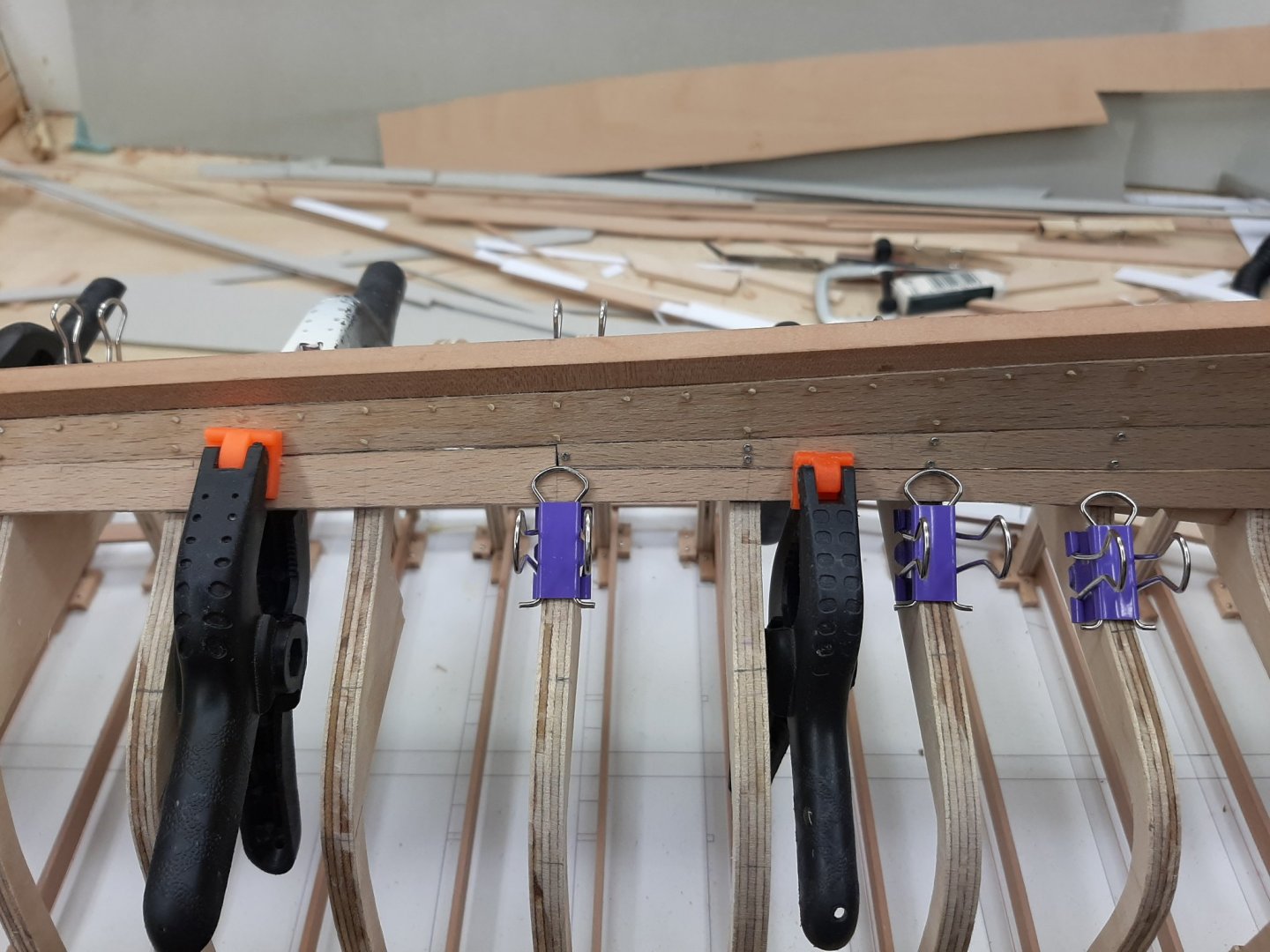
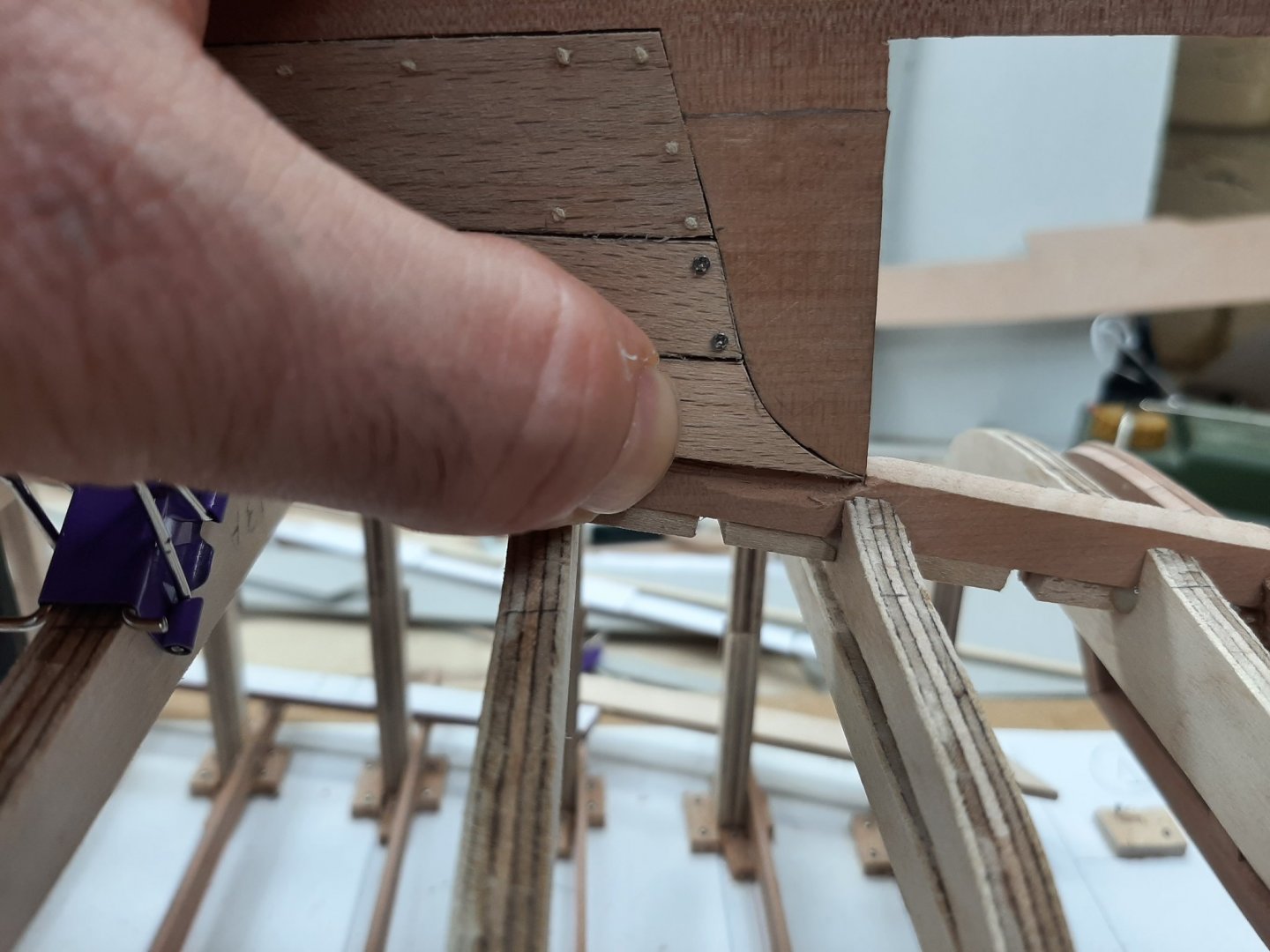
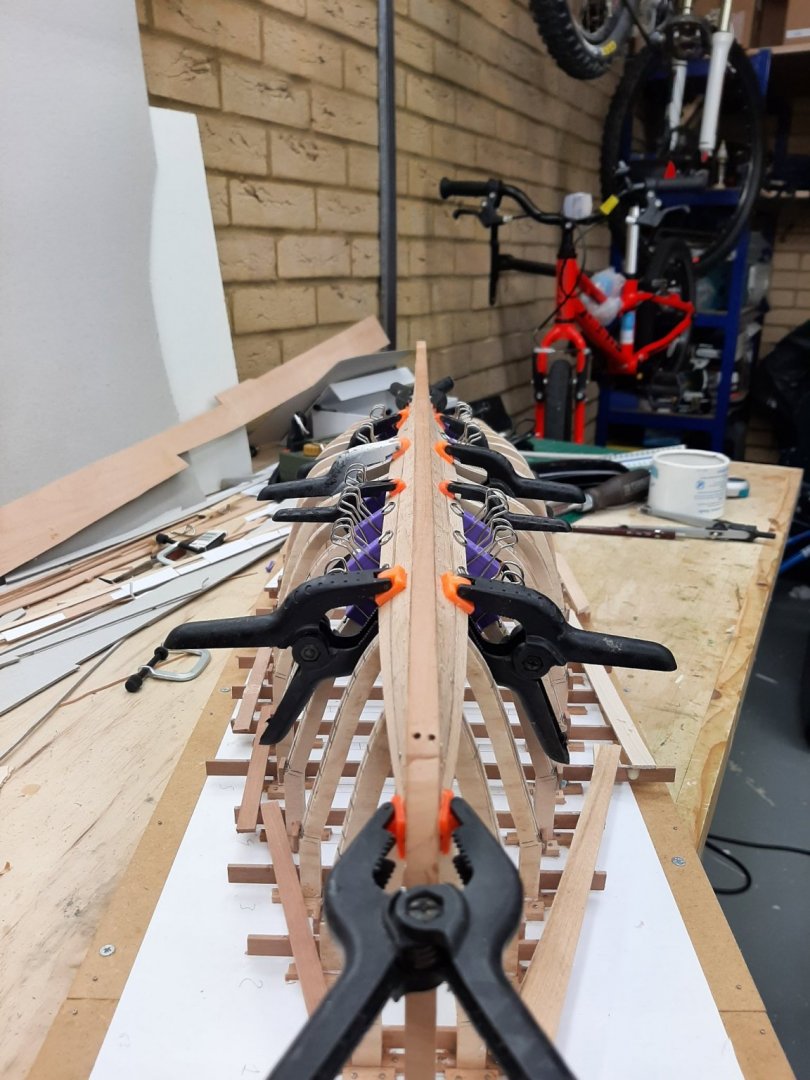
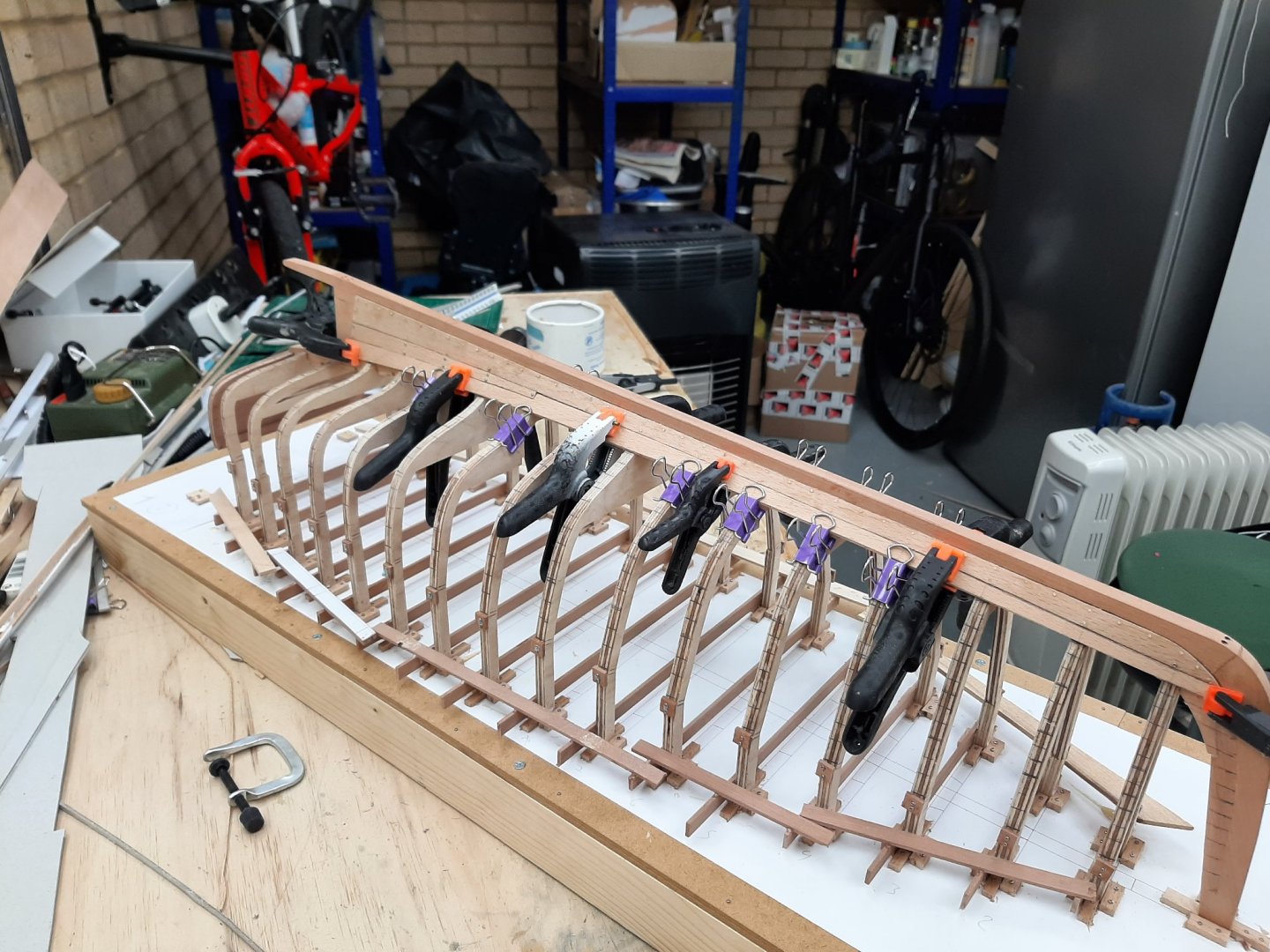
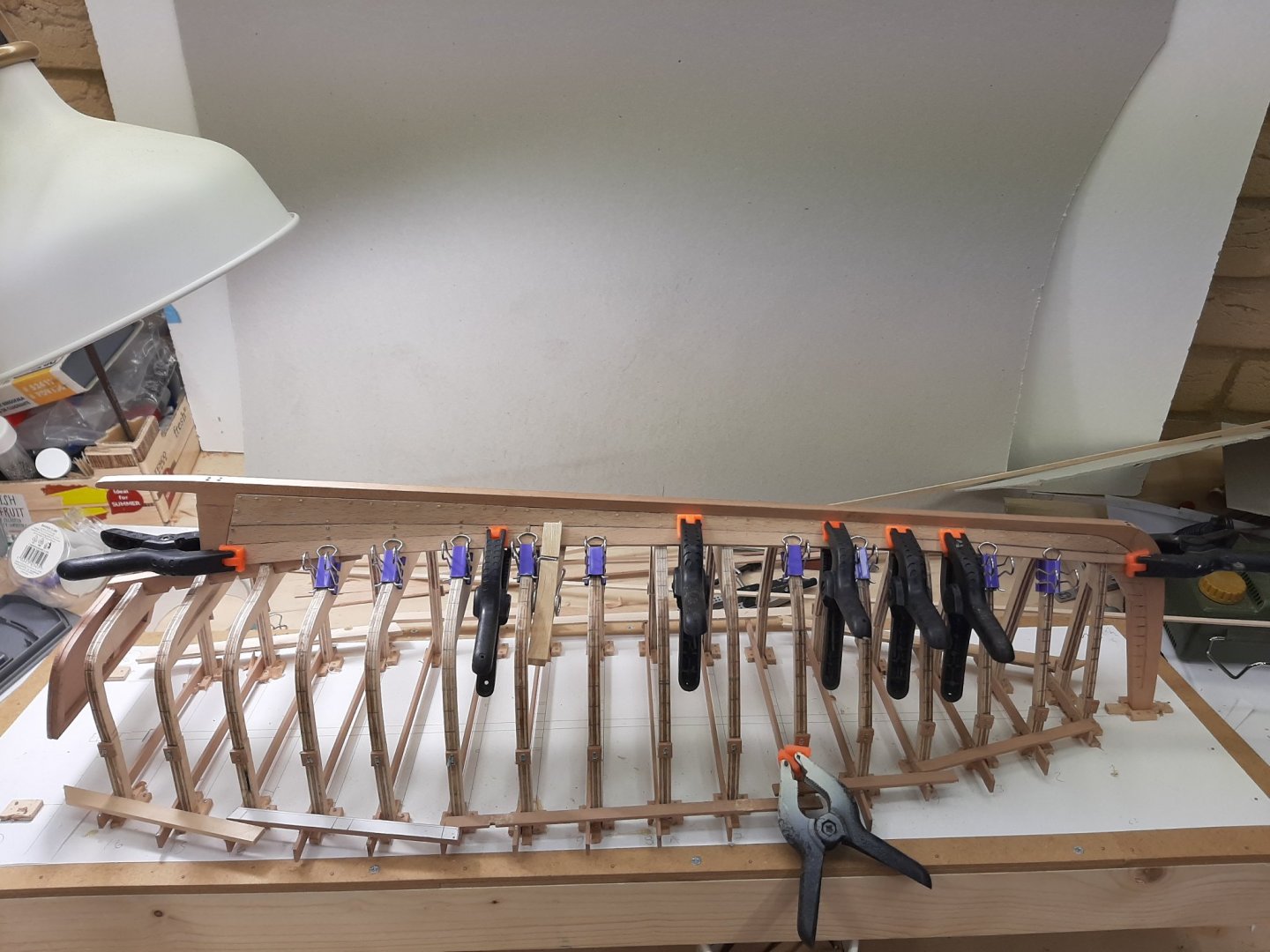
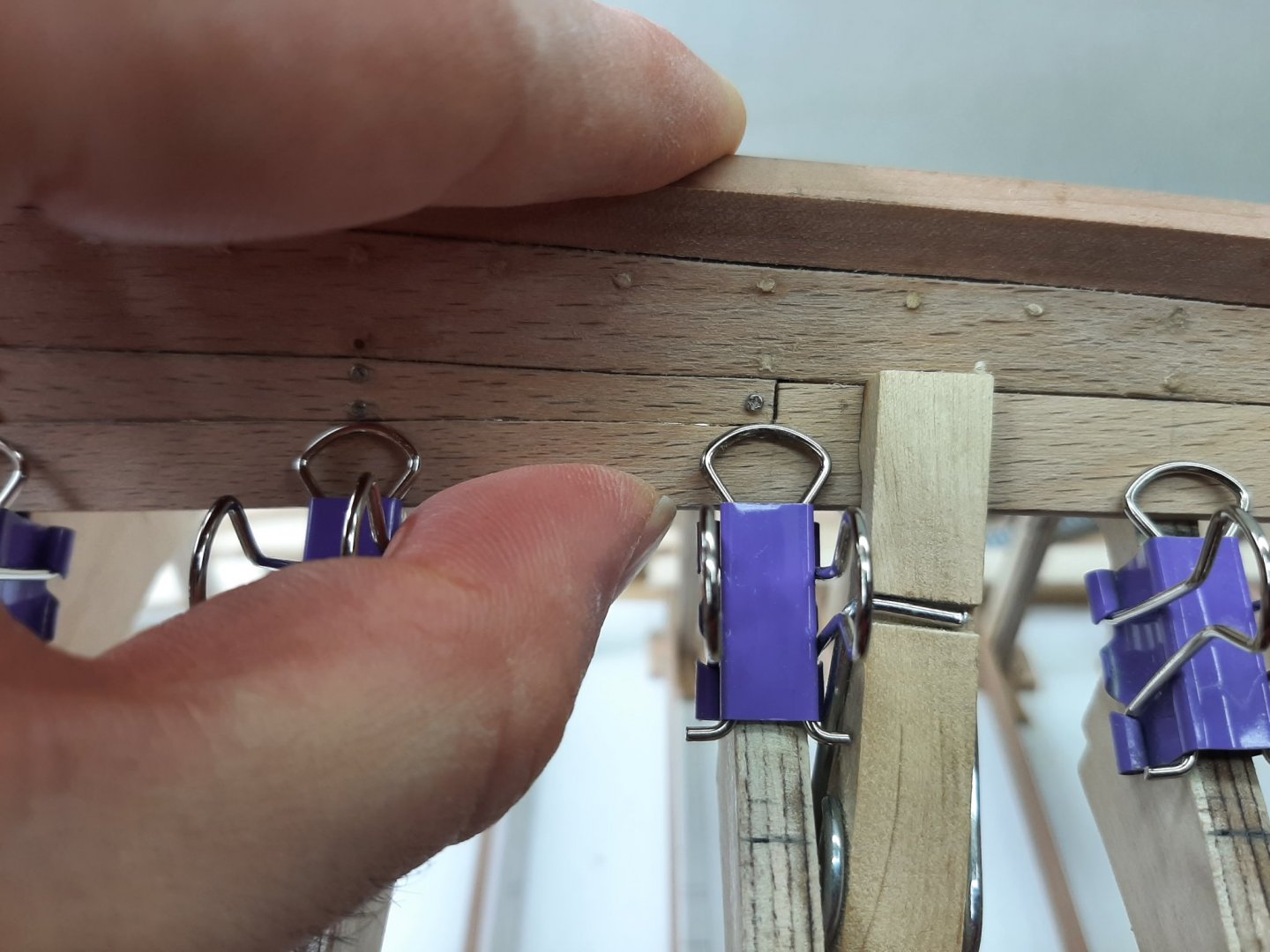
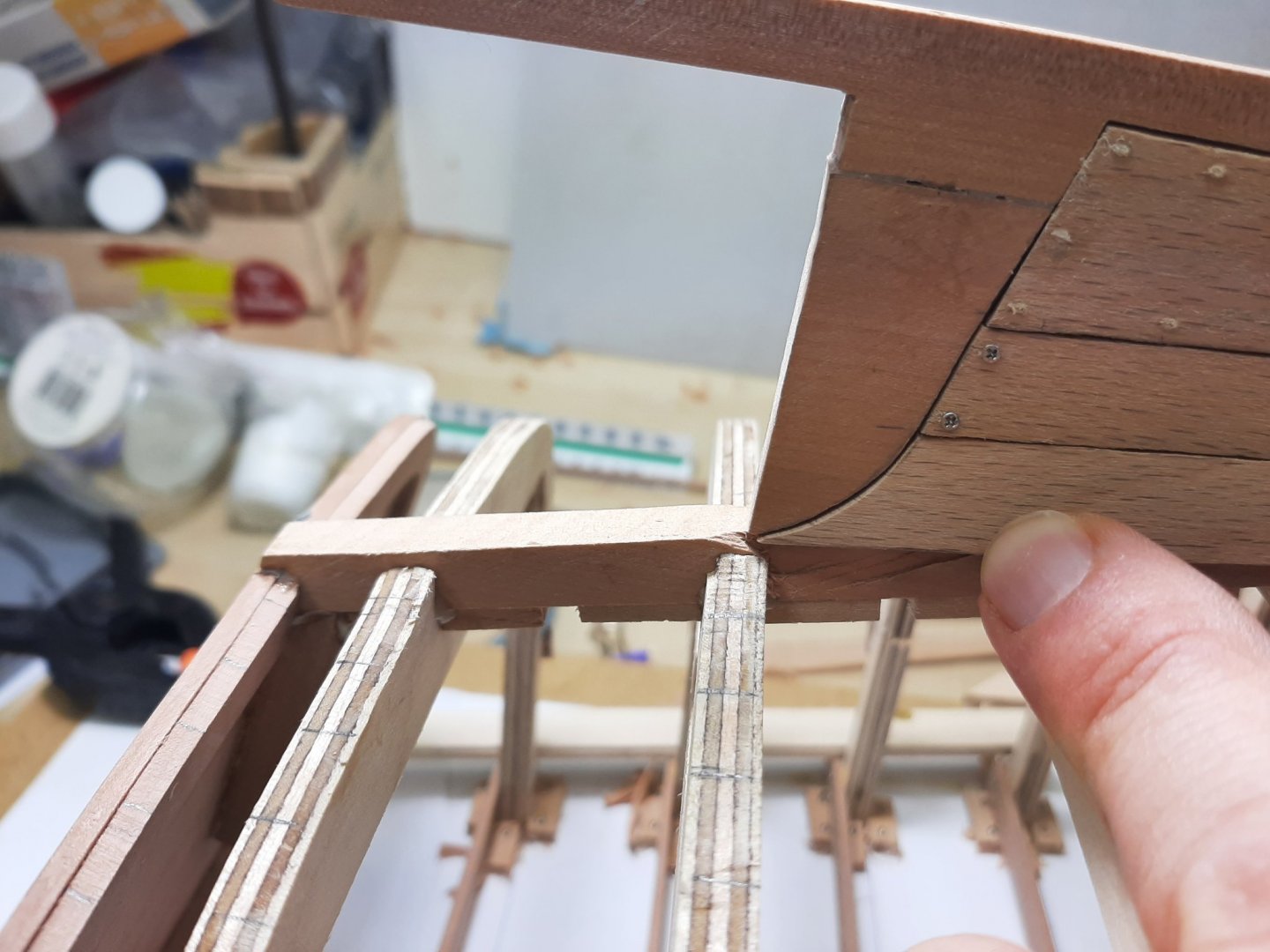
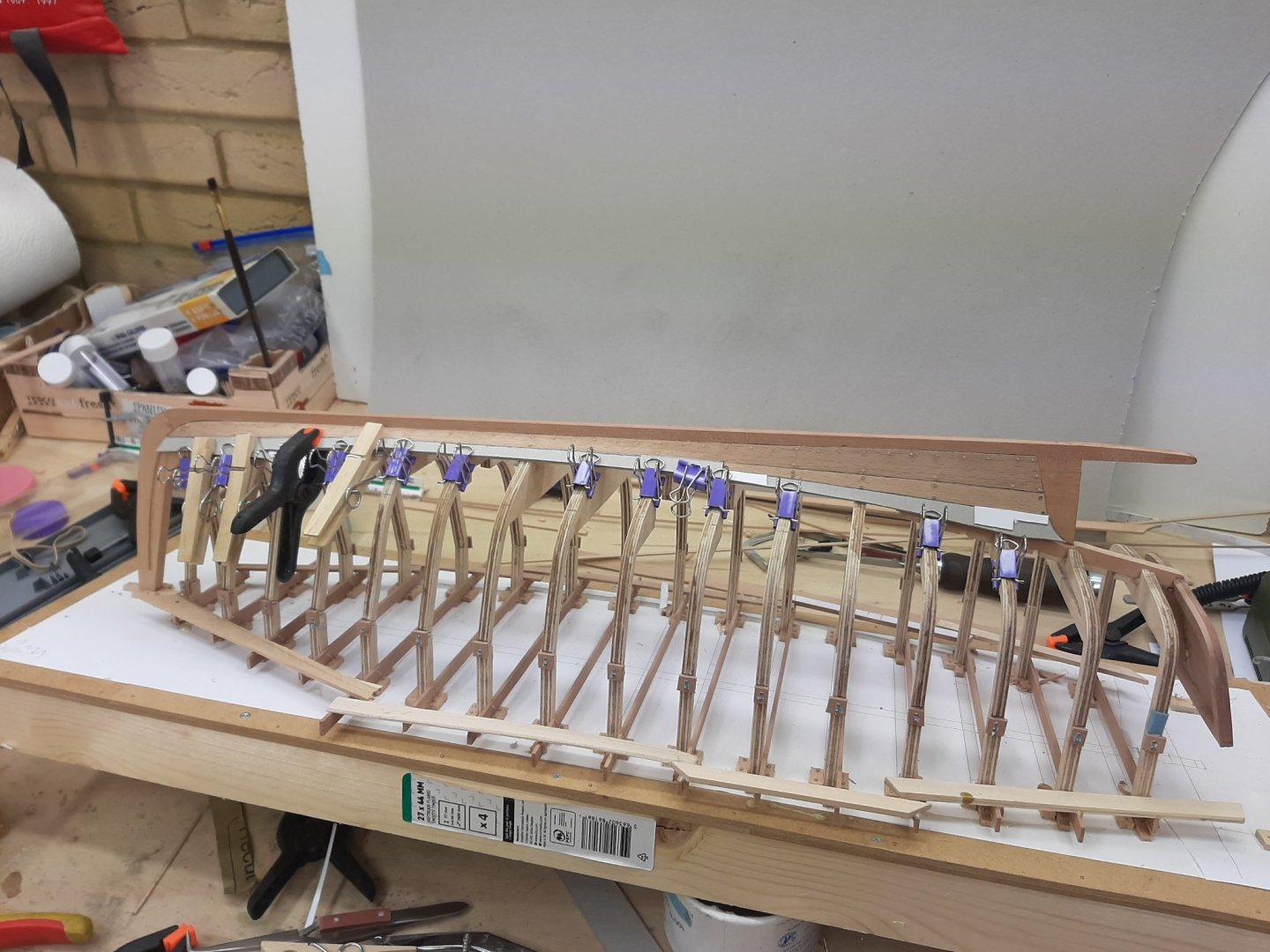

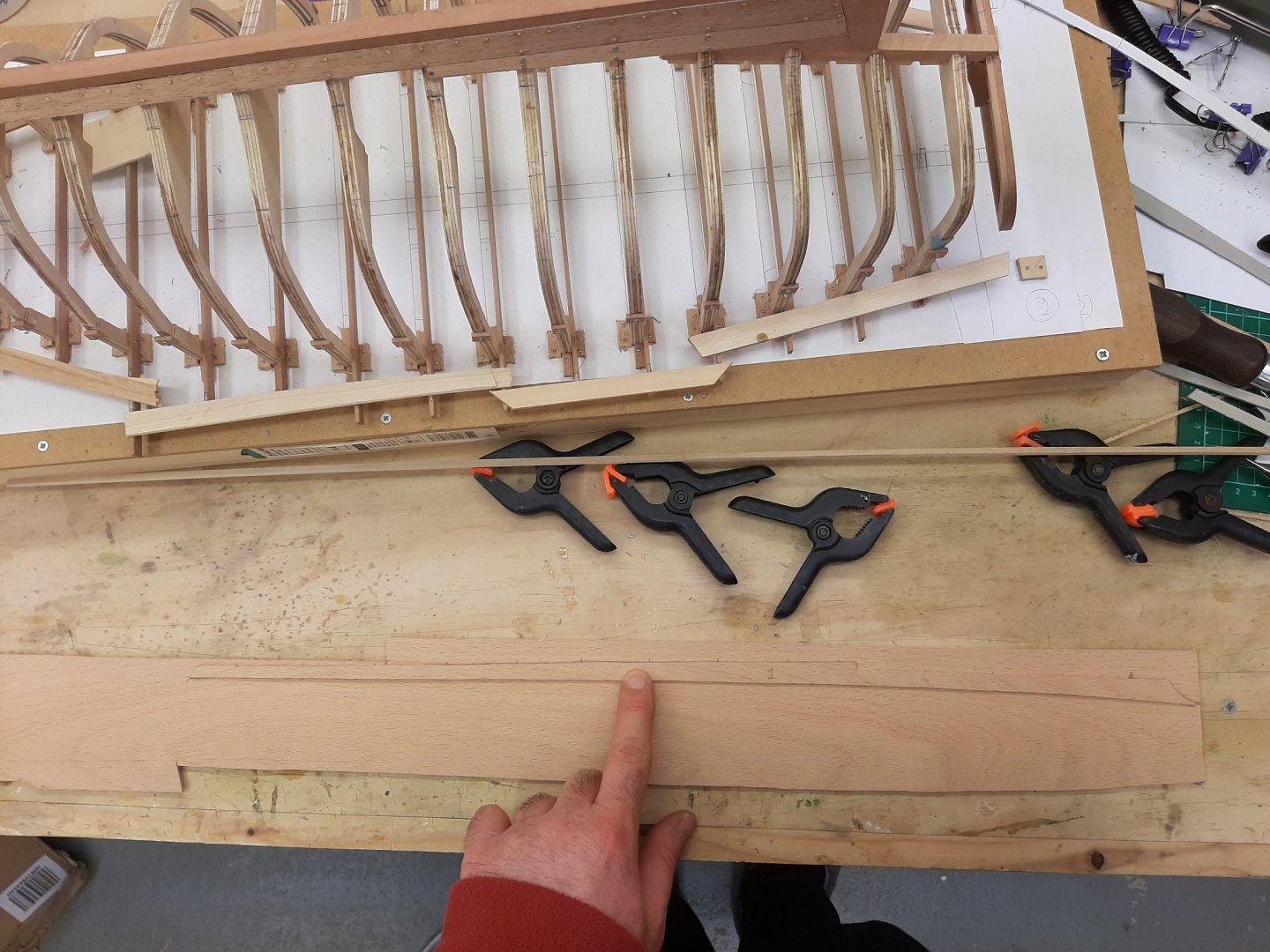
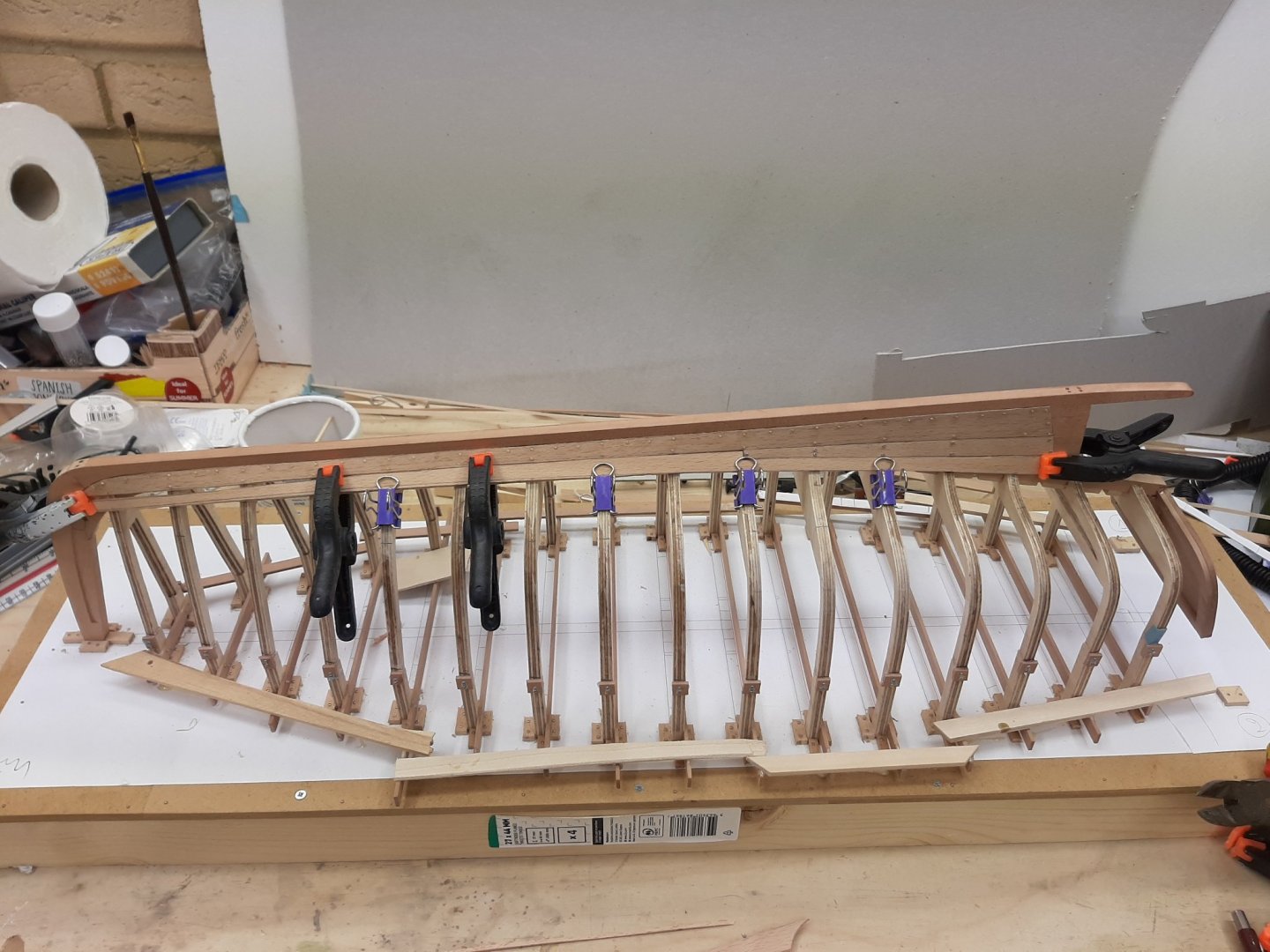
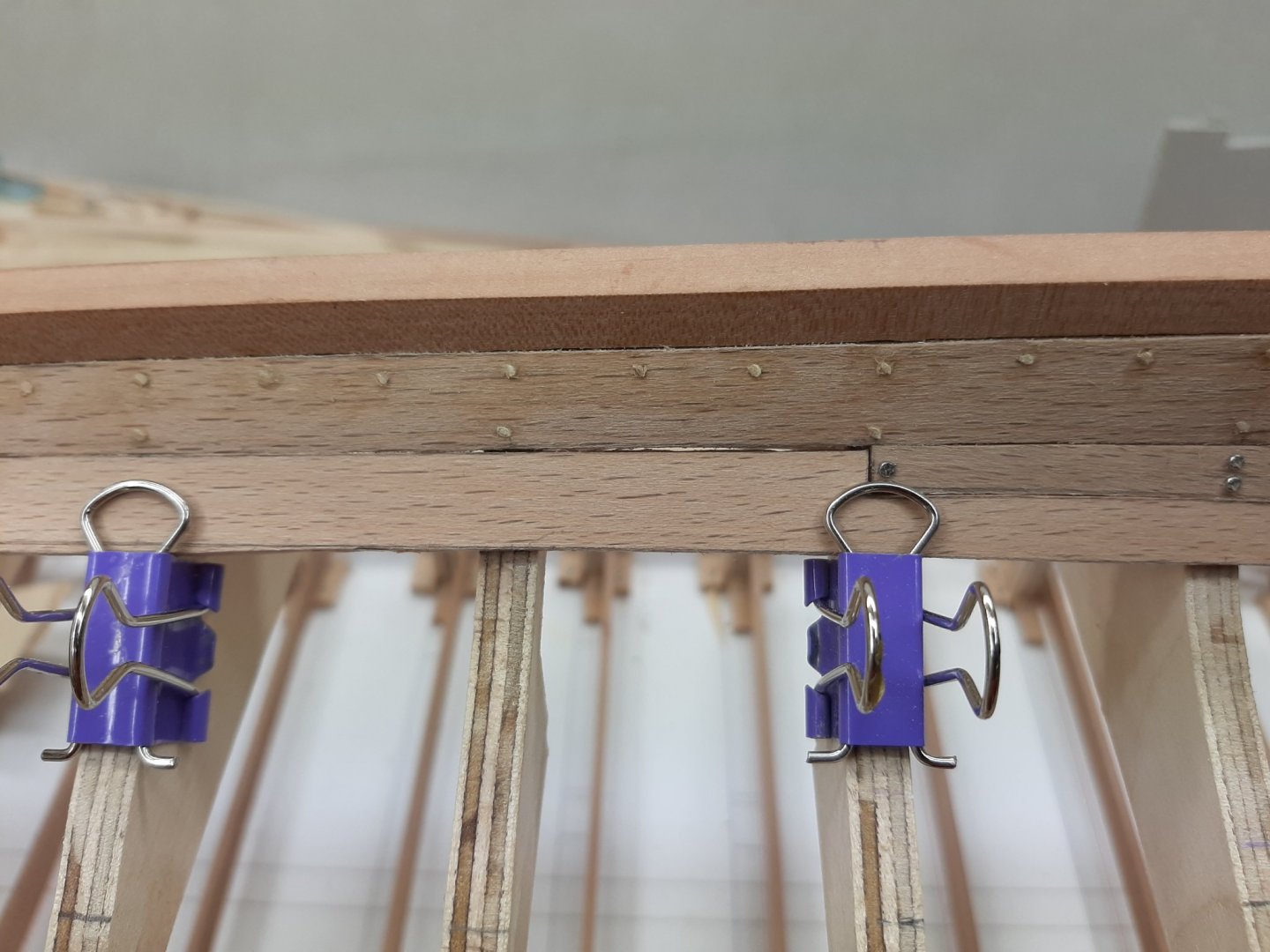
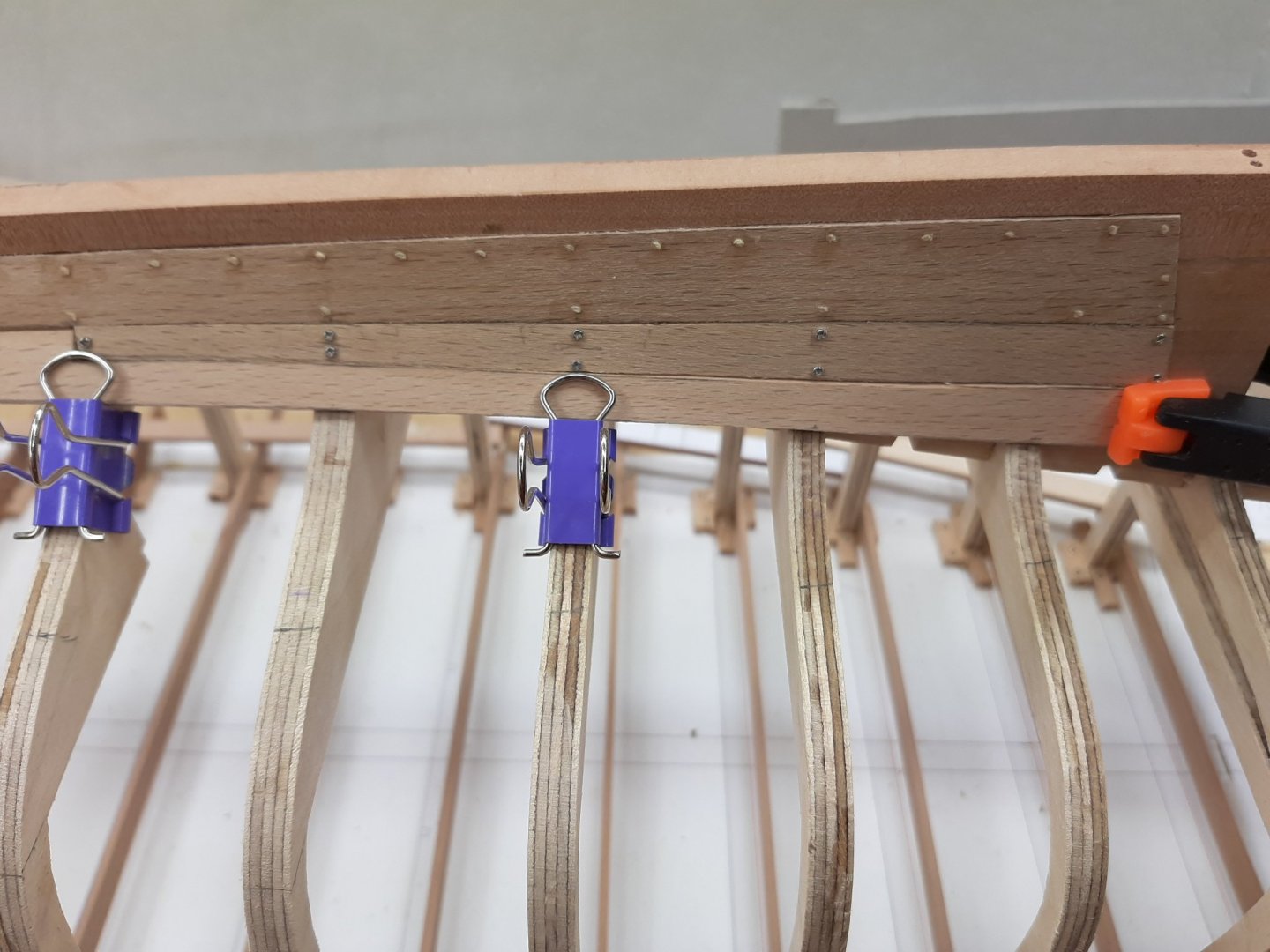
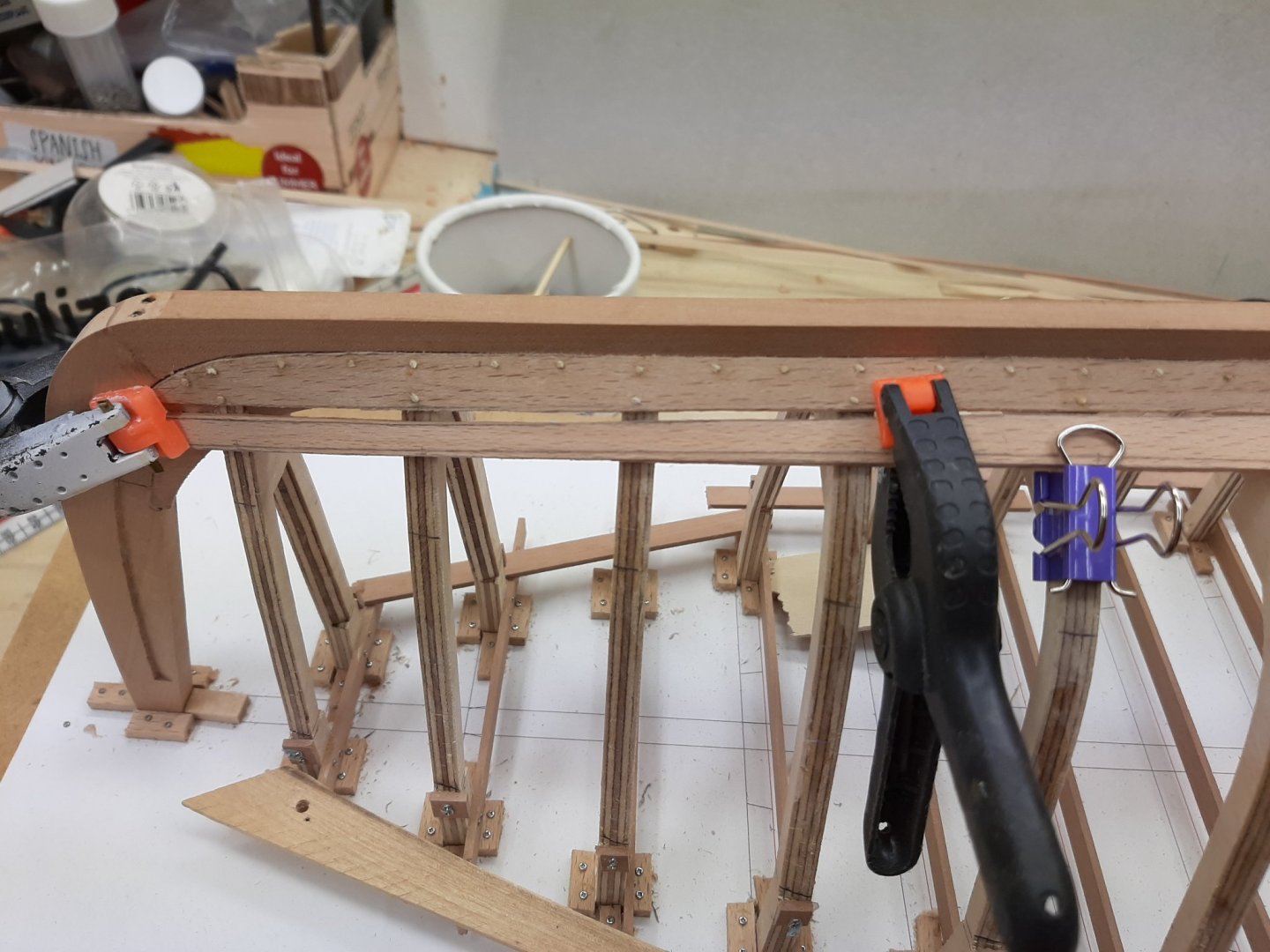
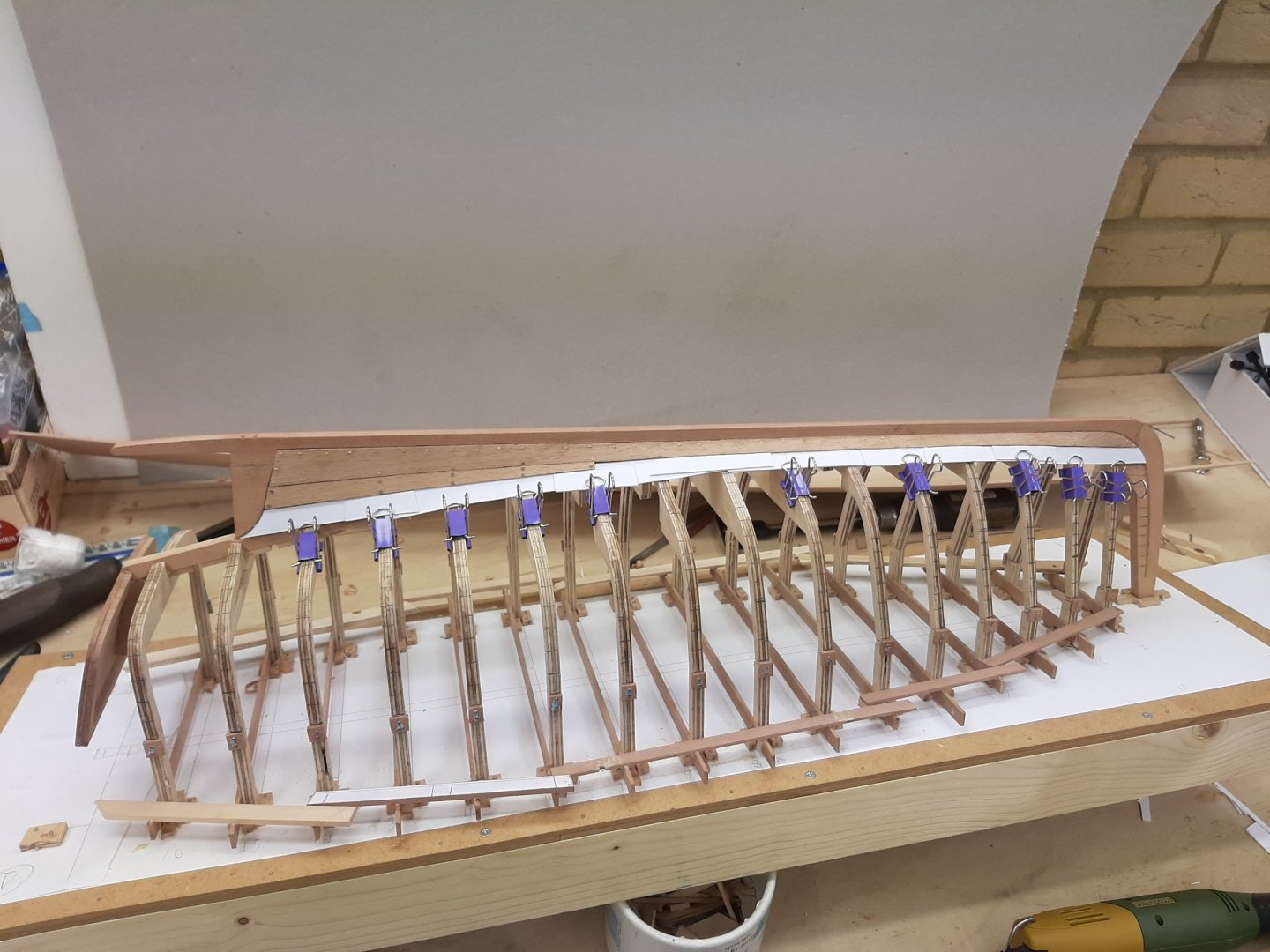
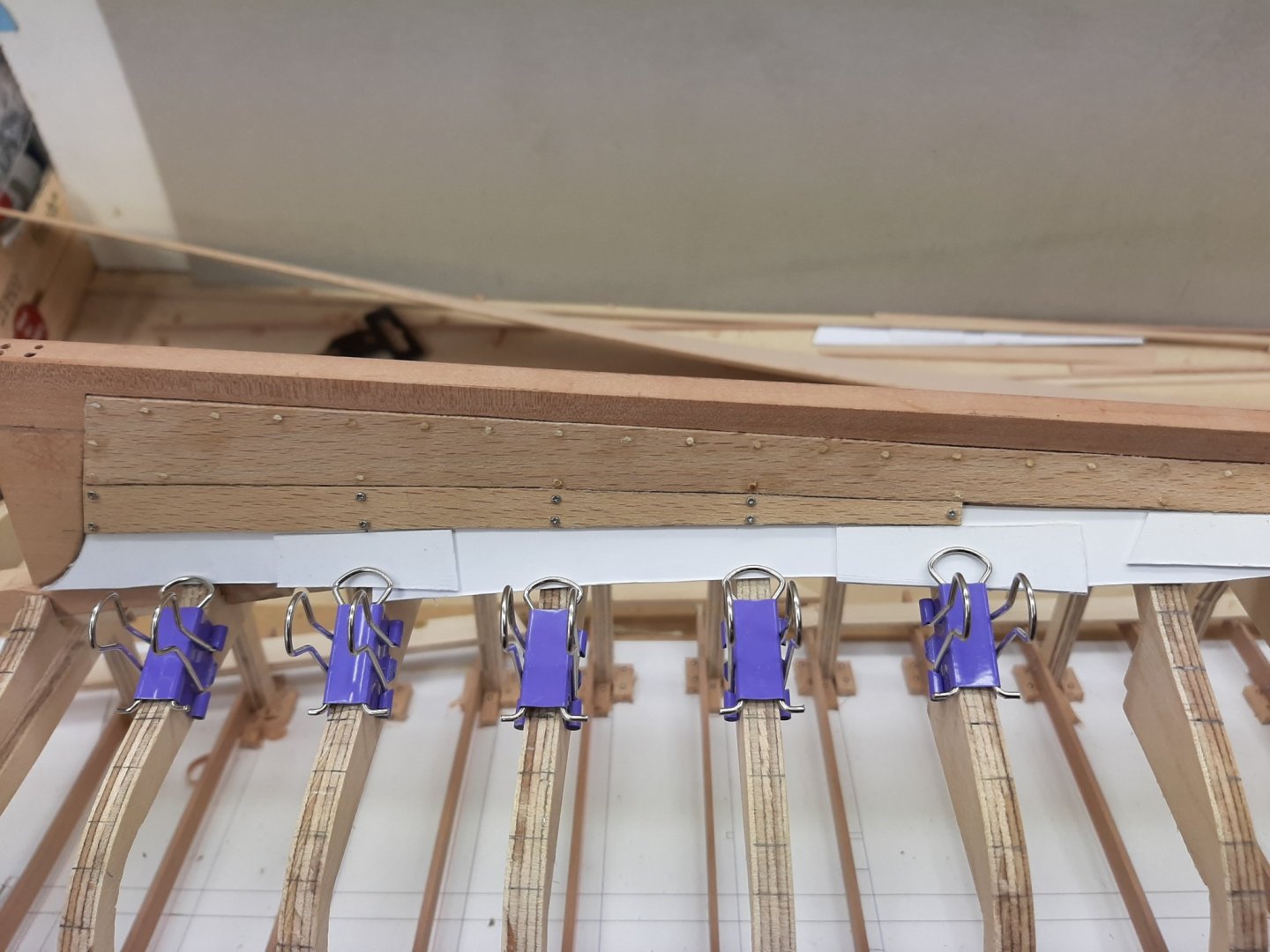
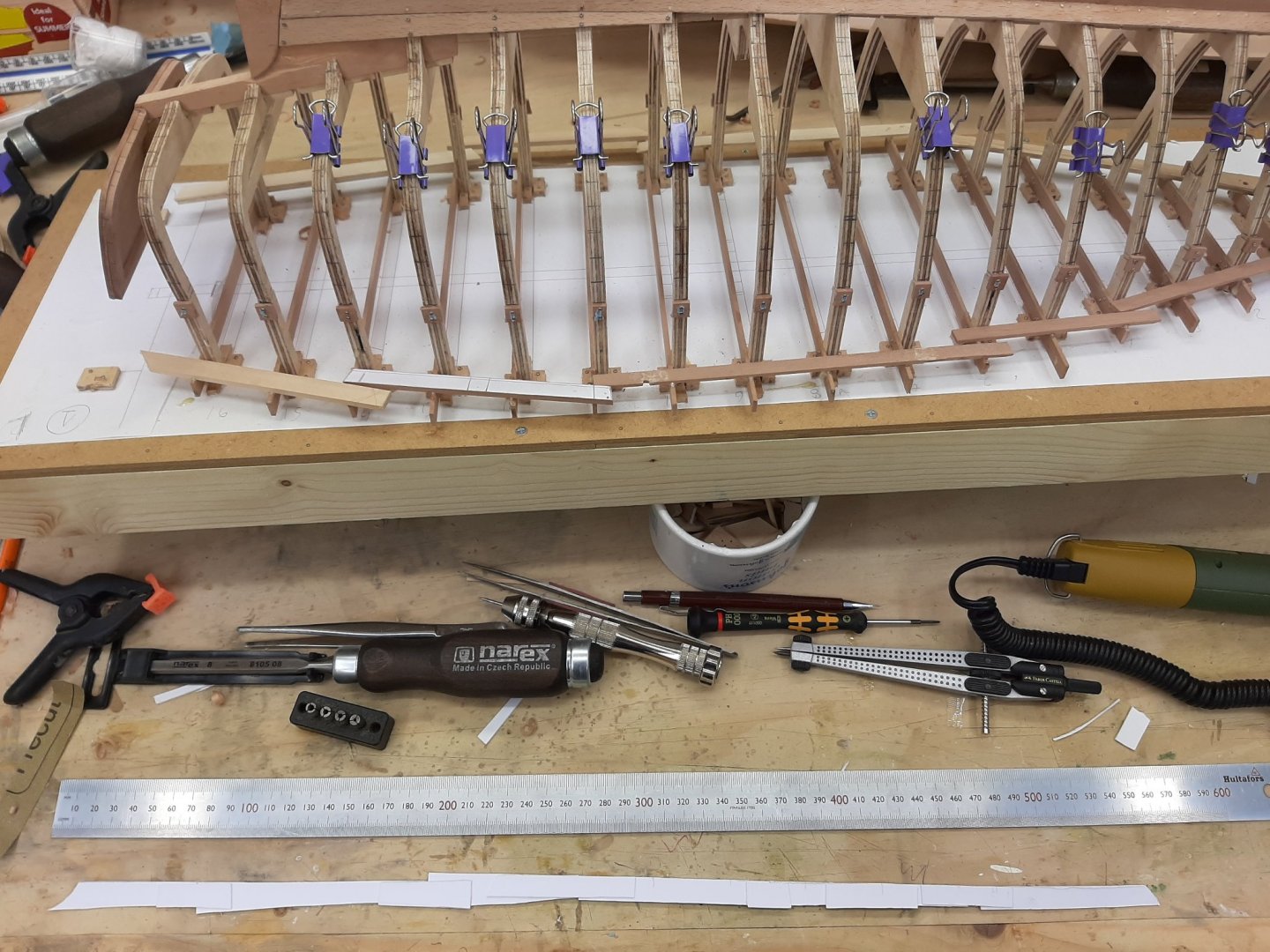
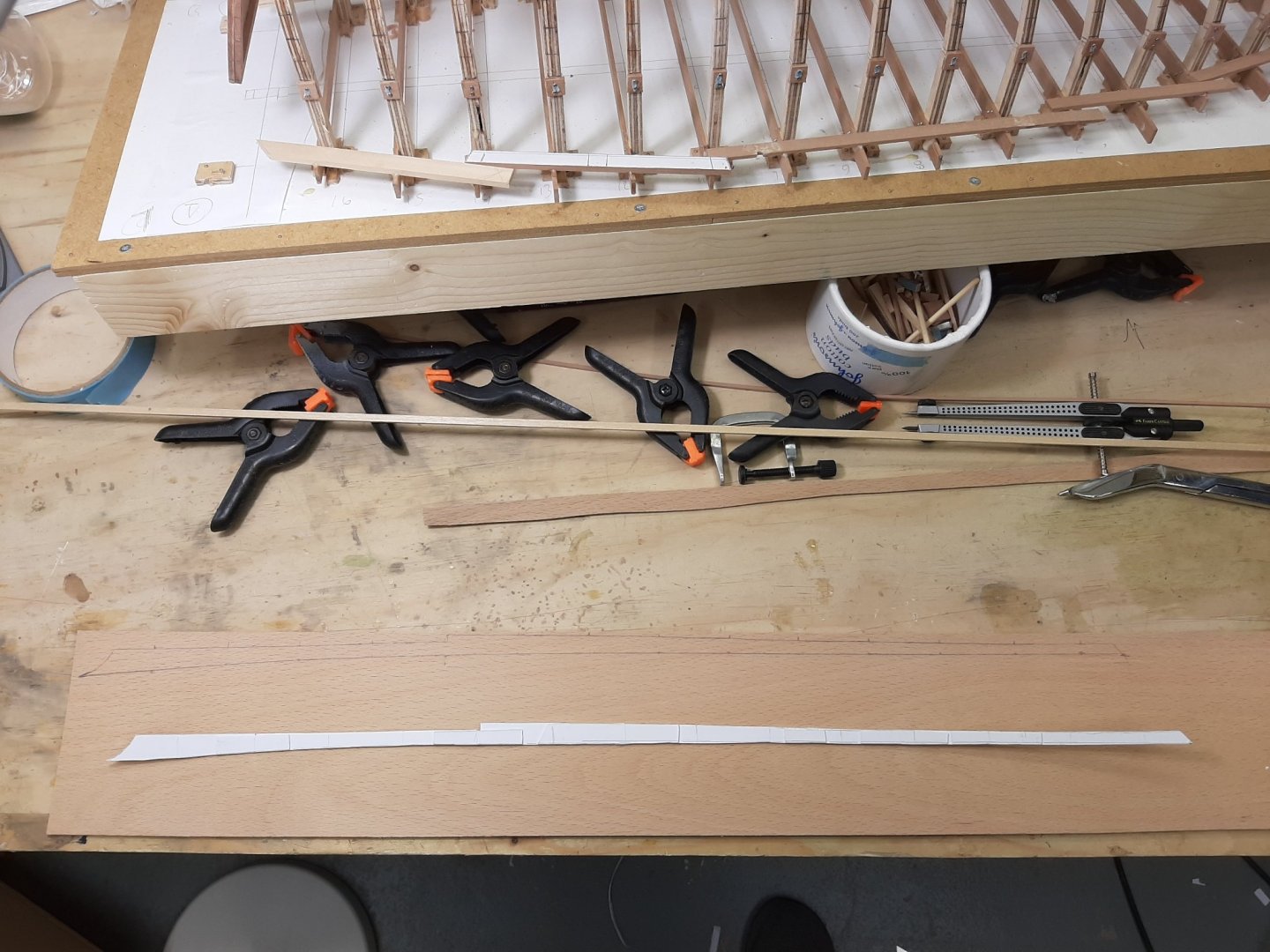
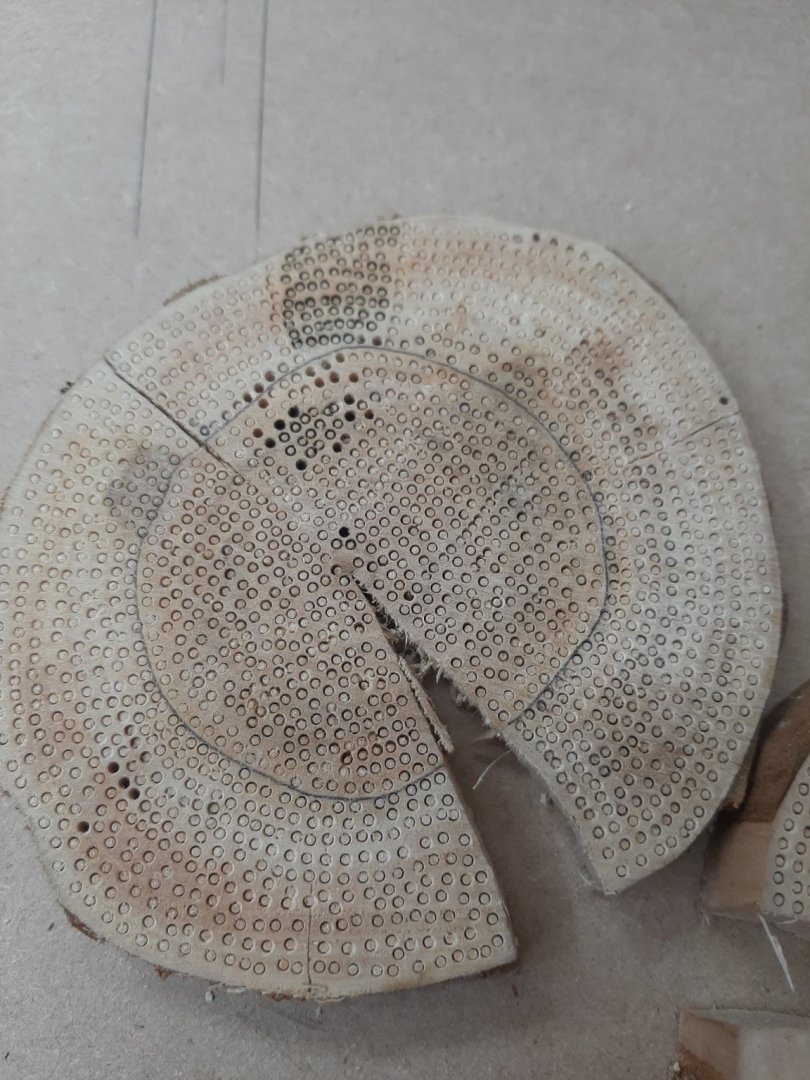

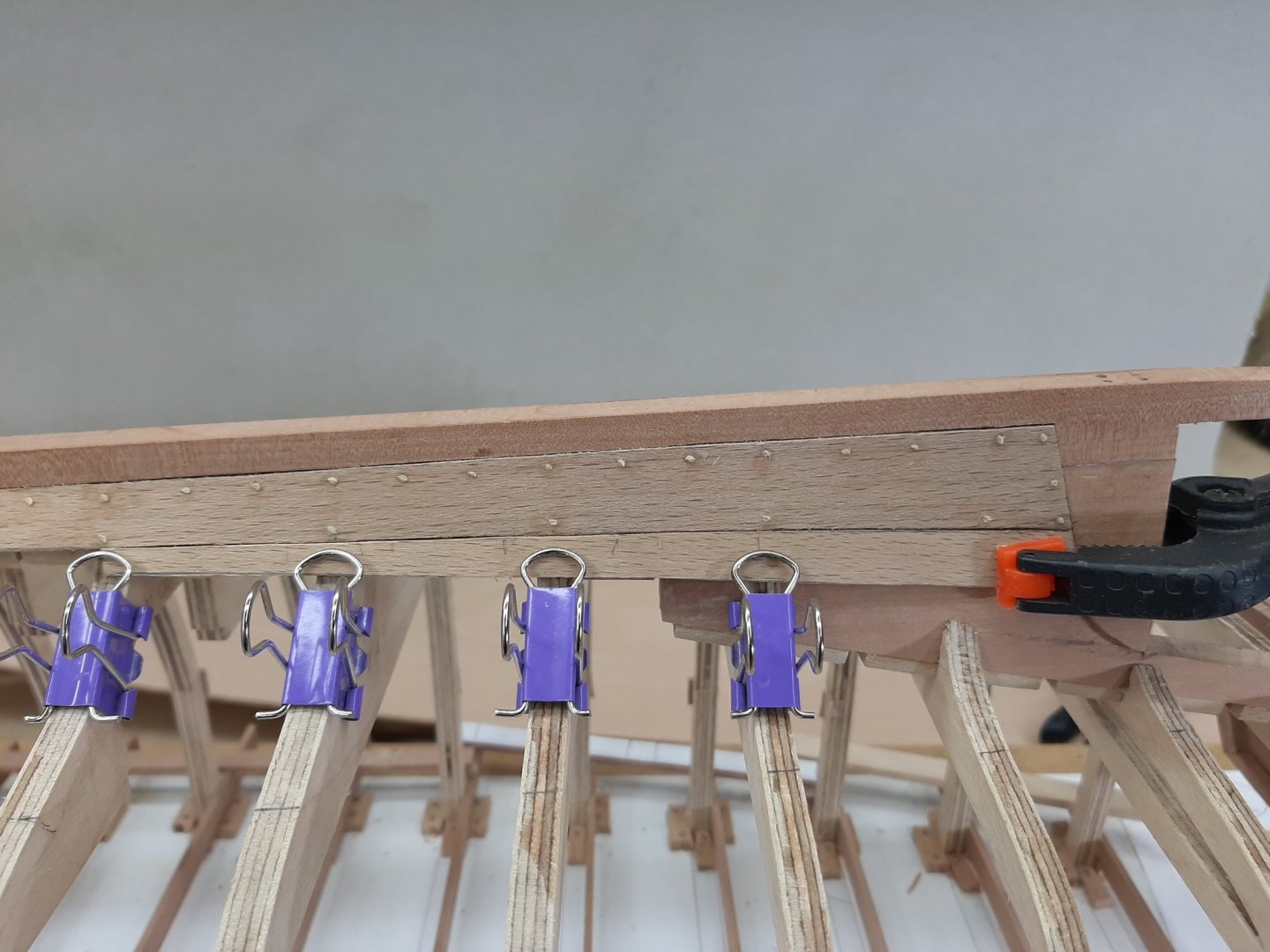
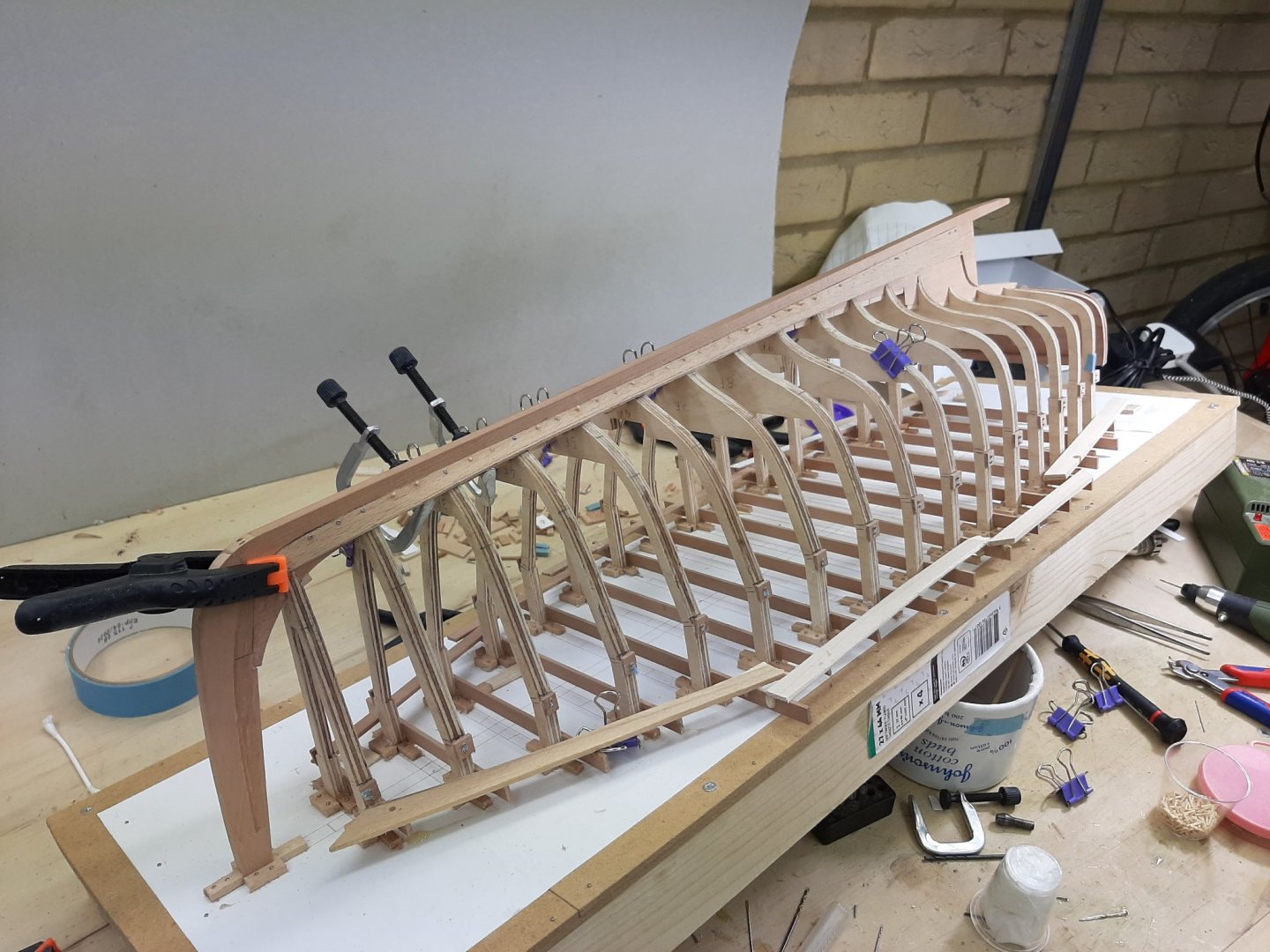
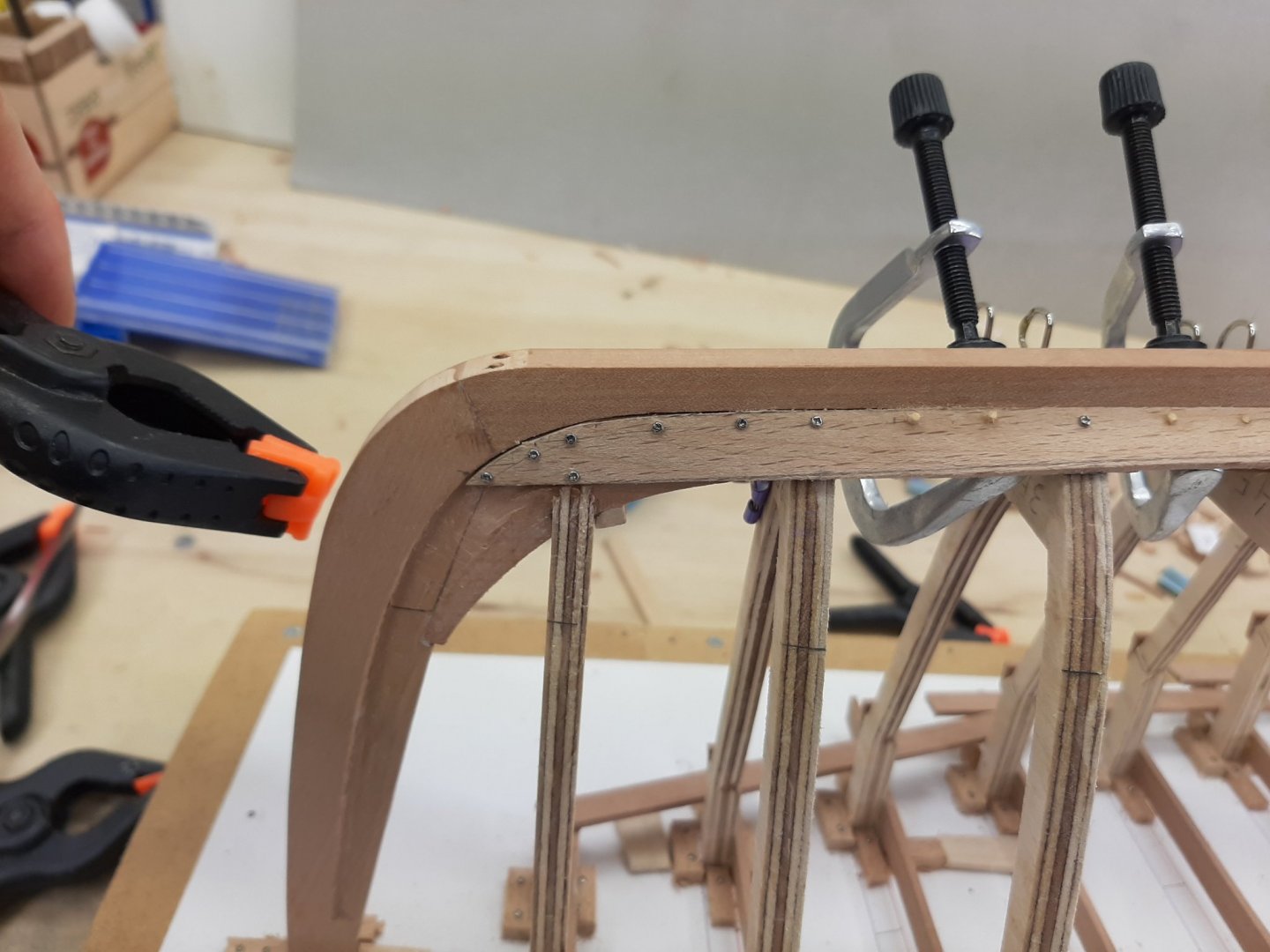
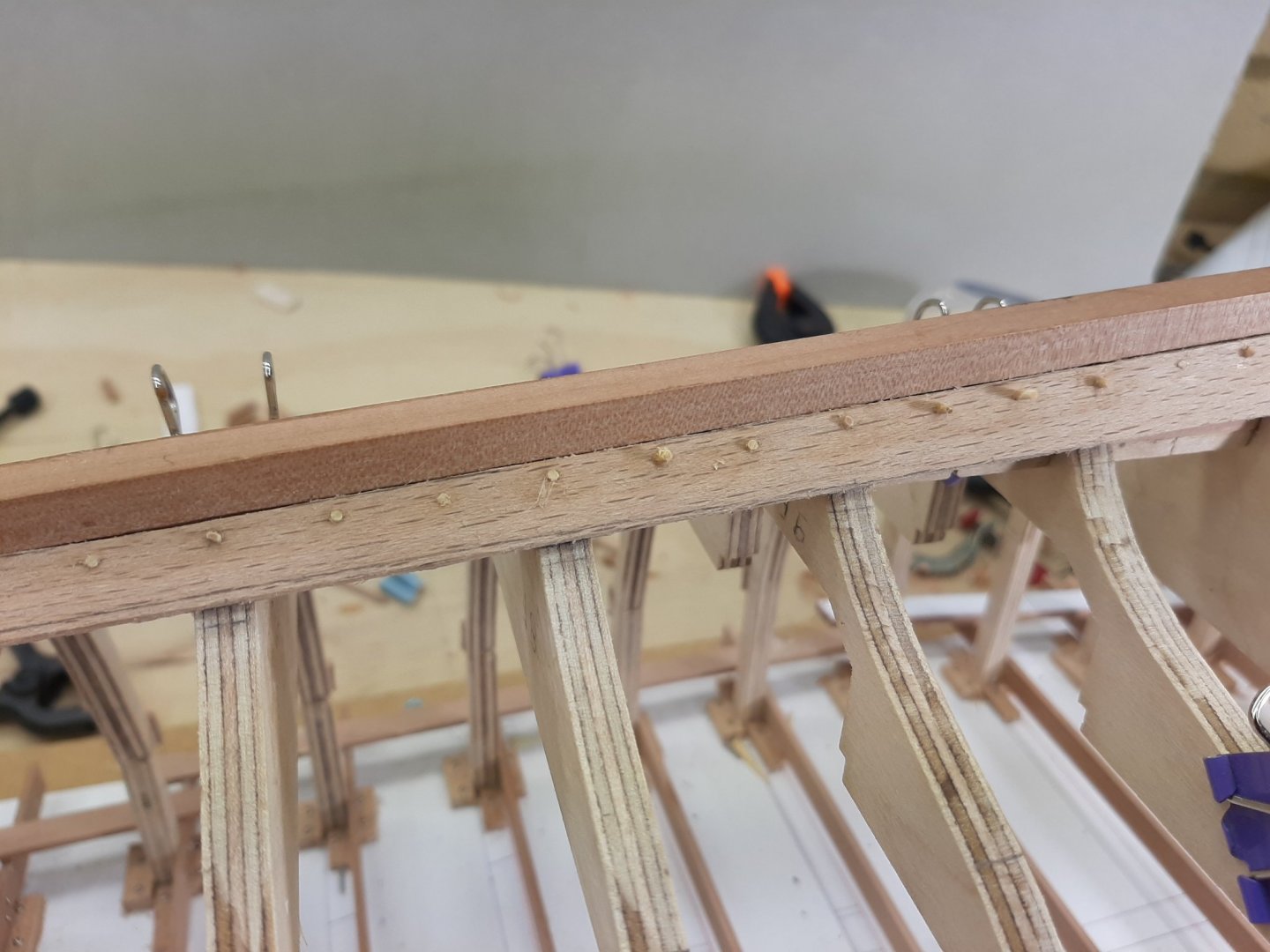
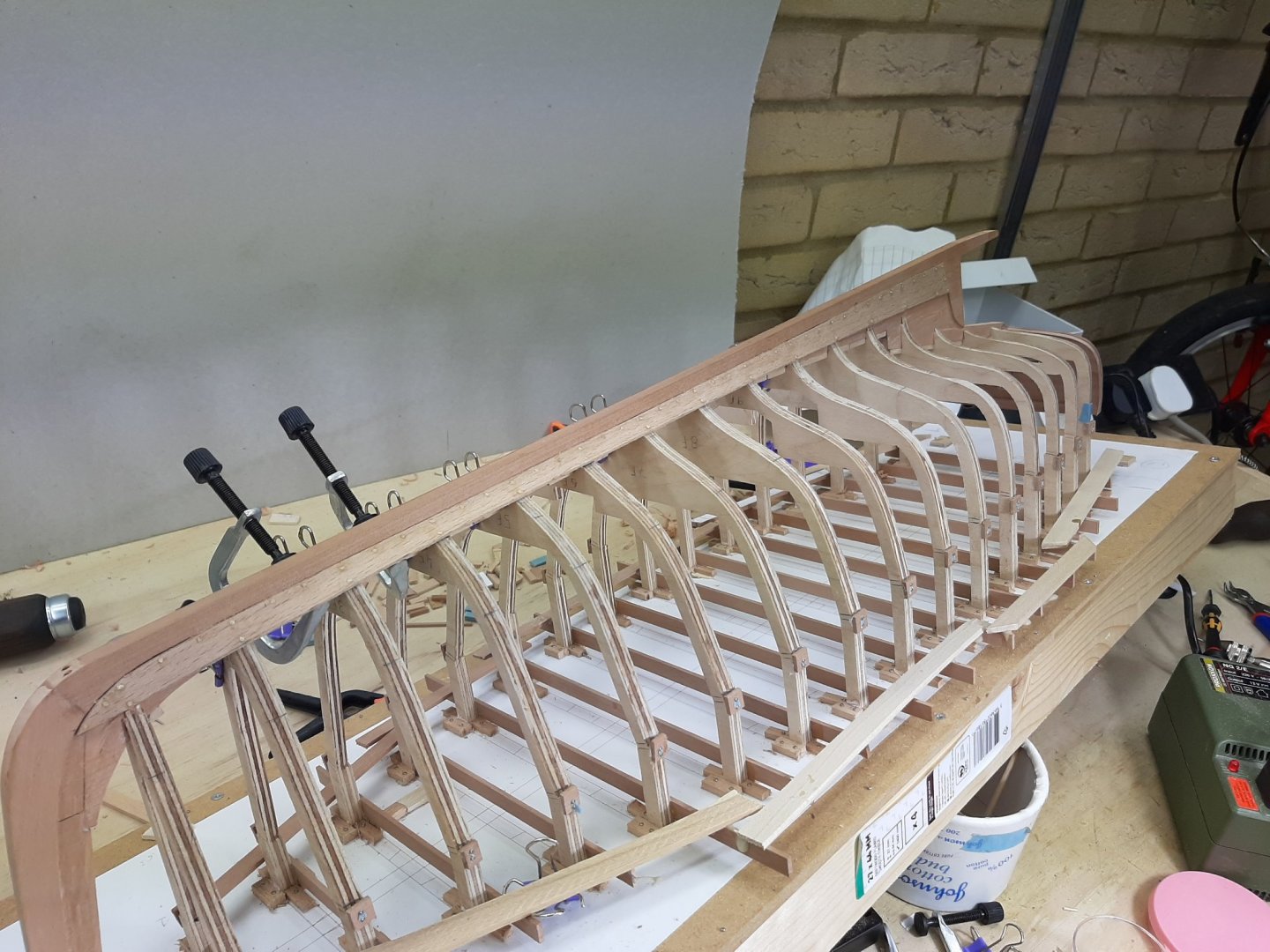
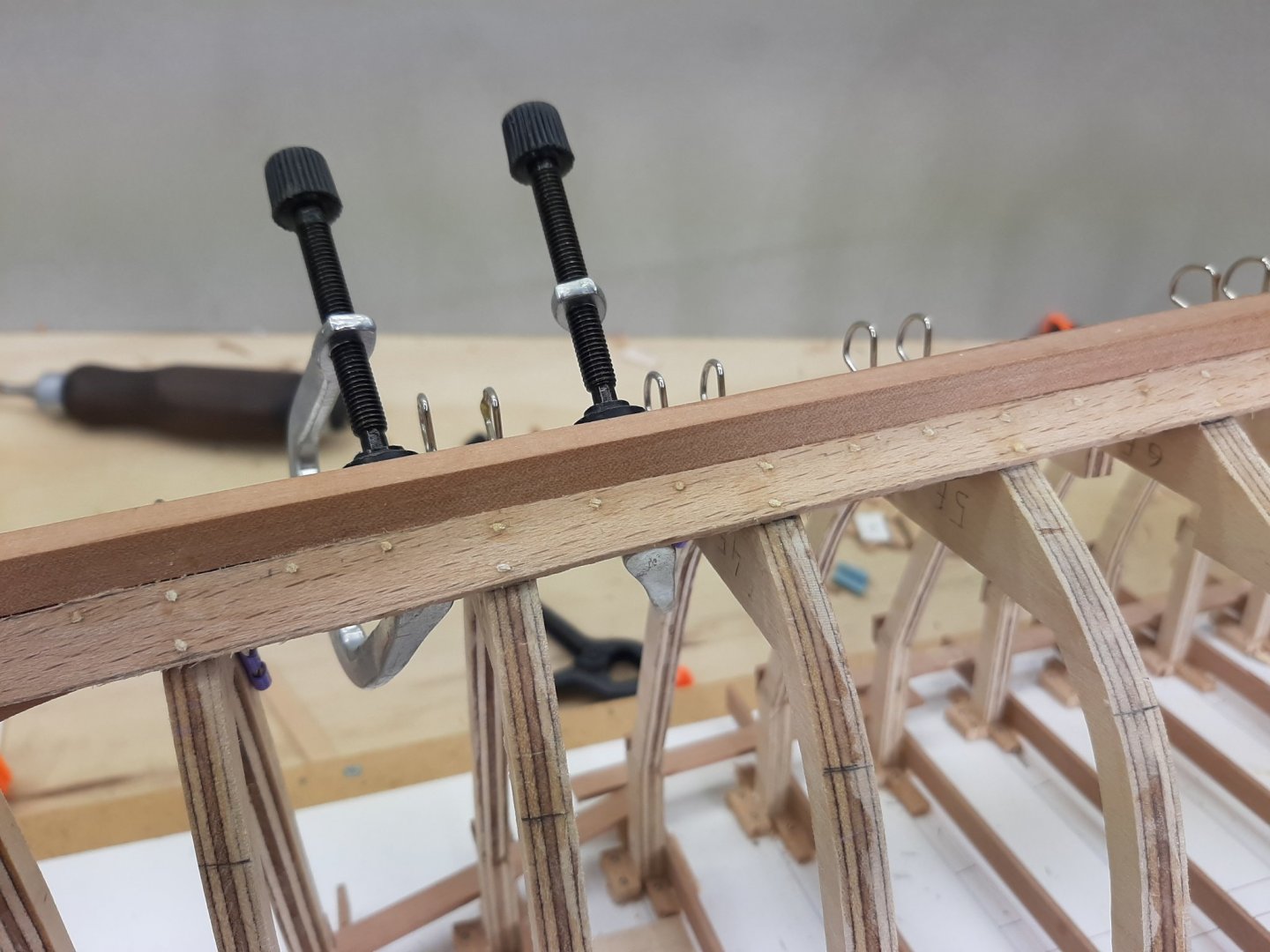
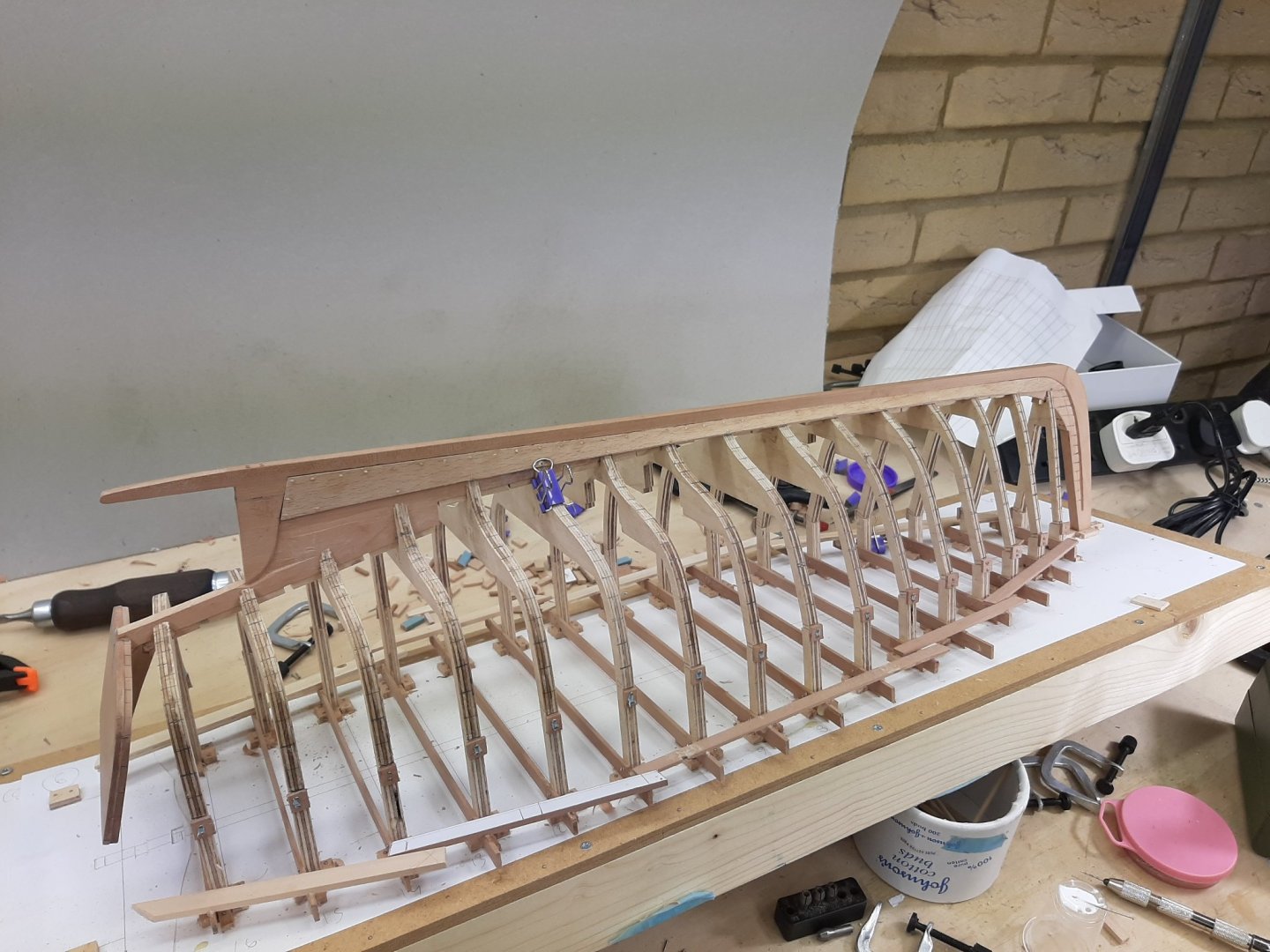
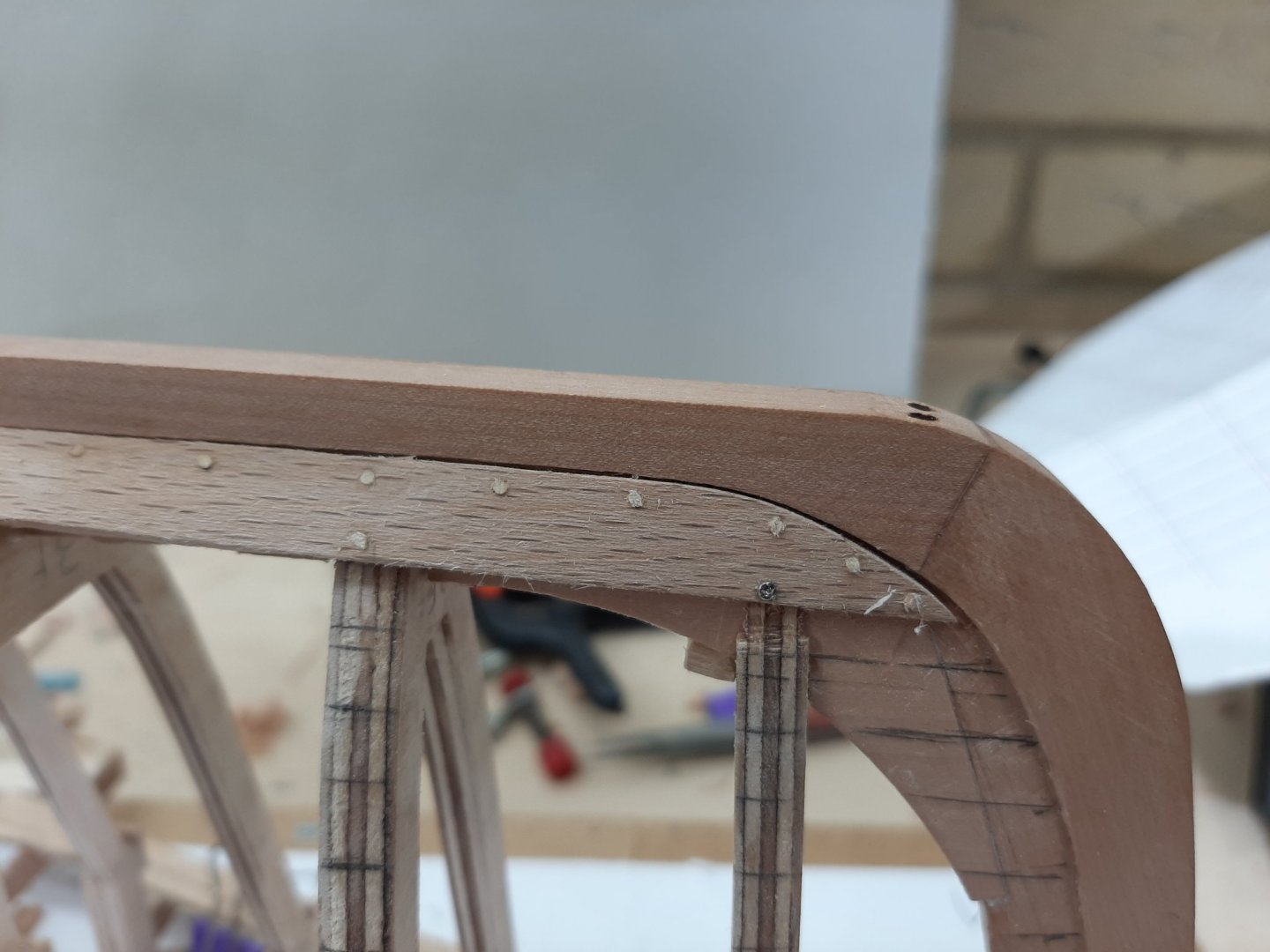
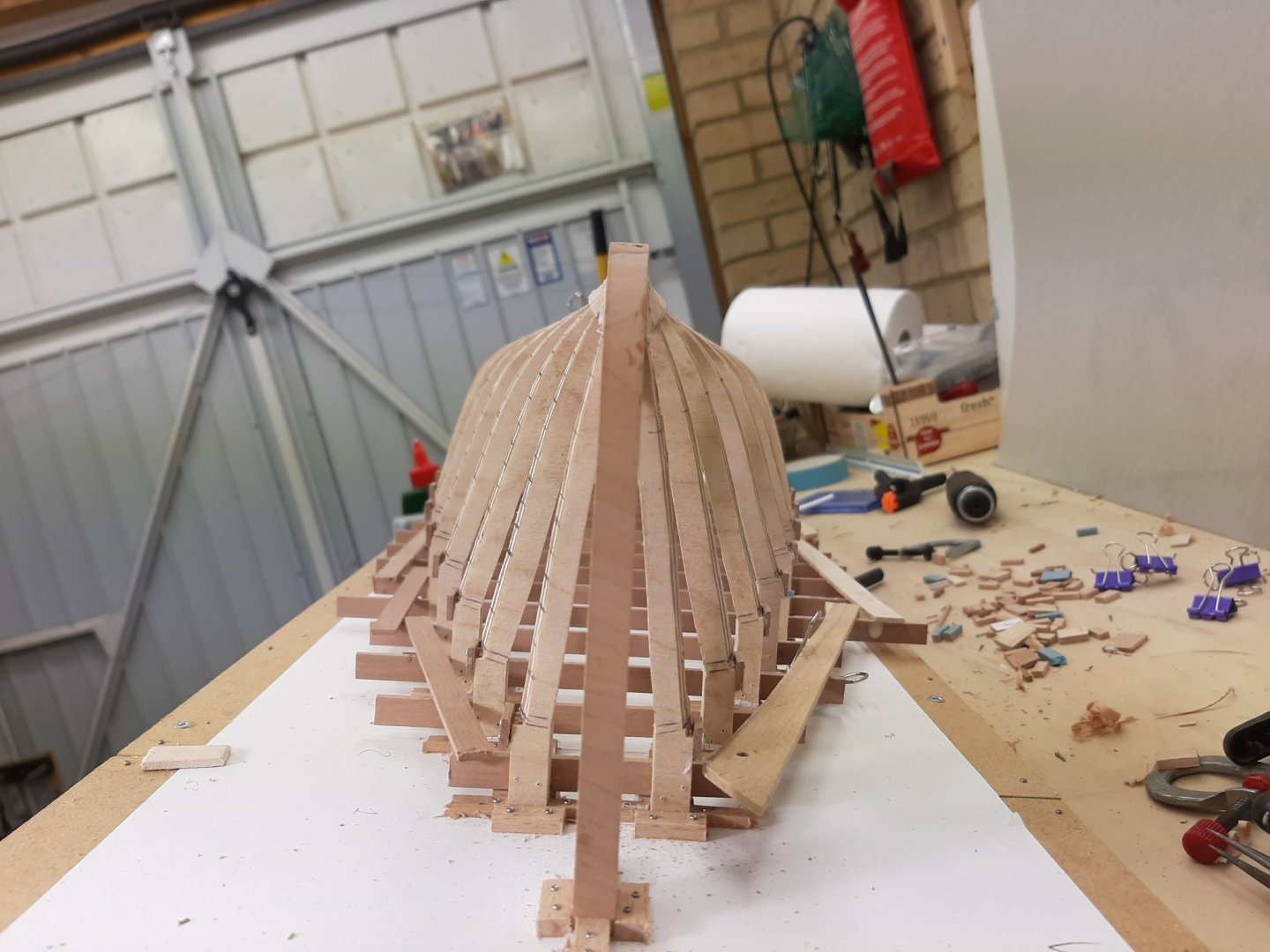
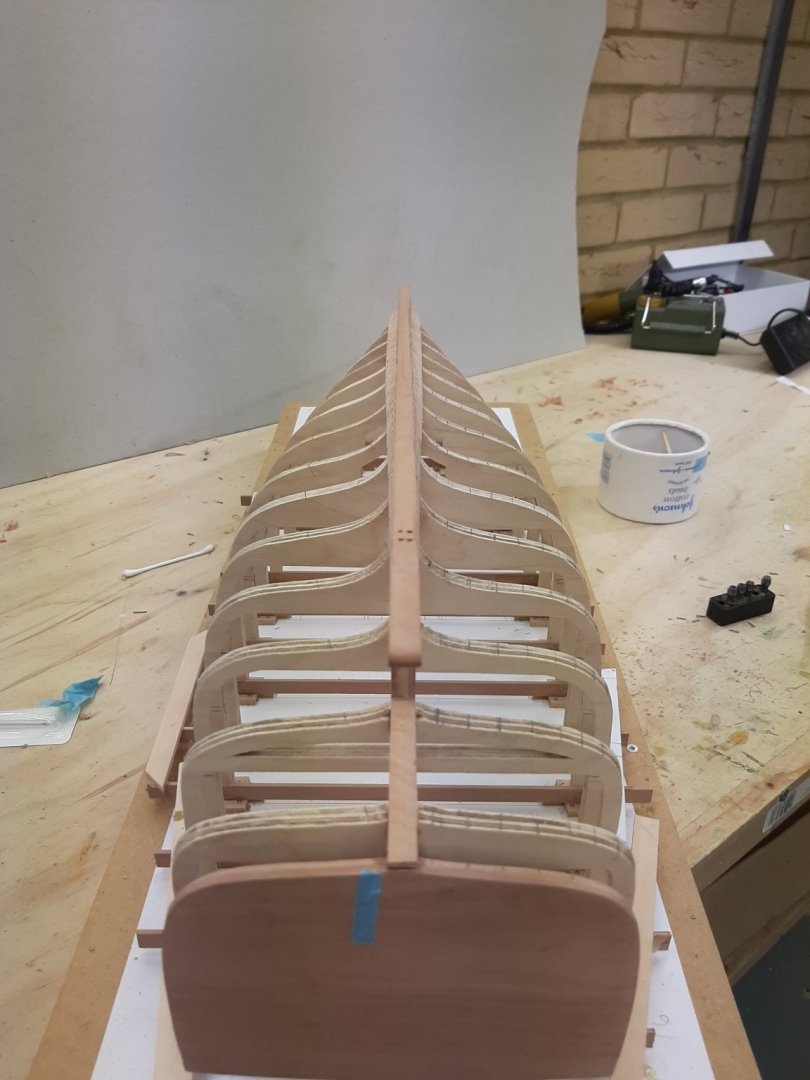

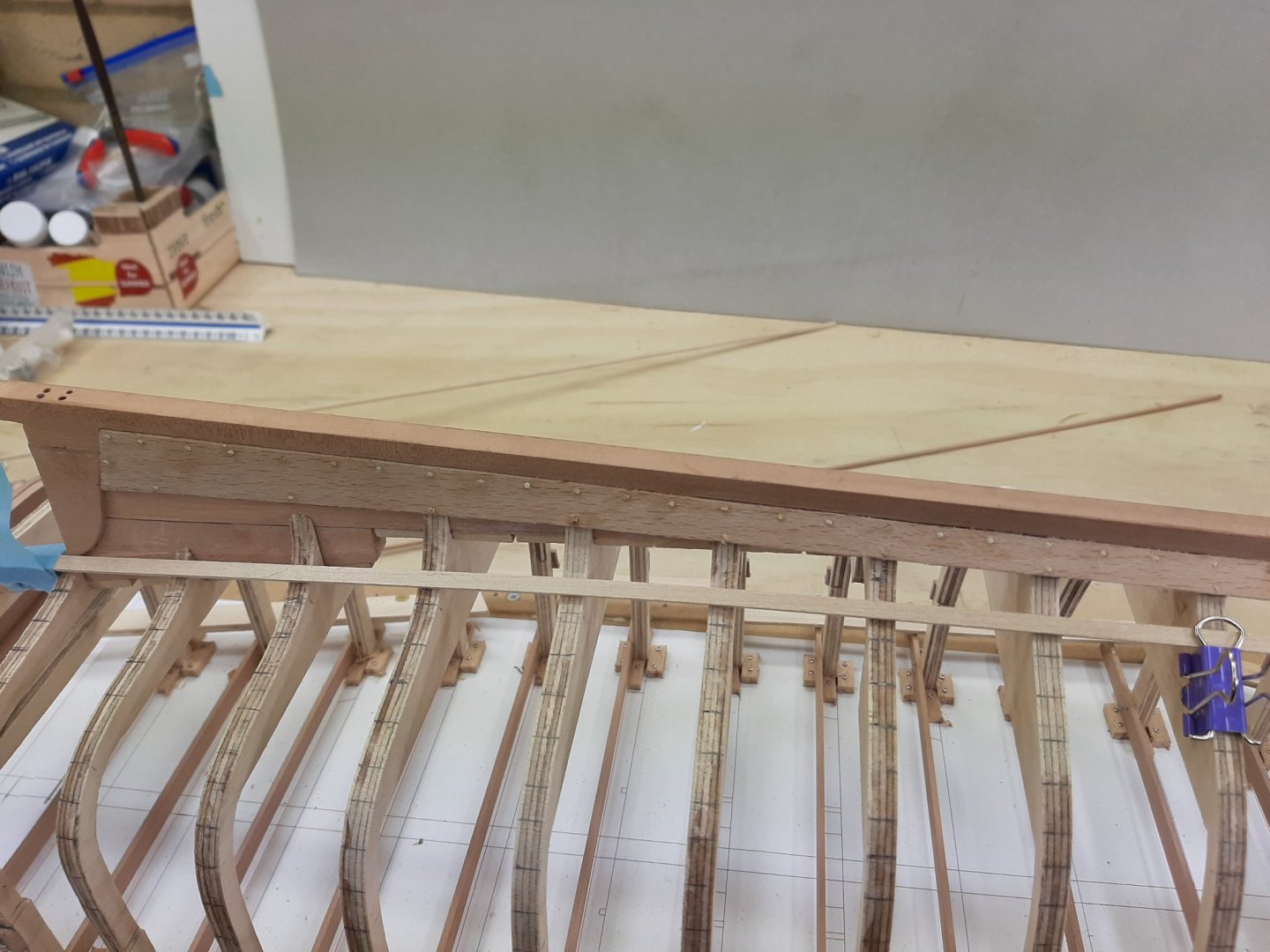
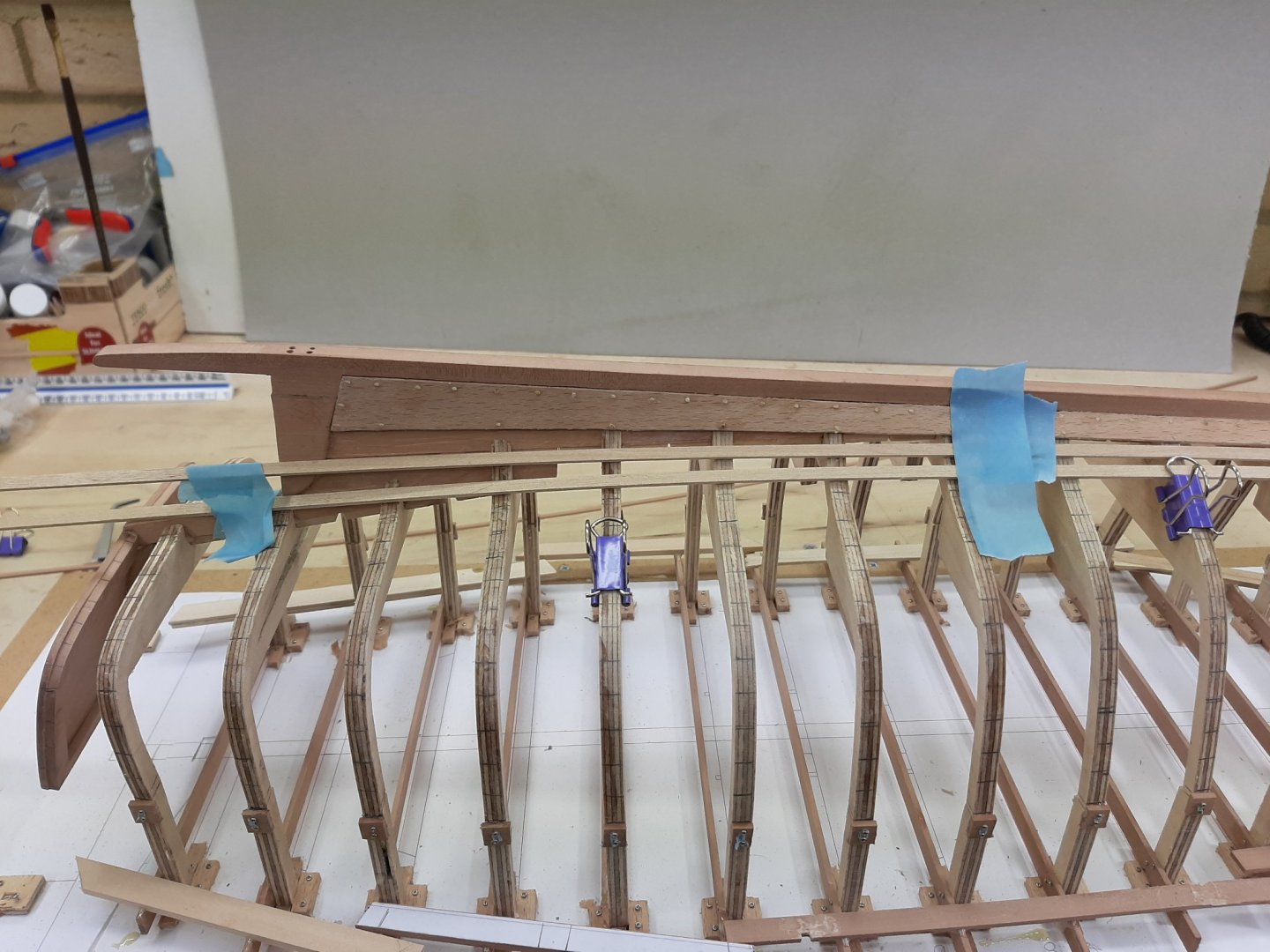

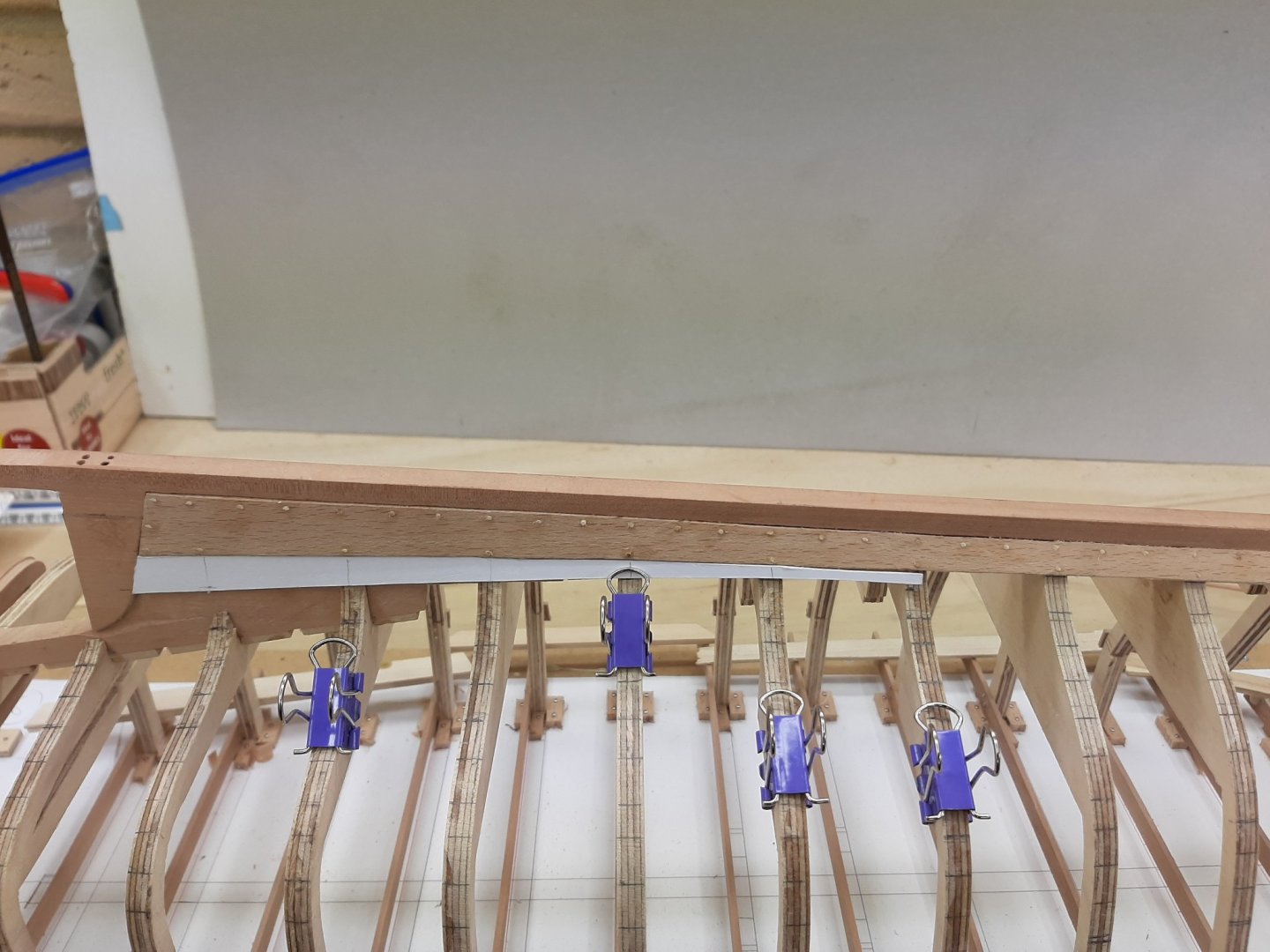
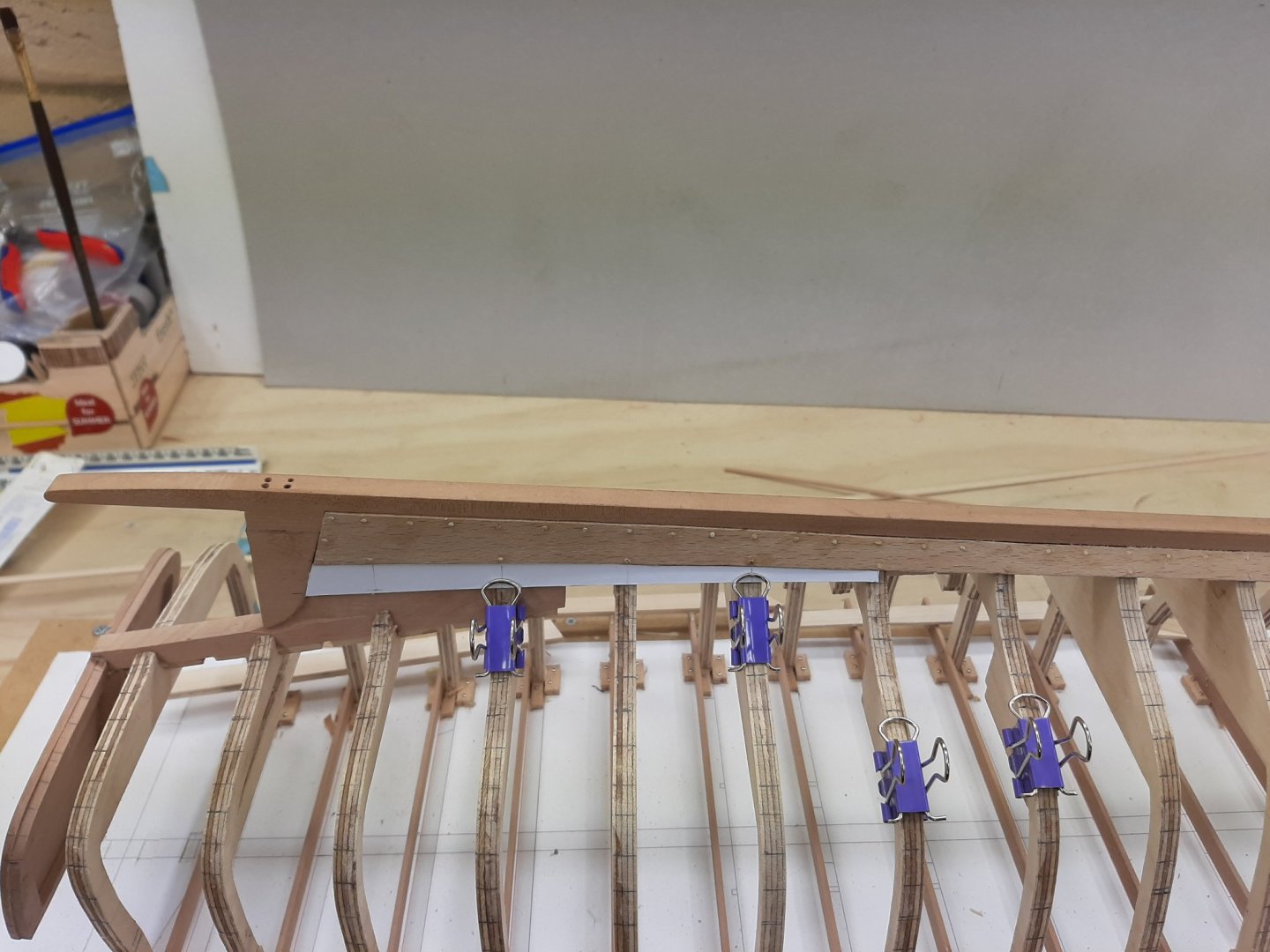
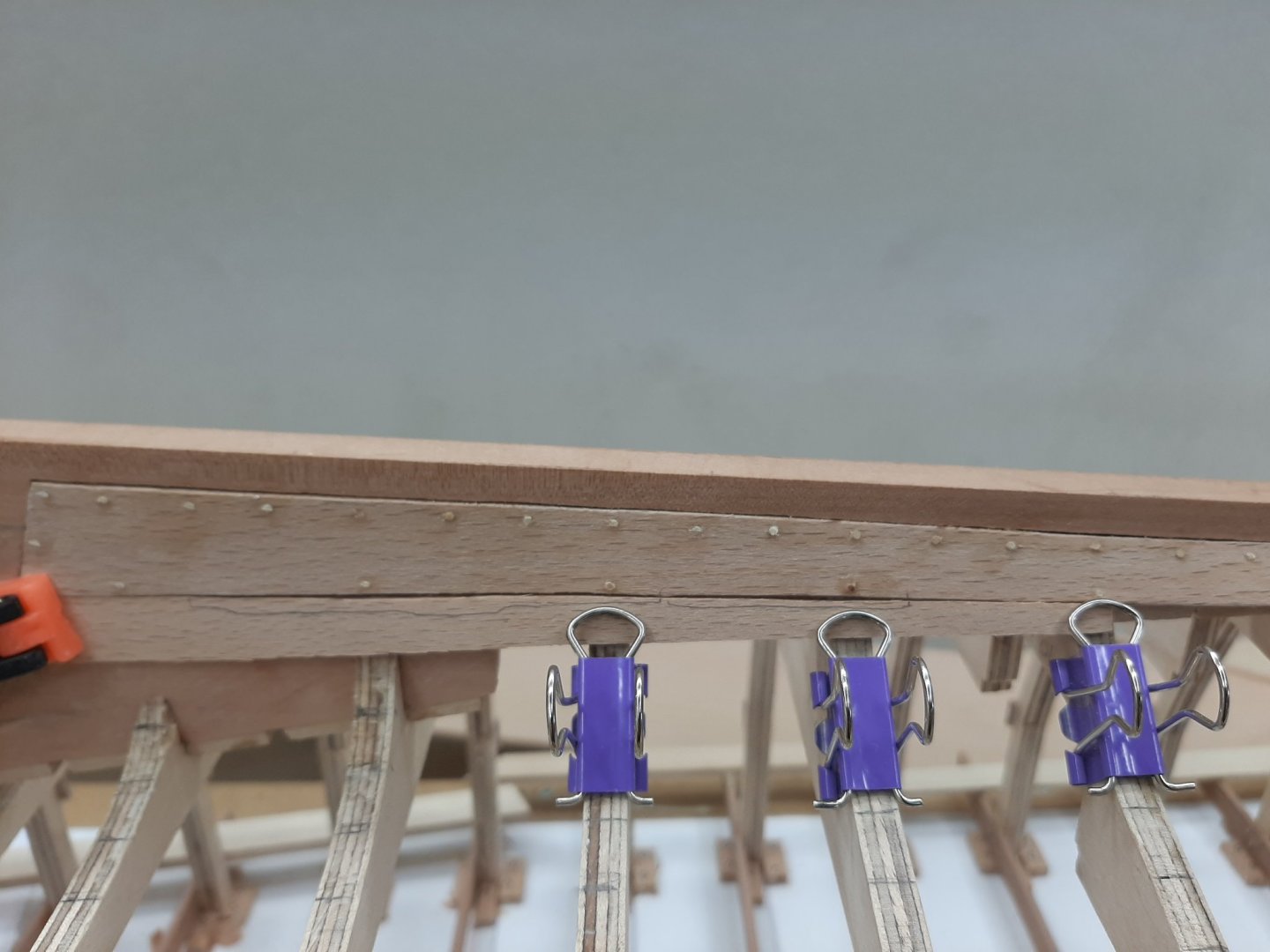
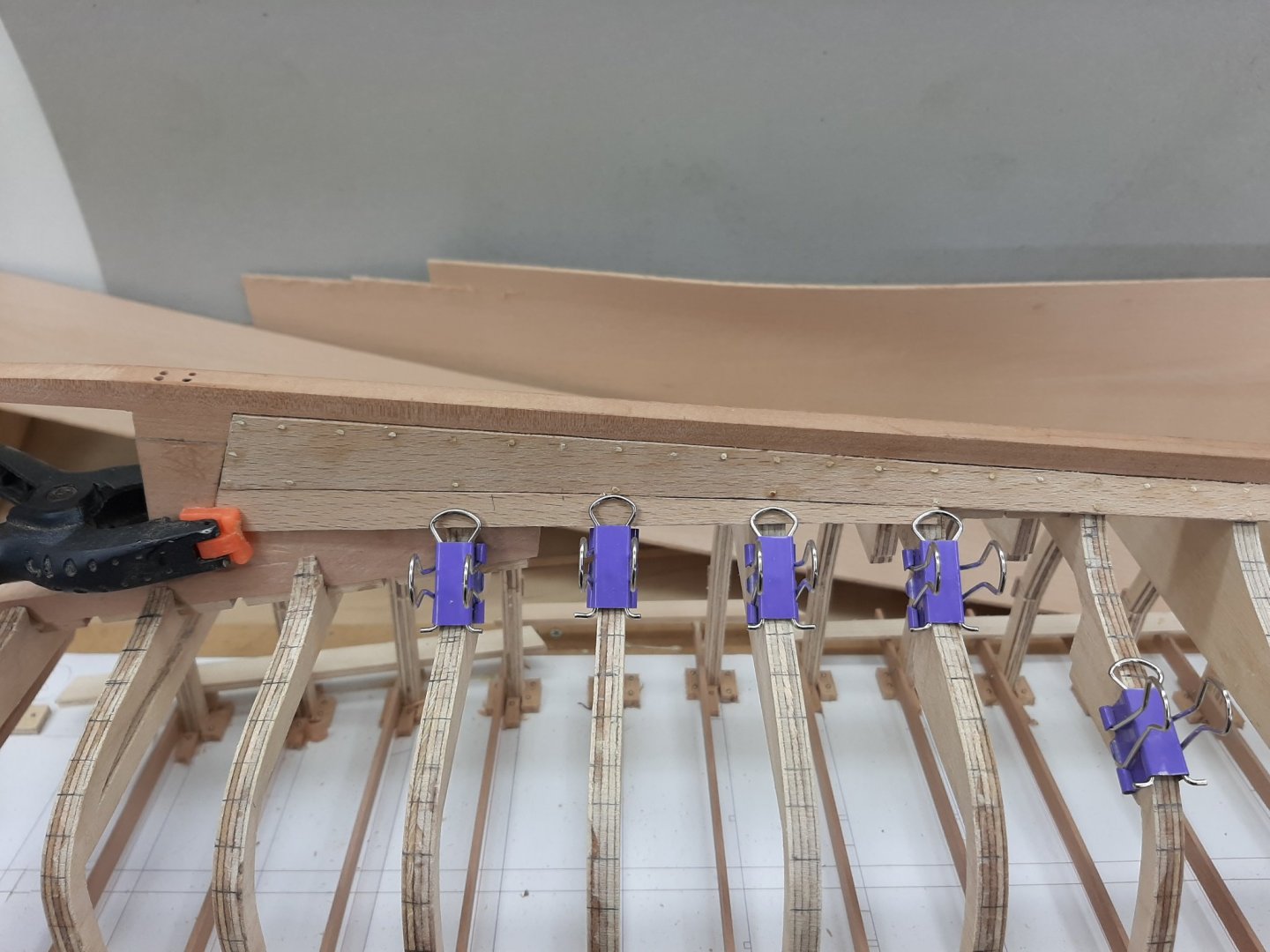
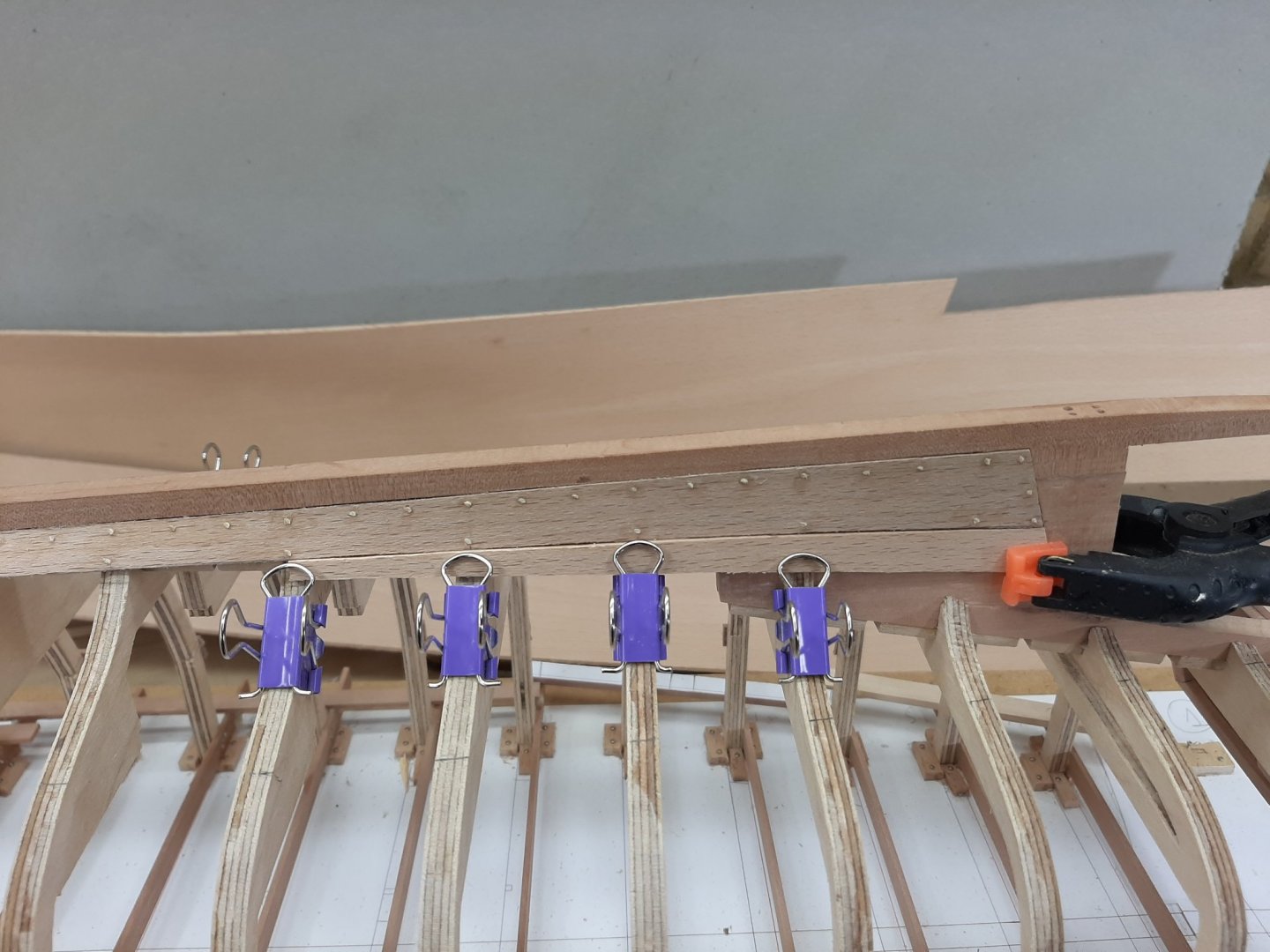
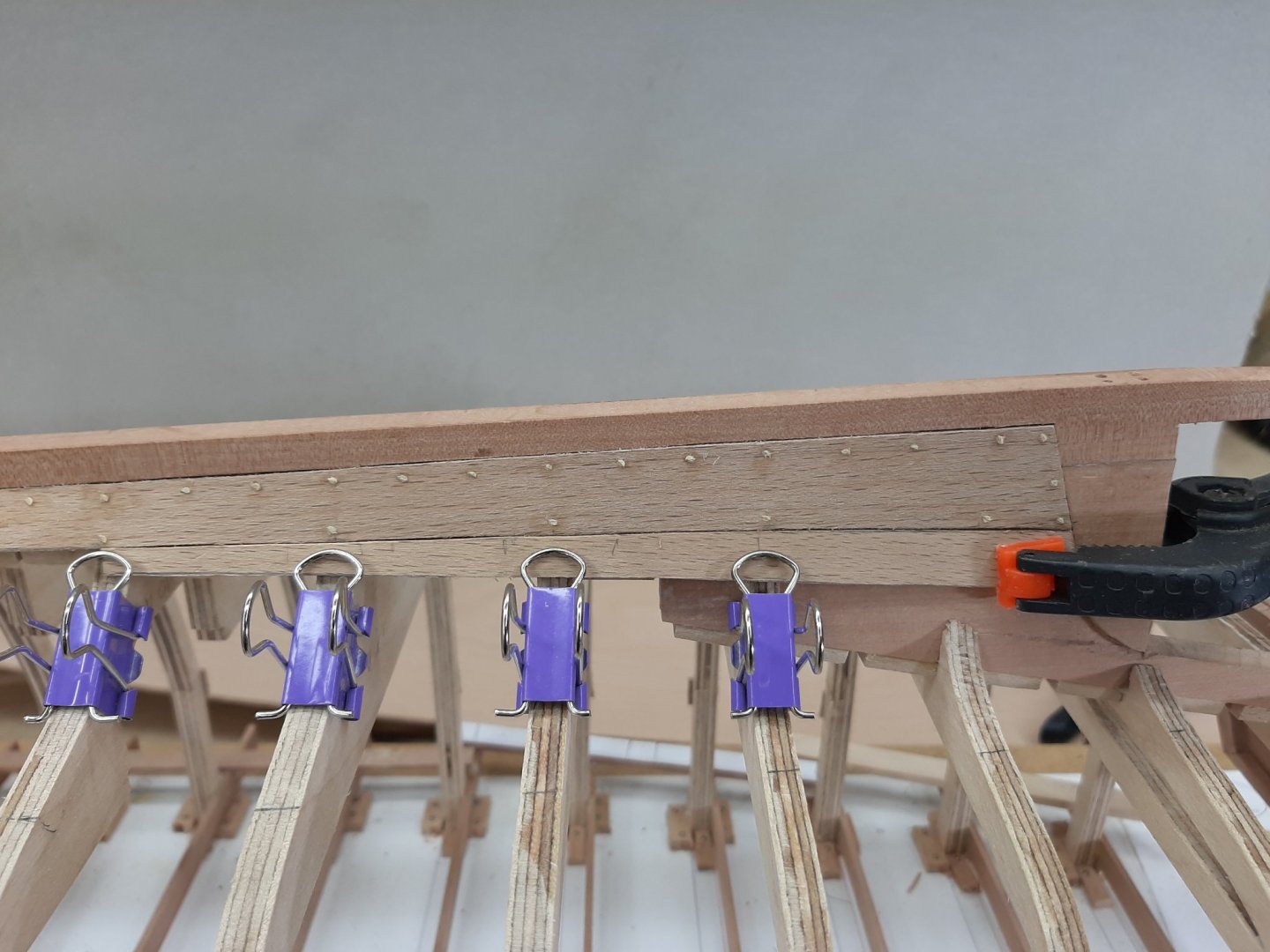
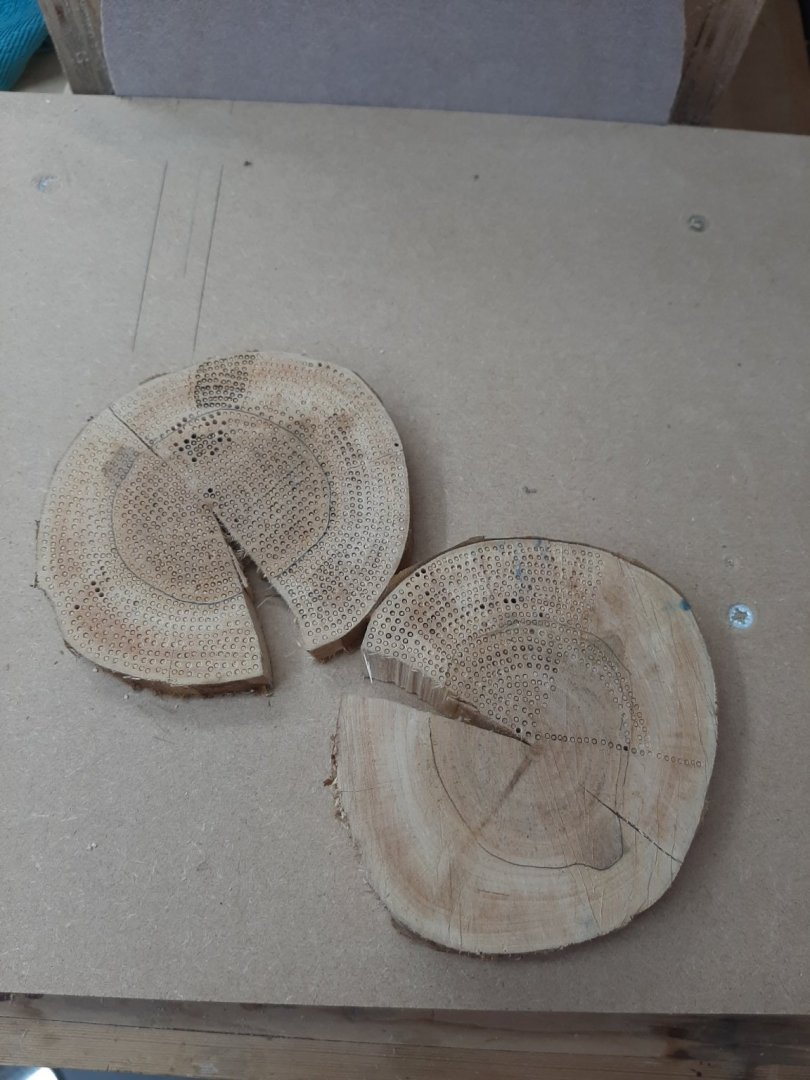
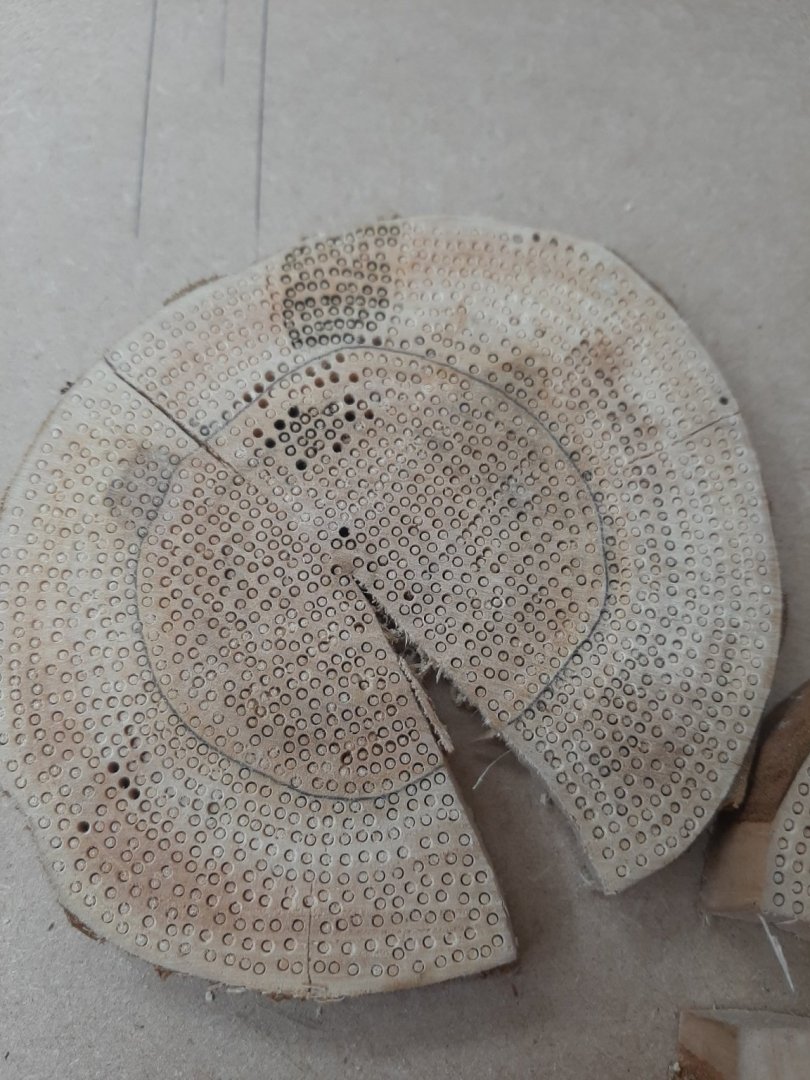
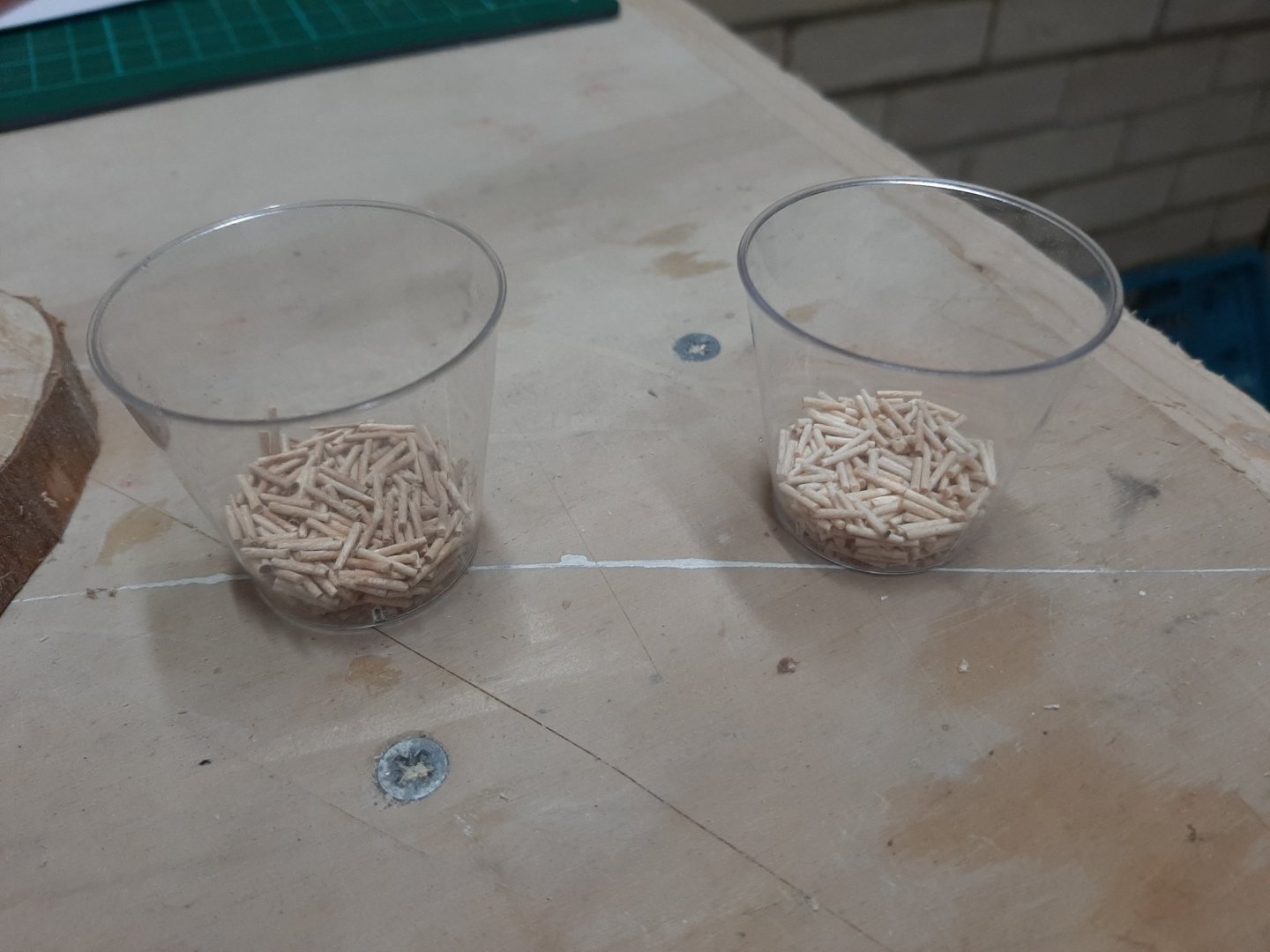
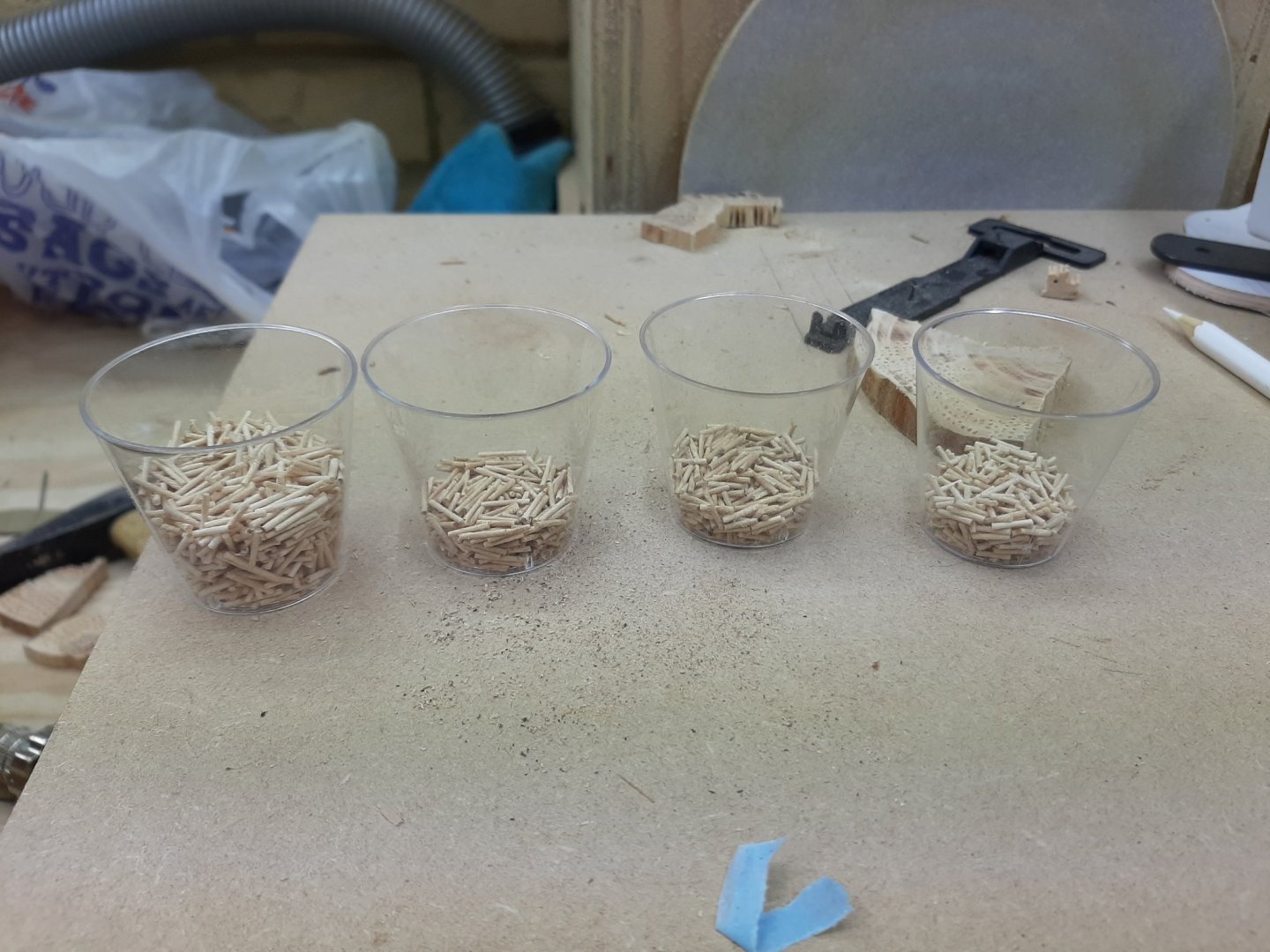
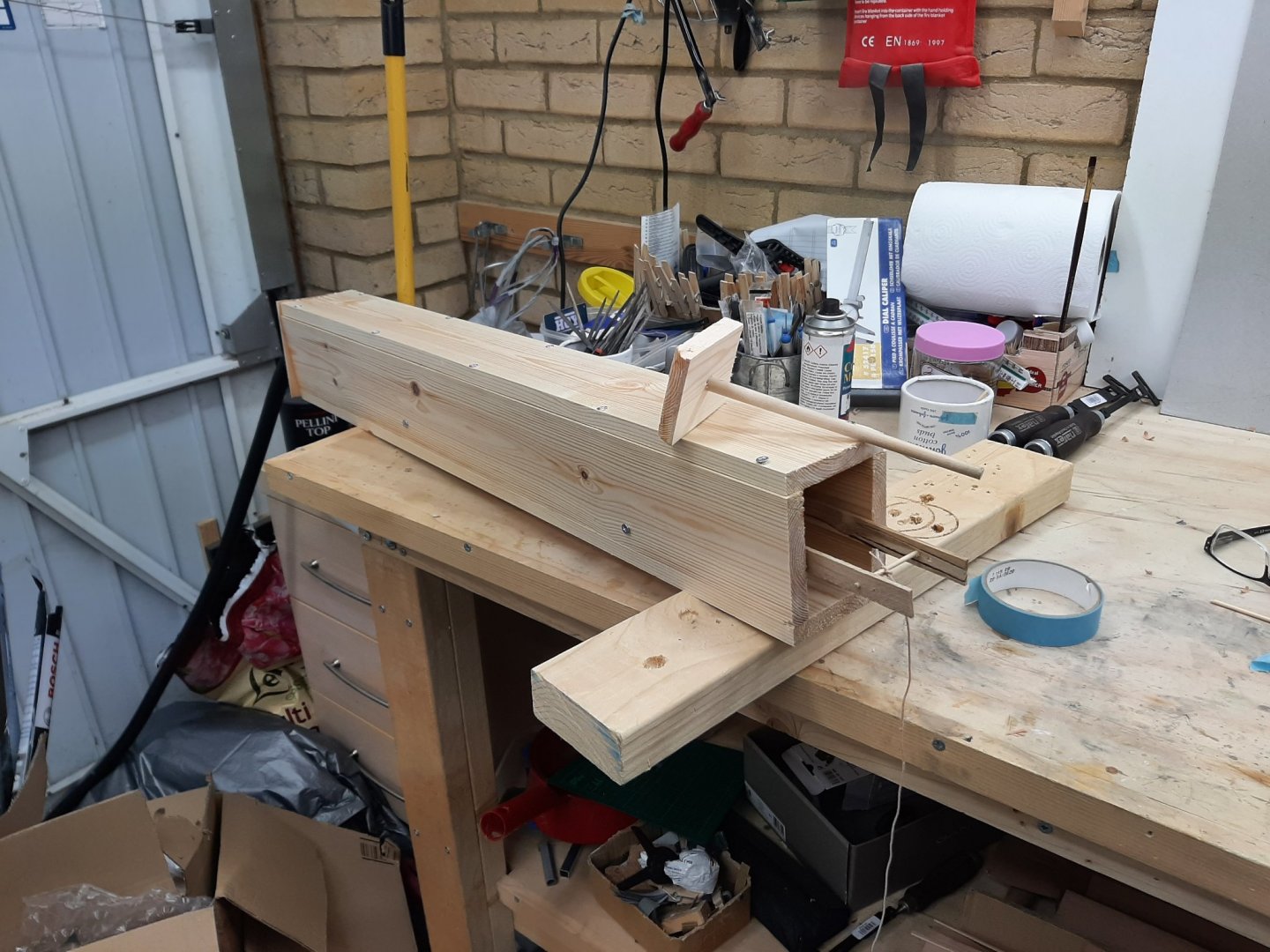
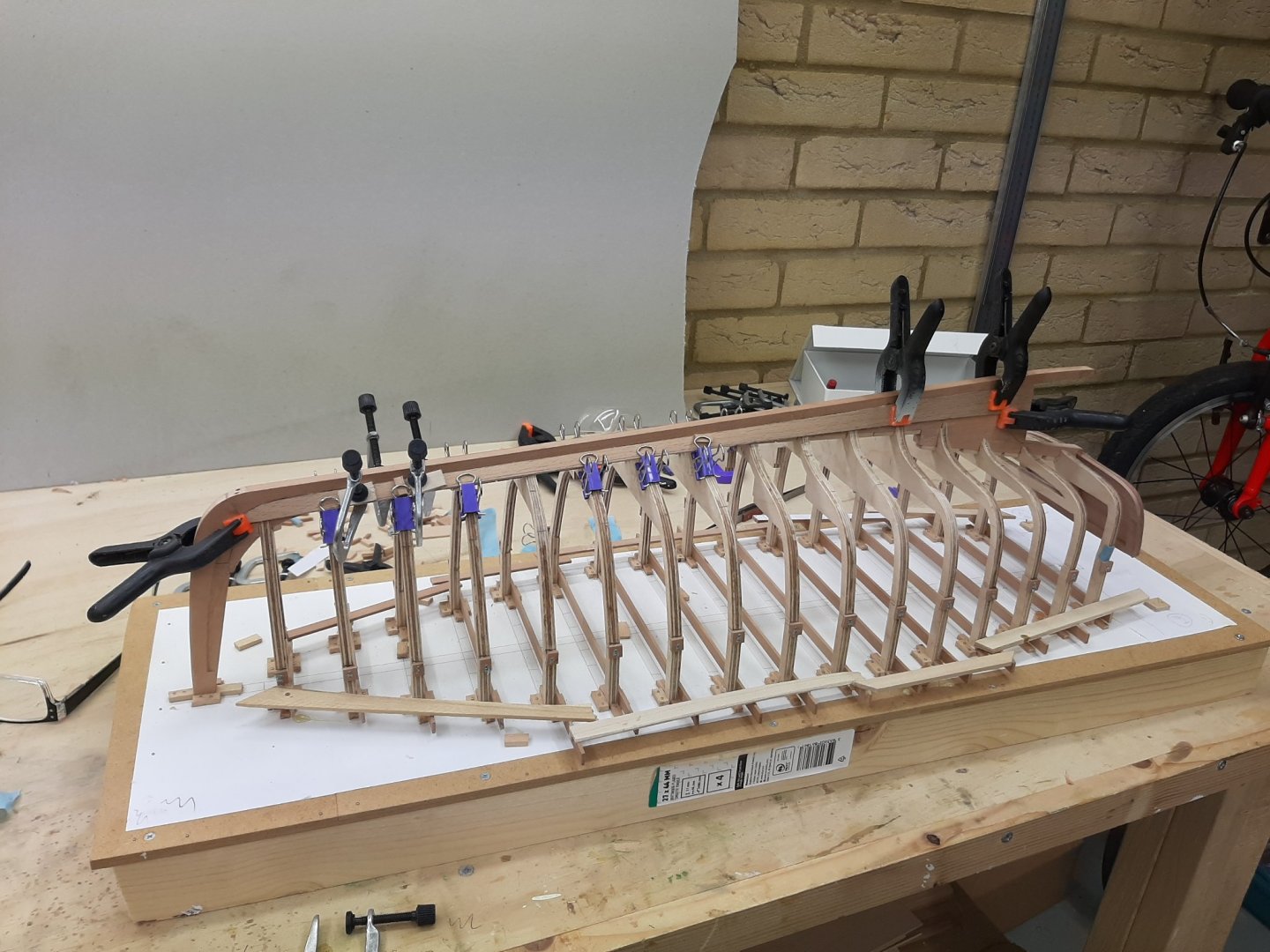
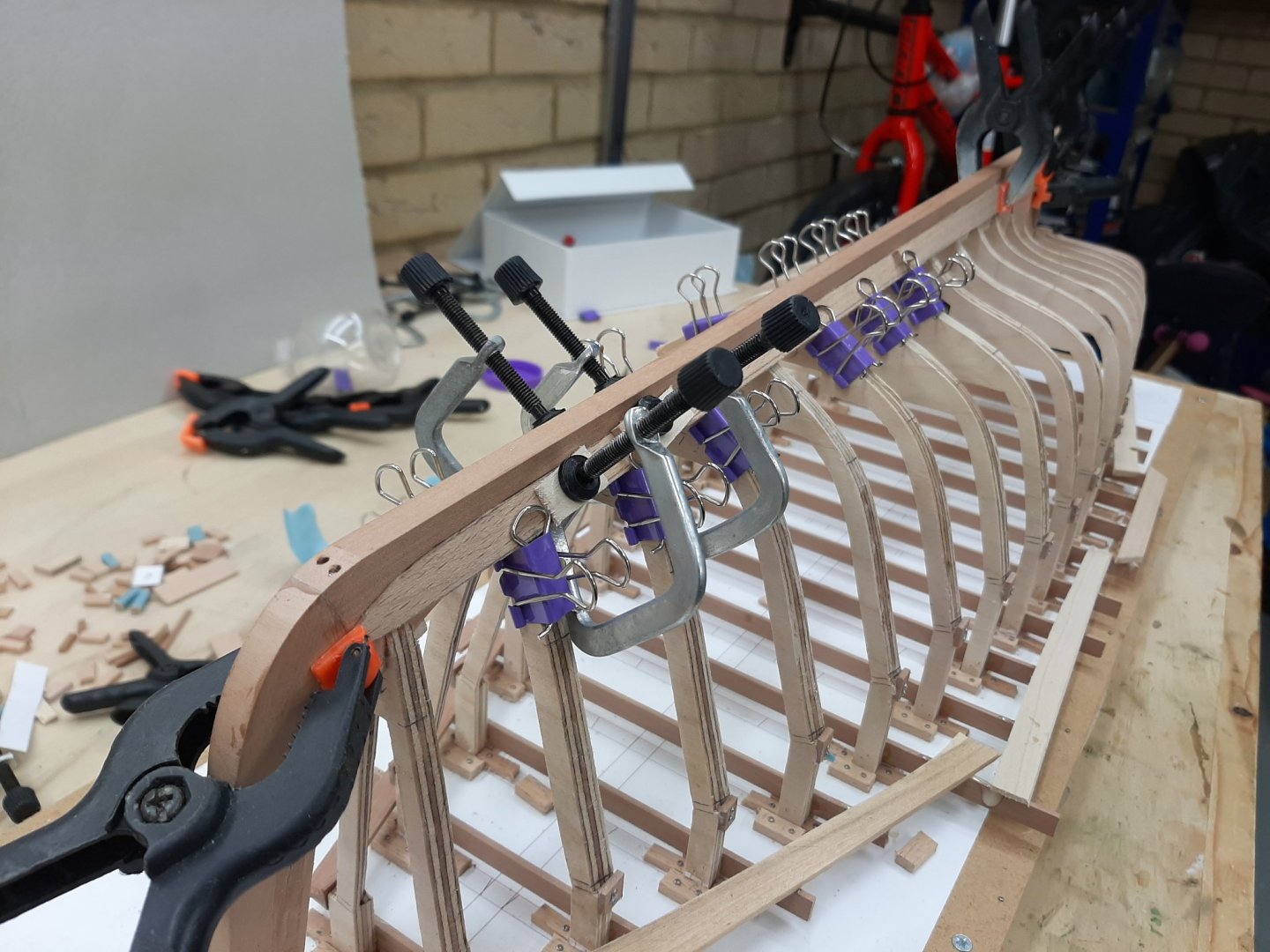
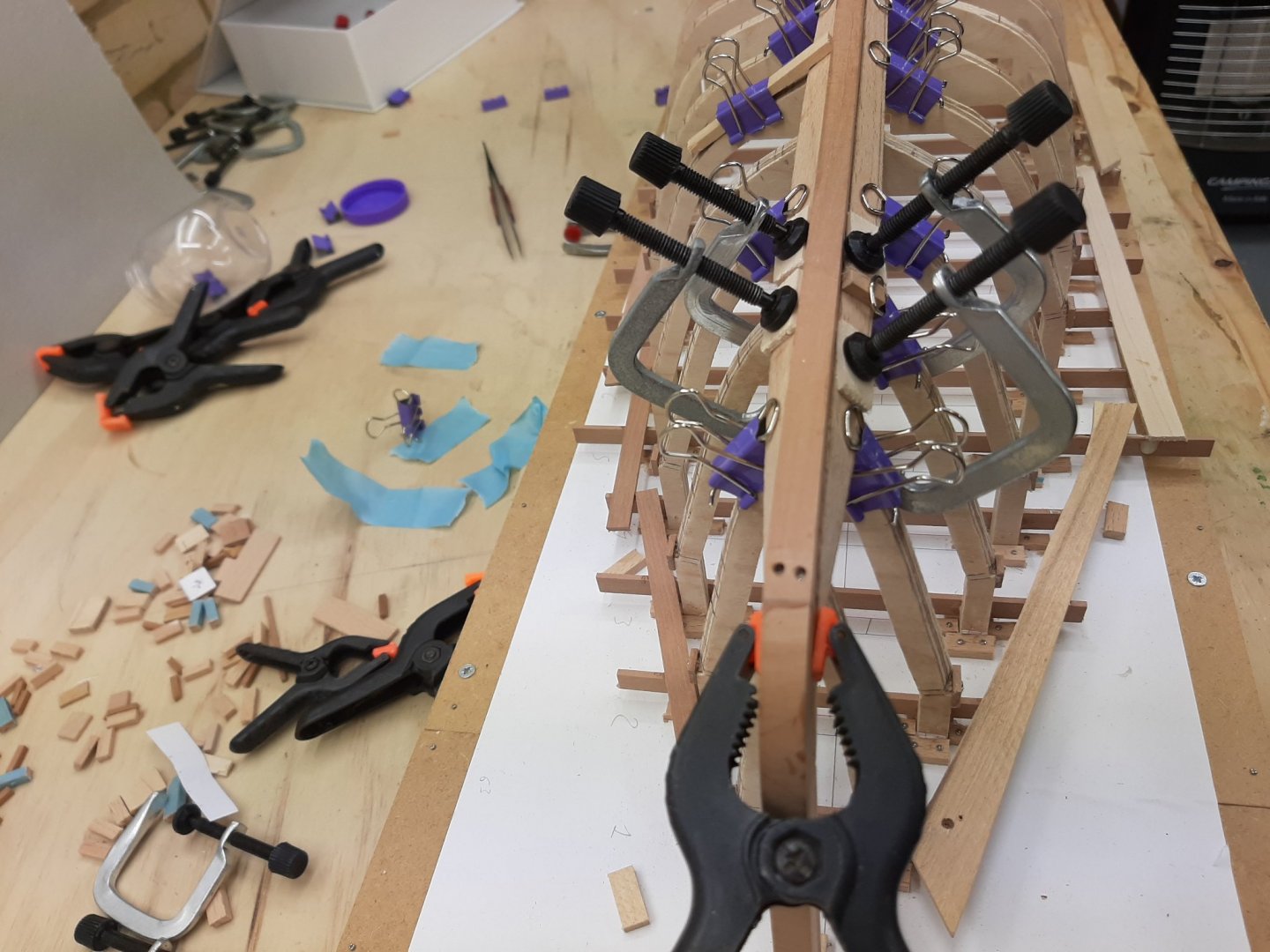
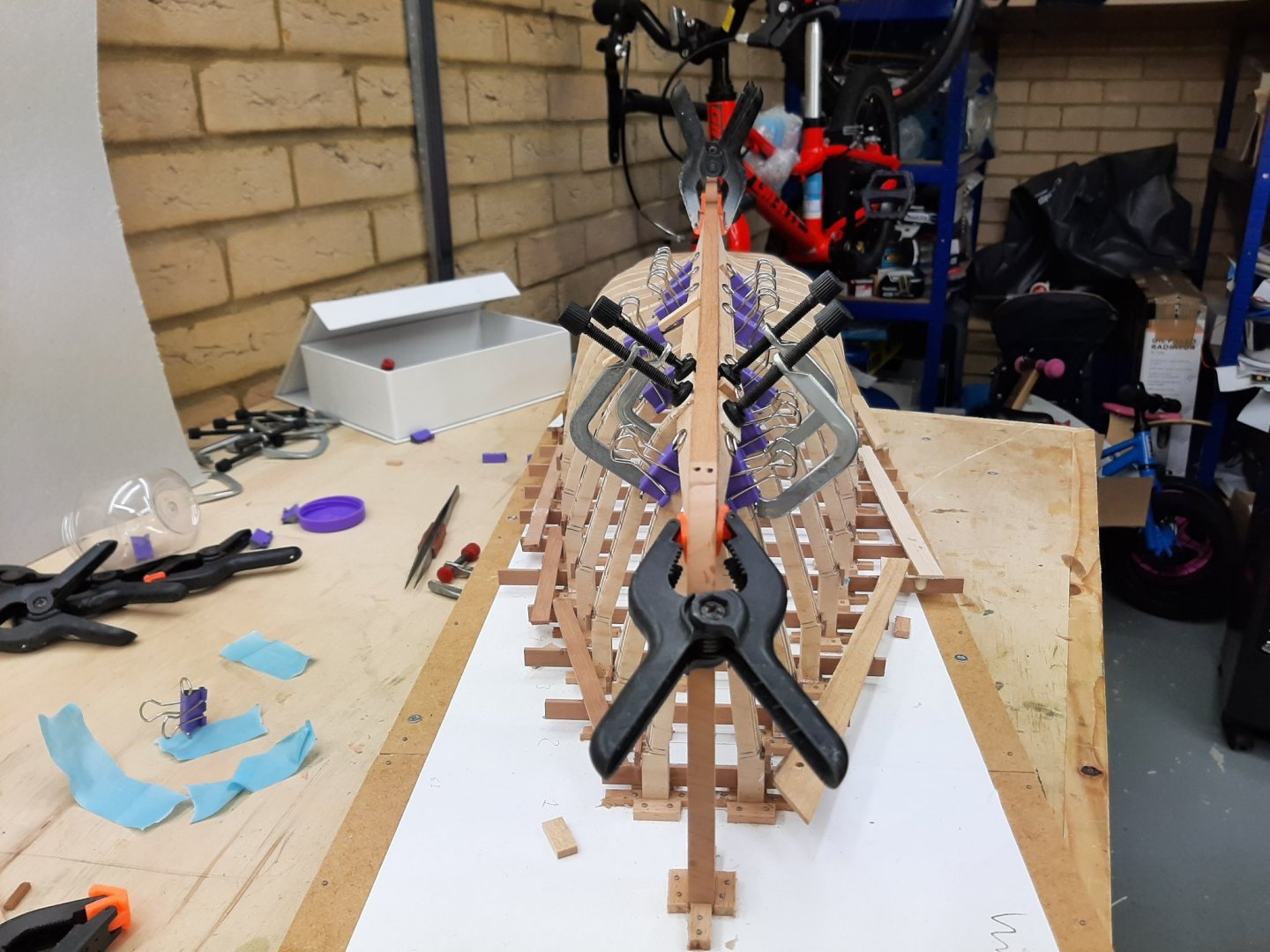
Spilling (very long) planks
in Building, Framing, Planking and plating a ships hull and deck
Posted · Edited by vaddoc
Dear all
As I am currently immersed in planking, I thought it might be useful to share my way of spilling planks.
In my fishing boat log I have presented in detail the way the plank run can be defined but it is a long and difficult read. Showing how to spill planks is much easier and perhaps will help some builders.
So lets spill a plank in the fishing boat. T he positions of all planks have been marked on the port side and these positions will need to be transferred over to the starboard side as we go along. The planks should be twins but in reality they never are, at least in my boats so every plank needs to be individually spilled.
A good compass is needed, this is the one I use
The plank we will be making will be a starboard plank, its sister plank on the port side is already installed. A picture is a thousand words: This is the port plank steamed in place and the markings for all the rest of the planks are visible. We need to make this plank for the other side.
Now, every new plank will have two edges. The bottom one that meets the previous plank, and this needs to be shaped so it fits well, and the upper free edge that we will define ourselves based on our markings and planning of the planks but needs to be as fair as possible.
I use either very stiff card or thick cardboard to make templates of the bottom edge. I cut pieces as long as possible, hold them close to the edge of the previous plank and use a compass to mark the pattern. I run the compass along the piece of cardboard with the needle on the edge of the previous plank and the pencil tip on the card. Then I cut on the line with a very sharp knife and repeat on the next segment. I glue and connect the pieces into a long continuous card pattern. This is how it should look.
This is 1:10 scale and this plank is 60 cm long. The card needs to lie comfortably without absolutely any edge bend. Even a tiny strain on the card will produce huge gaps on the other end of the plank and wood will not tolerate edge bending (It will, but only a little). This is the most crucial step, if there is any doubt the template must be readjusted. This particular template was the third one. Do not make the card pieces too wide because the angles will change and you ll be getting constantly erratic results.
Then, mark the positions of the frames on the card pattern.
Then, very carefully, making sure there is no edge bend at all, secure the card pattern on the wood sheet.
Run a pencil (I use 0.3 mm mechanical one) along the edge and also mark the positions of the frames. This is the result
This is the bottom edge of our plank and should fit closely to the previous plank. We need now to define the upper edge so we need the thickness of the plank at the various frames. On the port side, this thicknesses are already marked. To make sure that the two sides are as similar as possible, I ve been marking the starboard side measuring from the sheer.
So the upper edge of our plank is marked in all frames.
Now, these widths need to be transferred to the plank, again using the compass. The width at the stem will be defined using the contralateral plank end.
All sites marked.
These points need to be connected but with a fair line. To do this we must use a baten, arranging it so that it is close to all the points.
Now this line, which is the upper edge of the plank, does not pass through all the points but it is ok. Actually, if we put the contralateral plank on the pattern, the widths are exactly the same!
On this boat I use a very sharp knife to cut the plank with multiple passes, breaking off a segment of the blade every couple of passes. After careful cutting to the lines, the plank is produced.
Placing the plank on the boat, it does not fit well.
No need to panic, it just needs a bit of micro adjustement. We need to find the high spots and carefully sand them so the gaps will start closing. These are the high spots in this case.
After sanding and with a bit of edge bending, the plank seems to fit fine now.
These micro-adjustements and a bit of edge bevelling can continue until the fit is very close but for this boat this is enough, with some filler it will be fine. I also lightly sand the upper edge to smooth out the peaks and make fitting the next plank easier.
Both planks steamed in place.
And that's it! Now repeat the process 30 odd times and planking is done.
Vaddoc